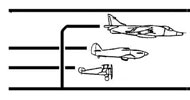A diary of Sopwith Aviation Company activities through 1915
Sopwith factory output during 1914 amounted to 69 aeroplanes compared with 18 in 1913. The remarkable rate of expansion can be seen from the numbers of new machines ex-works almost doubling each six months:-
| To December 1912 | Jan to June 1913 | July to Dec 1913 | Jan to June 1914 | July to Dec 1914 |
| 1 | 5 | 13 | 24 | 45 |
Thirty-six of these eighty-eight machines have not survived into 1915. No Sopwith aircraft has suffered structural failure in the air in service underlining their reputation for quality of design and manufacture. Just one machine has been shot down, four had to be abandoned at Antwerp and two were lost in a mid-air collision. Other losses have mainly come from stalls after take-off, often attributed to loss of engine power, forced landings following engine failures and other landing accidents. Intensive wartime flying often in poorer visibility and rougher weather has inevitably led to more such events, floatplanes being especially vulnerable.
Of the five Sopwith machines sold abroad, there is no news of the Greek Navy ones or of Bleriot or Lebedev flying their “Tabloid” airframes. However, there are these images of the German Navy’s “Bat Boat II” in service.
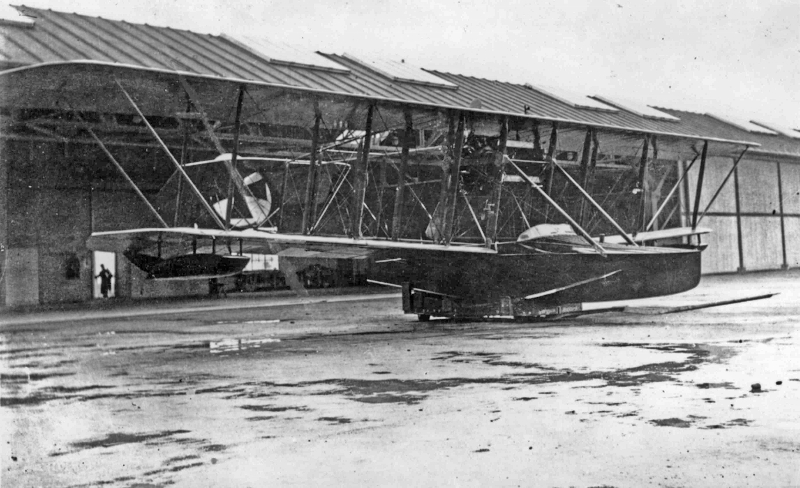
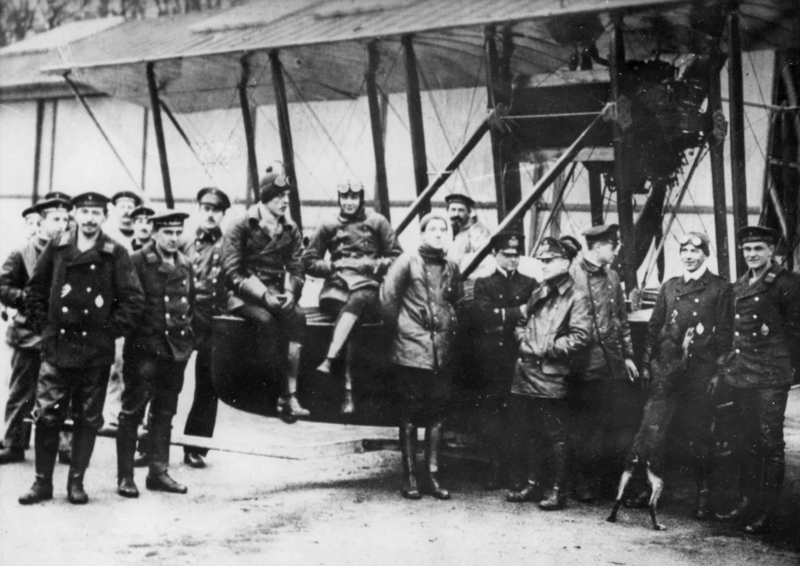
In the Royal Flying Corps, the last three of their twelve “Type D” two-seaters are relegated to training at the Central Flying School with two of their remaining five single-seat “SS” Scouts. One of their three “SS” scouts recently re-activated from storage at St. Omer Air Park in France has had a rifle fitted to a centre section strut.
The Royal Naval Air Service still has seventeen pre-war Sopwith machines although few are in front line service. The oldest are two “Type D1” two seaters and a “Bat Boat” from autumn 1913. Another twenty-five RNAS machines are the recently built “Type 860” large torpedo and bombing floatplanes, “Type 806” Sunbeam gunbuses, “Type 807” Folder floatplanes, “D3 Daily Mail” two-seat landplanes and the much anticipated new “SS3” single-seat scouts. Many of these recent machines are still to be formally accepted into service.
On 4th January 1915 Sopwith receive an order for twelve “Tractor seaplanes Schneider Cup type but with detachable fuselage with 100hp Gnome monosoupape engines to be supplied by the Admiralty”. The instrument boards complete with instruments are also to be Admiralty supply. At £1,105 each (£850 plus 35%) plus safety belts, engine starting gear, twelve spare sets of floats and propellers, the total order value is £15,768. (c.£1.5m in 2015).
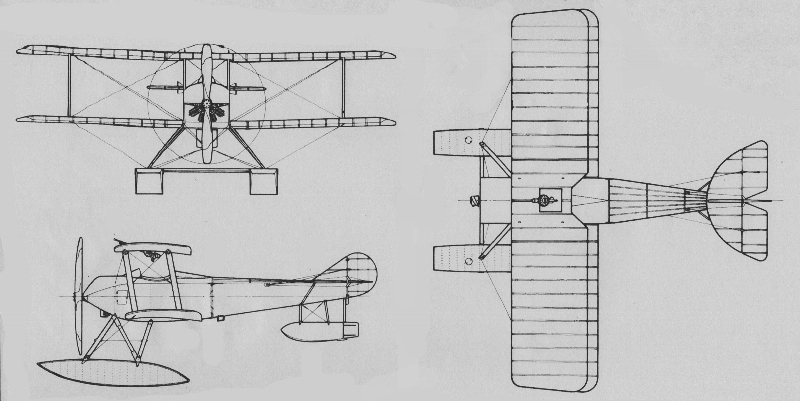
These “Schneider” floatplanes will closely resemble the racing “Tabloid” which won the Schneider Trophy Race in April 1914. Still with wing warping, the main differences are a crank handle in the cockpit for engine starting, a detachable rear fuselage for shipboard stowage, an aperture in the top wing for a Lewis machine-gun, an extra diagonal strut bracing each float and a lowered rear float. The RNAS plan to operate these Sopwith “Schneiders” from modified cross-channel packet boats on their anti-Zeppelin patrols in the North Sea.
At the Sopwith Works in Kingston 1915 starts as hectically as 1914 ended. They receive urgent orders for various parts for damaged Sopwith machines and one for crated sets of “spare planes with struts, fittings, etc.” for two “Type 807” floatplanes and two “SS3” Scouts to be delivered to HMS Ark Royal at Blythe.
On 4th January 1915 the fifth 80hp Sopwith “D3 Daily Mail” landplane No.1055 is completed at the Sopwith works, as is “Type 807” Folder floatplane No.920 which goes to the Royal Naval Air Service (RNAS) at Calshot.
Also on 4th January Harry Hawker re-delivers Sopwith “Type 806” Gunbus No.804 with a 150hp Sunbeam engine to Hendon. It is to be crated and go forward to 1 Squadron RNAS at Dunkirk.
On 6th January the third 80hp Gnome engined Sopwith “D3 Daily Mail” landplane No.1053 is flown from Brooklands to Eastchurch Naval Air Station by Harry Hawker. It is tested that day and accepted by the RNAS.
Sopwith “D3 Daily Mail” landplane No.1054 which had been delivered disassembled to Eastchurch on 2nd January went forward to Killingholme Naval Air Station on the Humber River estuary on 6th January the same day that No.1055 arrived there directly from Kingston. A Sopwith outwork team takes two days to assemble both machines. On 9th January Harry Hawker arrives to test them before handing them over to the Admiralty.
On 7th January Sopwith accepts a telephoned order from the Admiralty to immediately retrieve Sopwith “Type 807” folder seaplane No.920 from Calshot and pack it in “strong cases” along with No.921, the next off the production line, with a set of spares for both machines. The £276 10s 9d order includes £10 for the delivery directly to Lieut. Cull on SS “Persia” in Tilbury Docks. Clearly something urgent is afoot.
On 8th January Flight Sub-Lieutenant E.H.Dunning “damages the chassis” of Sopwith “Type 807” folder seaplane No.809 on Southampton Water. This machine has frequently been seen flying from Calshot.
On 10th January the first “D3 Daily Mail” landplane No.1051 is damaged on take-off at Eastchurch after less than a month in service. Sopwith machines are suffering in the inclement January weather.
On 11th January the Sopwith “Type D” No.104 which has been at Eastchurch since early September suffers a failure of its 80hp Gnome engine. Flt. Lt. I.G.V.Fowler manages a forced landing on mud flats by the River Blackwater but this ends the 17 month career of one of the earliest Sopwith machines still in naval service.
On 12th January Sopwith “Greek” pusher No.897 flying as a landplane from Killingholme also suffers an engine failure and force lands on Stallingborough Marshes. It is damaged by the wind after landing but is repairable.
Also on 12th January the large Sopwith “Type 860” floatplane No.854 with 100 sq.ft. extra wing area which has only been at Calshot for 6 days is towed back to Sopwith’s sheds at Woolston for a new engine. There must be teething problems with the latest 225hp Sunbeam engines as well as the design of these machines.
On 13th January HMS Ark Royal is working up to operational readiness at Blyth with two “Type 807” Folder floatplanes aboard and the first two of four crated Sopwith “SS3” Scouts. (Photo shows a Folder on her deck)
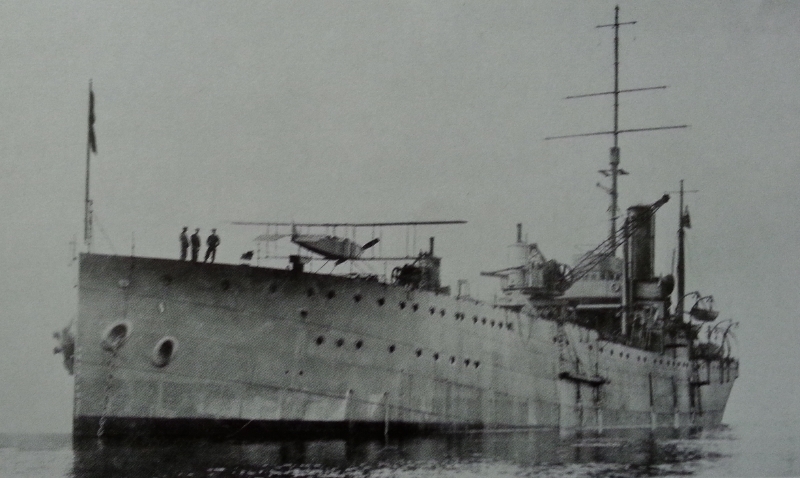
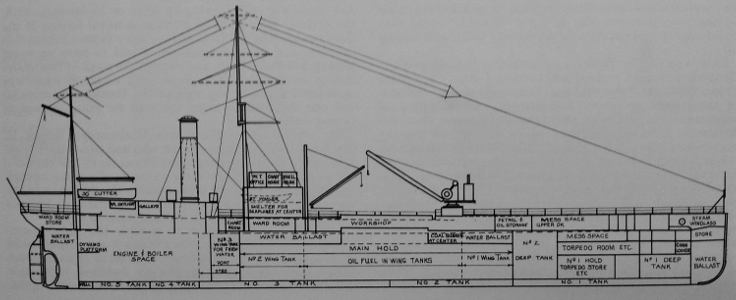
Ordered in May 1914 and built by the Blythe Shipbuilding Company on an existing keel and frame structure, Ark Royal is the first surface vessel in the world to be specifically designed and built for the sole purpose of operating aeroplanes, nominally 10. She has an aircraft shelter in front of the mast and a flat open foredeck with standard Stothert and Pitt steam cranes on either side amidships for lifting aeroplanes to and from the sea and from the workshop/hangar immediately under the deck via a large sliding hatch. With no plan to fly aircraft from the deck the whole ship is bedecked with wireless telegraphy aerials. At 7,450 tons and modern enough for her steam boilers to be oil fired, she is capable of 11 knots. Launched on 5th September 1914, Ark Royal started sea trials on 10th December the day she was commissioned into the Royal Navy.
On 9th January 1915 Sopwith takes a £55 order for replacement float frames for Folder No.809 and on the 14th January a £20 10s order for rudder, lower tail beams and skids for the damaged Pusher No.897 at Killingholme.
By 14th January 1915 the Sopwith factory has completed two more new aircraft, another“D3 Daily Mail” landplane No.1056 and “Type 807” Folder floatplane No.922.
Also on 14th January, just 7 days from taking the order, Sopwith deliver the two specially crated Sopwith “Type 807” folders and their spares to the impressed P &O liner SS “Persia” in Tilbury Docks.
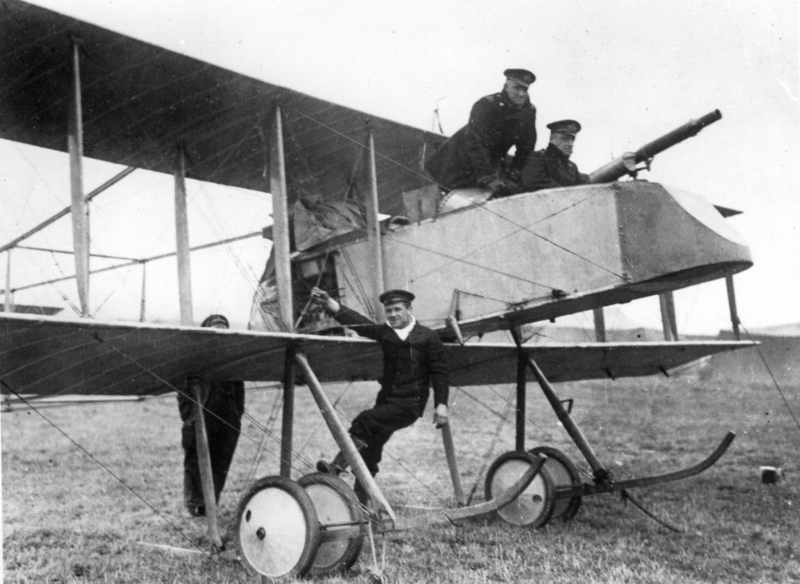
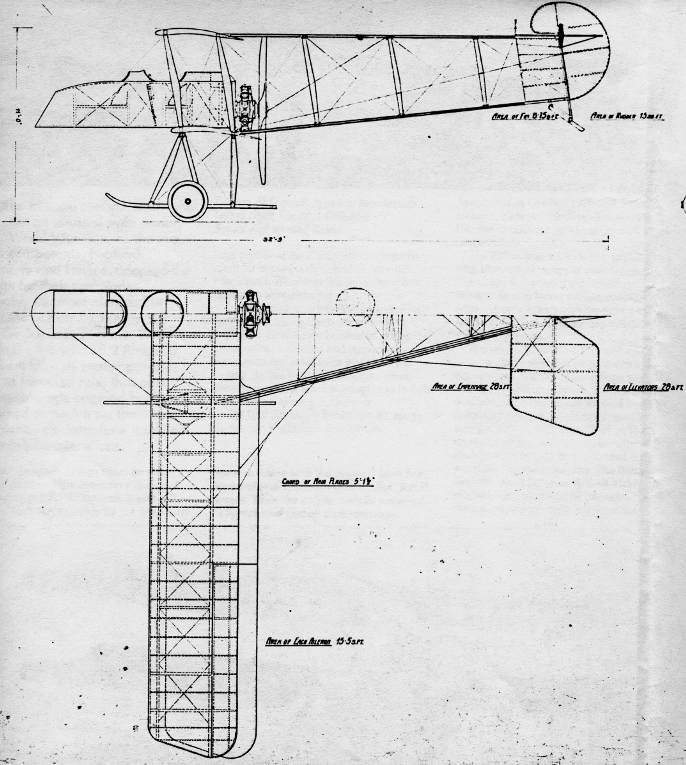
On 14th January 100hp Anzani engined Sopwith pusher No.123 (above) built in March and converted to a landplane at the end of September makes its final coastal patrol. Although recently fitted with bombing dropping gear it has mostly been used for instruction. Its partner No.124, possibly still on floats, also has bomb dropping gear and recently a new rudder but both are to be to be shipped to the RNAS Repair Depot at Grain to be deleted from service as of “poor design”. These are the last two aircraft in the RNAS with the complex two-row 10 cylinder Anzani radial engines, a fact which may have influenced the decision to retire them.
On 14th January Sopwith receive an order from the Admiralty to remove the lower right plane from “Type 860” No.852 currently at their Woolston Works to replace a damaged one on No.853. They are then to strip all her wing leading edges removing three-ply formers and substitute inter-ribs. There is no indication whether this modification relates to the fatal accident with the first machine or if it is to be applied to all “Type 860s”. That could be done as the three complete ones are with Sopwith at the moment and the others are still being built.
On 15th January Sopwith take an urgent £250 order for another set of main planes and two spare undercarriages for “SS3” scouts plus two spare sets of floats for “Type 807” folders. Delivery is promised in 14 days directly to Ark Royal at some naval base to be advised. This is followed on 17th January by a £410 order for a third set of floats and three land undercarriages to fit Ark Royal’s folder floatplanes “without necessitating any structural alterations to the machines”. Carriage and packing adds £23 13s 1d. to the order value.
On 16th January Sopwith takes a rare War Office order for six sets of undercarriage spares for “SS” Scouts, the day before RFC “SS” Scout No.362 flown by Capt. Holt crashes at St. Omer and will have to be struck off. Sister-ship No.386 is especially fitted with “two boxes for shot dropping” by 18th January but it too is wrecked on 20th January ending the largely undistinguished careers of Royal Flying Corps Sopwith “SS” Scouts in France.
The 17th January sees the first Zeppelin airship raid on Britain. Reluctantly approved by the Kaiser and “expressly restricted to military establishments”, three airships of the Imperial German Naval Airship Service set out from Nordholz near Cuxhaven and from Fuhlsbüttel near Hamburg. L.6 turns back with engine trouble. L.3 having reached 5,000ft makes landfall and arrives over Great Yarmouth at 8.20pm where three bombs are dropped demolishing some cottages and killing an aged couple. He then circles around over Norfolk. Equally lost, L.4 arriving south of Cromer proceeds up the coast dropping a bomb on Sheringham, three on Hunstanton and four on Kings Lynn which kill two people and injure thirteen. The three aircraft ready at Yarmouth Air Station are incapable of flying high enough and do not attack the airships which are “lost from view”. Not a single round is fired at the airships by any gun during the whole four hour raid. They return safely coated in a thick layer of ice. L.4 reports successfully bombing fortified places between the Humber and Tyne.
On 16th January the SS Persia sails from Tilbury Docks with the two Sopwith “Type 807” folder floatplanes and the twenty-strong RNAS Expeditionary Force No.4 under the command of Flt Lt J.T.Cull. Amongst these are three civilians granted temporary naval ranks, Chief Petty Officer Sprot and Petty Officer Burgess from Lang Propellers and Petty Officer Mobsby from the Sopwith Aviation Company. Their destination remains secret.
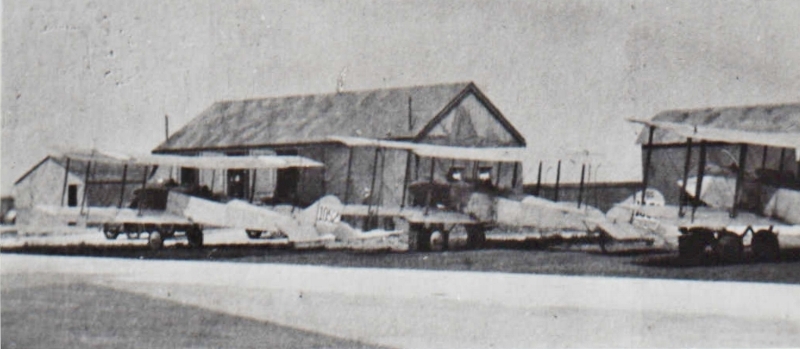
On 18th January the “D3 Daily Mail” landplane No.1052 (above with two others at Yarmouth) suffers an engine failure and forced landing at Sizewell Gap. It is disassembled and taken back to Yarmouth for re-erection.
On 21st January Killingholme based “D3 Daily Mail” landplane No.1055 also suffers an engine failure. The forced landing in a ploughed field at Scartho breaks the propeller.
On 22nd January “D3 Daily Mail” landplane No.1052 re-erected yesterday at Yarmouth after its engine failure and forced landing five days ago, suffers the same fate yet again. This time however it is badly damaged.
Also on 22nd January another Yarmouth based “D3 Daily Mail” No.1053 also suffers engine failure ending up on its nose in a ploughed field near Sherington.
All these accidents point to issues with the well-established but now British-built 80hp Gnome rotary engines. Whether it is build quality, maintenance, tuning or pilot inexperience with these engines, the frequent resulting crashes are starting to tarnish the reputation of these Sopwith “D3 Daily Mail” landplanes with RNAS pilots.
There is news that on 20th January long-serving Sopwith “D1 Three-Seater” No.103 crashed on landing at Eastbourne but is probably repairable, unlike sister-ship No.104 nine days before.
On 22nd January Sopwith “Circuit” floatplane No.880 goes out on patrol from Yarmouth Naval Air Station after a hostile aircraft sighting and again on 23rd January on an anti-Zeppelin patrol, both are false alarms.
However, on 25th January its tailplane and rudder are damaged in the surf and repairs are needed.
On 26th January No.856 another Sopwith “Type 860” is recorded ex-works whilst on 27th January sister “Type 860” No.854 with 100sq.ft. of extra wing area is test flown with a torpedo. Real progress for this troubled type.
On 26th January a £168 spares order is taken for a new “lower plane and chassis complete with wheels and tyres” for crashed Sopwith “Greek” pusher No.897. Delivery to Killingholme on the Humber adds £5 1s 5d. Sopwith know this aircraft is urgently needed back in service and, despite all the other work in hand, delivery of the new chassis is to be in four days for rebuilding to commence with the wing following in three weeks.
The Admiralty are also still also placing urgent orders for spares for Sopwith aircraft on HMS Ark Royal. An order on 25th January for three spare propellers is followed with spares orders on 27th January for a “tail assembly complete with tail float” and another for “bomb gear” for Sopwith “Type 807” folder No.922.
On 28th January all these spares are delivered directly to Ark Royal, now at Chatham Dockyard, along with aircraft No.922 just completed by the factory in Kingston. This machine is fitted with an armoured seat.
On 28th January another new “D3 Daily Mail” landplane No.1056, which arrived at Yarmouth by train from Kingston two days ago, has been erected by a Sopwith out-work team and is test flown by Harry Hawker. With so many of their machines out of action it is immediately accepted into service.
On 29th January 1915 Sopwith Aviation takes an order for three “deck flying trolleys to Admiralty design” for their “Schneider” floatplanes. At £32 10s each these are to be delivered to the Royal Naval Air Service at Isle of Grain with the first of this new type of small floatplane which should be finished in the next two weeks.
On 29th January “Type 807” folder seaplane No.919 is flown at Calshot by pioneer aviator and designer Eric Gordon England now a freelance test pilot mostly testing “Wight” aircraft for J. Samuel White & Co of Cowes.
On 31st January one of the large 225hp Sopwith “Type 860” biplanes No.855 surprisingly appears at Brooklands as a landplane. It is flown and recorded as “cleared” in the company records within three days. On wheels and based at Brooklands it should be possible to do much more intensive test flying with this troubled design than is proving possible with floatplanes on Southampton Water from Calshot, especially in winter.
On 1st February HMS Ark Royal sails from Harwich to join an armada of British and French warships tasked with forcing their way from the Aegean Sea east of Greece through Turkey’s Dardanelles narrows. The ultimate aim is forcing on through the Bosporus to re-open the supply route between the Mediterranean and the Black Sea.
Ark Royal’s unique role is to provide the fleet with reconnaissance and gunfire direction from the air. On board are four Sopwith “SS3” Scouts and three 100hp Sopwith “Type 807” folder floatplanes along with three much larger 200hp floatplanes: two 63ft wingspan Wight Pushers and a 52 ft span Short “Type 135” No.136.
It was a major blow to the allies when Turkey formally entered the war on the German side in November 1914. Germany has been building the Berlin to Baghdad railway and helping to modernise Turkey’s armed forces. Turkey wants to recover territory recently lost in the Balkans War and in North Africa. For the Germans there are the oil fields in Turkey’s vast Ottoman Empire. It is also an opportunity to help Turkey retake Egypt, and particularly its Suez Canal, which have been under British occupation since 1882.
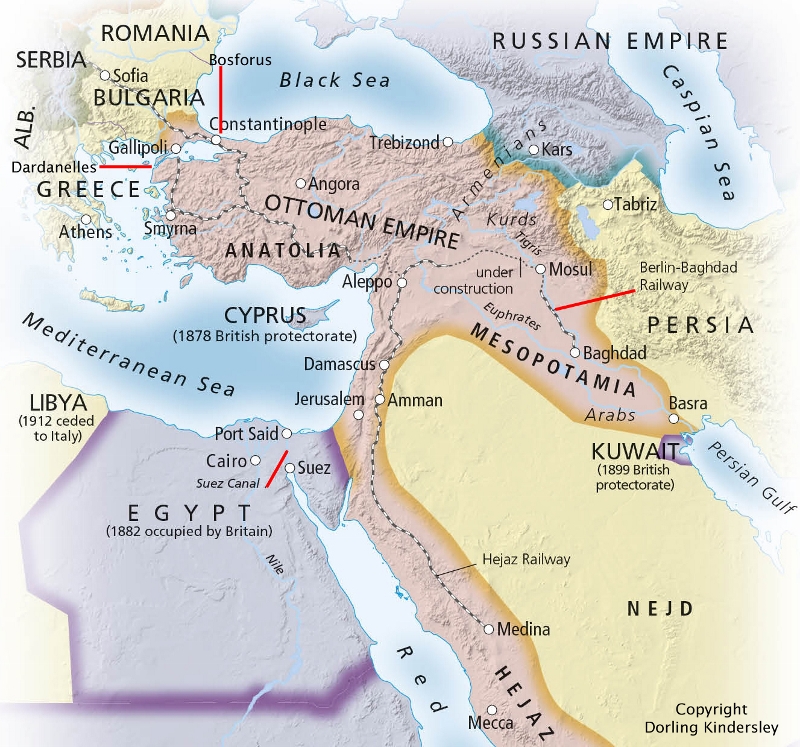
It is unthinkable for Britain to lose the use of the Suez Canal, the major trade route with most of the British Empire and also the route for crucial oil supplies from Mesopotamia and neutral Persia.
Churchill reveals his main reason for an Anglo-French offensive in the Dardanelles when he declares “the best way to defend Egypt is to attack Turkey’s Adriatic coast”. Russia, fighting the Germans and Austro-Hungarians along the whole Eastern Front and the Turks in the Caucasus, is also pleading for such action “to divert Turkish army resources and relieve the pressure”.
On 2nd February “Type 807” folder floatplane No.810 is damaged in tow from St. Helens. Sopwith immediately accept a telephoned order to deliver a “lower right-hand plane and fittings” within four days, priced at £60.
Engines supplies are limiting the rate of new aircraft deliveries. On 2nd February the next two new 80hp “D3 Daily Mail” landplanes Nos.1057 & 1058 are delivered to Yarmouth just three days from receipt of the free-issue engines. A Sopwith out-work team will erect them at Yarmouth at some time in the next eight days.
On 3rd February an order arrives for Sopwith to make a set of parts for an Admiralty free-issue engine with propeller bosses for eleven others. Including the tooling, the order is priced at £115 17s 0d. The Admiralty are exploiting Sopwith’s flexibility and rapid response whilst Sopwith are making good profit margins on such work.
On 4th February another urgent order is taken, this time for a “top front engine cover for an 80hp tractor” at Killingholme. It is delivered the next day for £4 12s 0d.
On 4th February at Calshot “Type 860” No.854 is the first of this troubled type to be accepted into RNAS service.
On 5th February a fifth “Type 807” folder floatplane No.923 leaves the works followed two days later by the ninth and tenth “D3 Daily Mail” landplanes Nos.1059 & 1060, the first to go to 1 Squadron RNAS at Dover.
After failing tests in November, Sopwith’s test pilot Victor Mahl retests the second 200hp Sopwith “Type C” torpedo floatplane No.158 (see drawing below) on 4th February and it is finally accepted by the RNAS.
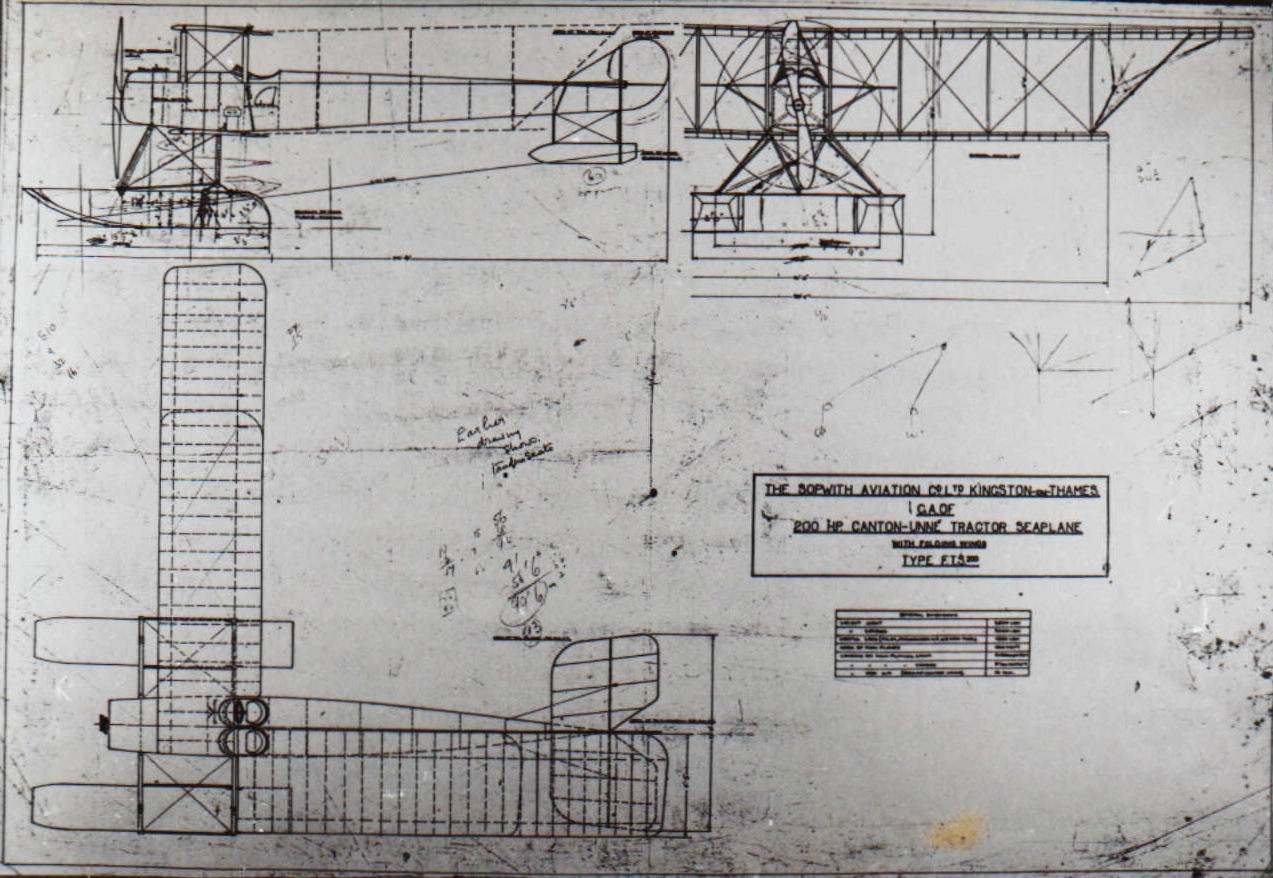
However the unreliability of the complex 200hp Canton-Unné water-cooled two-row radial engines continues to cause problems. On 8th February No.158 suffers an engine failure and force lands half a mile west of Calshot Spit light vessel. Whilst an attempt is made to tow it back, it sinks and is a total wreck after just four days in service.
Meanwhile also at Calshot on 8th February the next 225hp Sopwith “Type 860” floatplane No.859 arrives for testing.
Back at the factory, an urgent £3 16s 6d order from Yarmouth for 36 various nuts and bolts is despatched immediately whilst an urgent order for a chassis and two lower planes for crashed “D3 Daily Mails” Nos.1054 & 1055 is to be despatched to Killingholme in three days for £243 plus £3 11s 8d packing and carriage.
On 8th February SS Persia arrives in Bombay having brought her secret cargo of Sopwith “Type 807” folder floatplanes through the Suez Canal now heavily protected by the British Army dug-in against any Turkish attack.
On 11th February No.920 is erected on the quay in Bombay (below) beside ex Union Castle liner Kinfauns Castle hired by the Royal Navy as an Armed Merchant Cruiser (AMC).
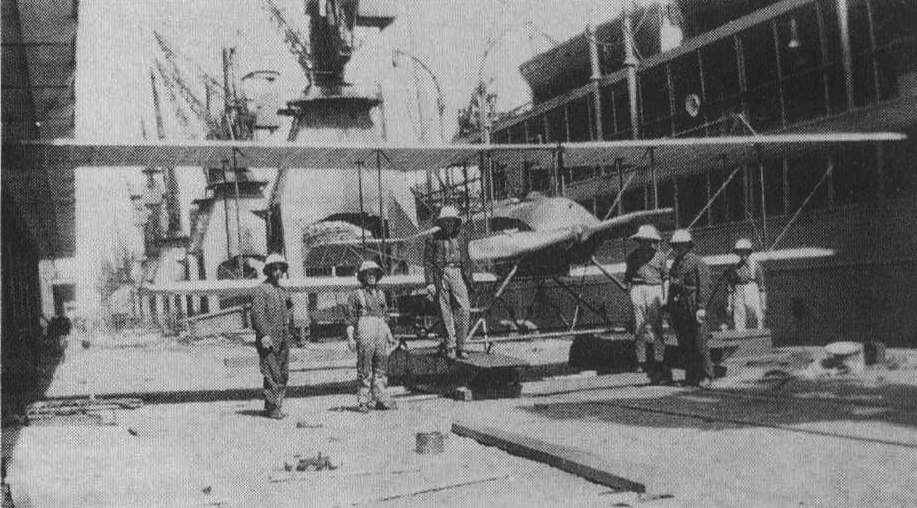
No.920 is flown by Flt Lt Watkins and Midshipman Gallehawk RNR under the cover story that they are to establish a flying school in Bombay. The port wingtip is damaged on these test flights and will have to be repaired on board the Kinfauns Castle during the 3,000 mile voyage southwest to Niororo Island eighteen miles out in the Indian Ocean from the huge Rufiji Delta on the coast of German East Africa. The German cruiser SMS Königsberg has been hiding in the web of rivers, swamps and islands of the Rufiji Delta since October 1914. She is a real threat to British shipping in the India Ocean and must be put out of action. Two hired South African Curtiss flying boats have located her nine miles up the delta but are now beyond repair. The Sopwith floatplanes are desperately neede to try to bomb the ship, assess the German land defences and survey the channels before directing 6-inch gun-fire from shallow draught Royal Navy monitors unsighted and probably over four miles away.
On 10th February urgent orders arrive for wheels, tyres and axles for “Greek pusher” No.897 at Killingholme for £28 5s 0d. and for “diagonal front chassis struts” for “Type 807” folders Nos. 809, 810 & 919 at Calshot for £12.
On 11th February “1914 Circuit” floatplane No.880 is put out of action again at Great Yarmouth, this time hitting a buoy and damaging a lower wing whilst taxying on the sea.
On 12th February the first 100hp Sopwith “Schneider” single seat floatplane No.1436 is recorded as complete by the factory and is test flown on the Solent by Victor Mahl. That same day Sopwith eventually receive confirmation of the Admiralty free-issue instruments for these twelve “Schneider” floatplanes. They are to have a Barograph, Air Speed Indicator, Revolution Counter, Compass, Clock and Cross Level.
On 14th February historic 90hp “Bat Boat” No.118 crashes and is deleted after 14 months in service at Calshot.
On 14th February HMS Ark Royal arrives in Malta after gales in the Channel and Bay of Biscay. Trials of Sopwith “Type 807” floatplane No.808 in Valletta Harbour are cut short when a float breaks off in the swell on the first take-off attempt. Repairs are in hand as Ark Royal sails for the Greek island of Tenedos in the Aegean Sea.
The next day Sopwith take an urgent order for that machine on Ark Royal. It comprises a set of main floats, main planes and a tail unit complete with float, to be packed in the smallest possible crates and delivered to London’s West India Docks in the next nine days. At £457 3s 3d this order is, ironically, significant and profitable business.
Early 225hp “Type 860” No.854 is in trouble as on 15th February Sopwith are ordered to supply a rear engine mount and carry out repairs to this machine at Woolston, work valued at £135 1s 0d.
On that same day spares orders arrive for an extra long nosepiece for “SS3” Scout at Killingholme for £11 5s 0d and “one dozen each size 4mm to 10mm hex head nuts & bolts” for the Air Station at Fort George for 10s 8d.
Also on 15th February an Admiralty order confirms the fitting of 150hp Sunbeam engines to all six “Type 806” Gunbus machines in place of the ordered 110hp Sunbeams. In fact, three were originally delivered with 150hp engines and one converted two months ago. Only Nos.801 & 802 still need converting but Sopwith will claim £52 10s 0d each for all six. The surplus engines are to go to the Admiralty Aircraft Stores at Wormwood Scrubs.
Accidents continue with the 80hp “D3 Daily Mail” landplanes. On 16th February No.1053 force lands at Winterton breaking an easily replaced wheel and propeller but, more significantly, a main fuselage longeron.
0n board Kinfauns Castle steaming down to German East Africa the port wingtip of folder floatplane No.920 damaged at Bombay is being repaired under the direction of Sopwith employee and Temporary Petty Officer Mobsby. (below left with Expeditionary Force Leader Flt. Lt. Cull)
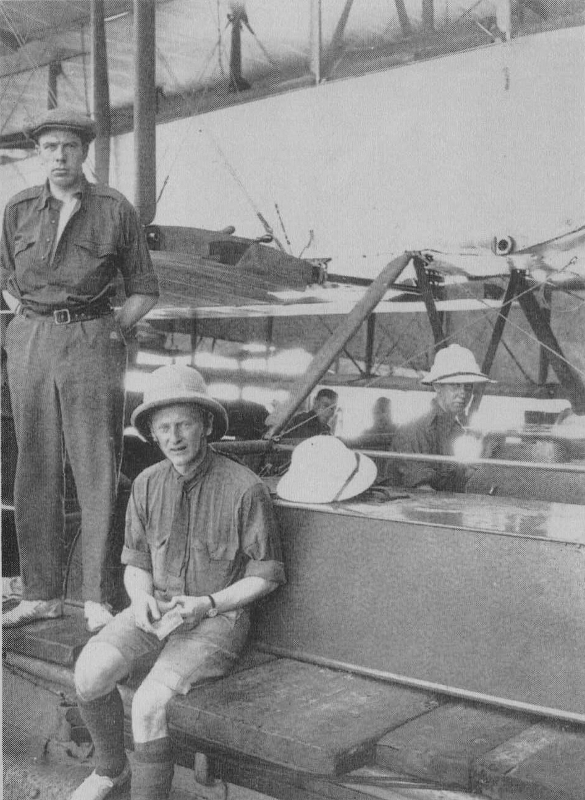
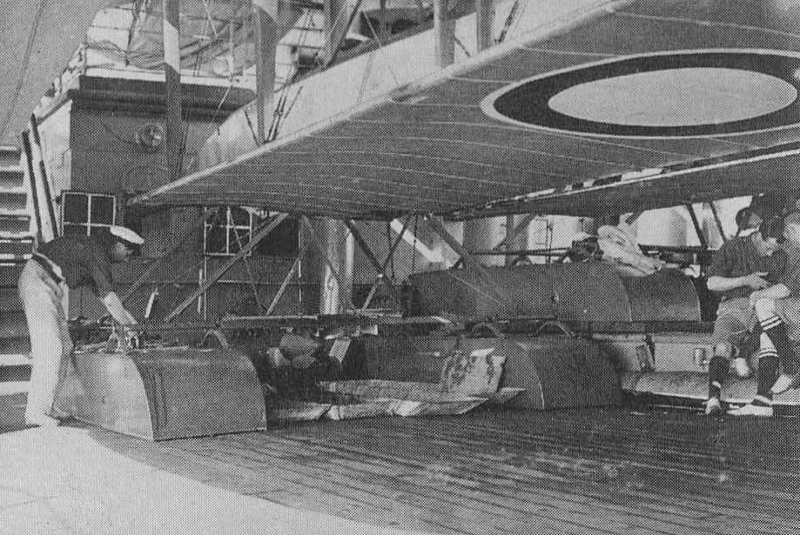
The two Sopwith folders (above right) are stored neatly side-by-side on the deck displaying the bold new nationality marks appearing on Royal Naval Air Service aircraft. Soon after adopting Union Jack underwing markings, British pilots found themselves coming under fire from French troops mistaking the British flag for a German cross at a distance or in poor visibility. The RNAS ordered their aircraft in France to be marked with a red ring on a white disk, initially with a Union Jack of drastically reduced size between this new roundel and the wingtip. The red ring on white disk roundel is now being more widely adopted across the RNAS.
Sopwith take an order to fit Wireless Telegraphy sets to all twenty-two 225hp “Type 860” floatplanes at £57 4s 0d per machine. The services have seen the huge value of real-time information for ship/airship spotting and gunfire direction; albeit in morse code, over limited distances, only on flyable days and hampered by bulky sets.
On 17th February HMS Ark Royal arrives at Tenedos Island in the Aegean Sea sixteen miles south west of the entrance to the Dardanelles straits. Sopwith “Type 807” folder floatplane No.807 is immediately deployed but, despite several attempts, fails to take-off until the fuel load is reduced. Even then it is unable to get sufficient height for any useful aerial reconnaissance, the vital role these aircraft are expected to perform.
18th February 1915 brings Sopwith an order for engine bearers and a nose piece which are despatched the same day for £20 13s 0d. to repair the damage done two days ago to Yarmouth based “D3 Daily Mail” No.1053.
On 19th February there is an urgent order for all sorts of materials and fasteners for immediate delivery by passenger train to Sheerness for shipment to East Africa in support of the two “Type 807” folder floatplanes.
On 19th February Sopwith receive formal orders for fitting free issue admiralty designed “bomb dropping gear”. They are to go on the fourteen undelivered “D3 Daily Mail” landplanes and eleven “Schneider” floatplanes for £3 per machine and on all twelve of the second order for “Type 860” floatplanes at no extra cost.
On 19th February Flt Lts N S Douglas and E H Dunning take Ark Royal’s third “Type 807” folder floatplane No.922 on a first Sopwith mission against Turkish land forces defending the Dardanelles. Their orders are to reply ‘yes’ or ‘no’ to the question ‘Are two guns of No.1 battery nearer to barracks than cliff?’, then spot onto No.1 Fort for HMS Inflexible at 4,00ft if possible but 3,00ft further off if necessary. The mission is not a success as the wireless telegraphy set short-circuits probably due to spray getting into the set during the take-off. Photograph below shows the machine and crew being hoisted back aboard Ark Royal.
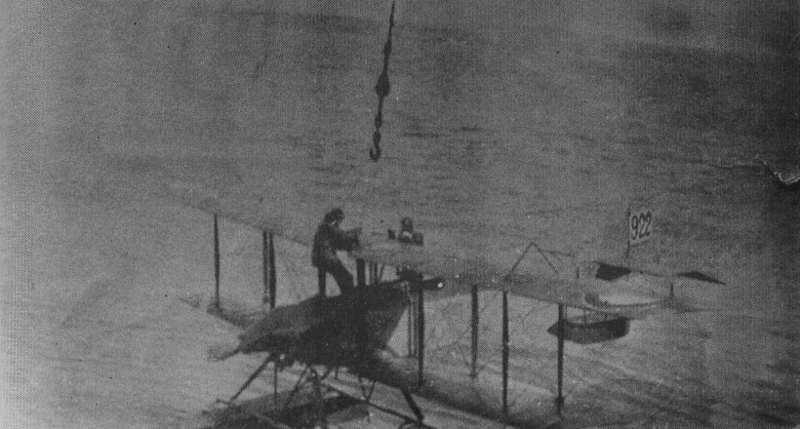
The third of the 200hp Canton-Unné powered Sopwith “Type C” floatplanes No159 undergoes a second test on 20th February but still records “poor performance” whilst 225hp Sunbeam “Type 860” No.858 which was completed by the works a week ago is tested by Victor Mahl and goes straight back to the sheds at Woolston to have more work done. Sopwith’s large floatplanes designed for torpedo carrying are yet to prove themselves.
In contrast, there is great confidence in the military version of the little 100hp single-seat floatplane which won the international Schneider Trophy Race in April last year. The prototype has only been flying eight days when on 21st February there is a repeat order, this time for twenty-four machines bringing the total to thirty-six. “Schneider” Nos.1556 to 1579 are priced at £1079 each. With safety belts, starting gear, spare propellers and floats this reaches £1274 17s 0d each, a total order value of £30,596 8s 0d.
On 21st February Kinfauns Castle arrives at Niororo Island off German East Africa after her week-long voyage from Bombay. That same day Sopwith “Type 807” folder seaplane No.920 is briefly test flown to check the repairs done aboard ship. No.921 is next to be hoisted out and Flt Lt Cull attempts a take-off in a cross wind with CPO Lacey aboard as observer. A wingtip catches the water and the propeller is damaged. The two machines are drawn up on the beach.
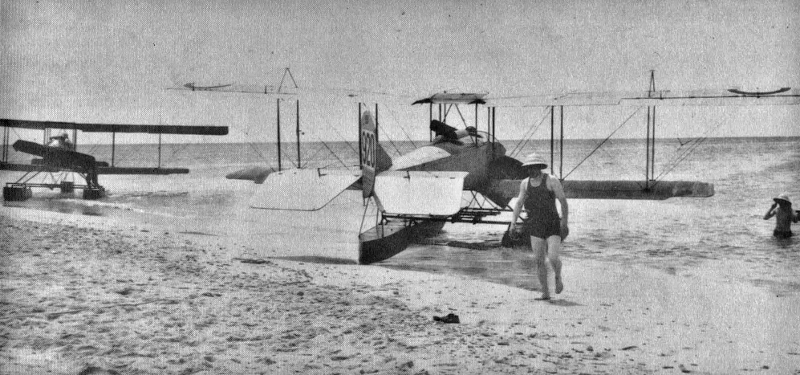
The propeller is taken to the workshop (below) especially set up aboard Kinfauns Castle for CPO Sprot and PO Burgess seconded from Lang Propellers Ltd. of Hersham.
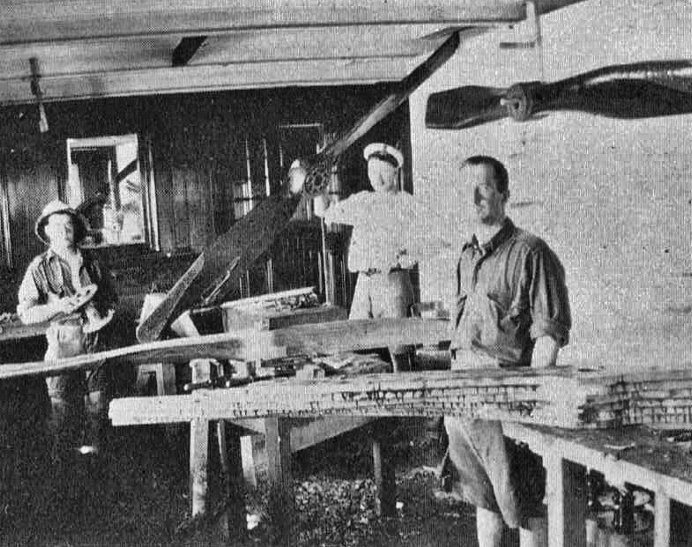
On 21st February 200hp Sopwith “Type 137” floatplane No.138 is damaged on landing. The next day an urgent order arrives for two 13’ 1” undercarriage cross struts to go to “Naval Aeroplane Station, Warsash”. They are despatched the same day.
On 23rd February “Type 860” No.857 is completed and on 26th February “Type 807” folder No.925 making ten machines built in the month and two aircraft a week so far this year in a mix of four different designs.
That matches the average weekly rate since the war began whilst supplying increasing volumes of spares. With orders for a further sixty machines they really need the factory extension due to be completed in February.
On 24th February the Admiralty order two spare propellers for the ageing Sopwith “Three-Seater” No.103 expecting more landing accidents now it is at the Naval Flying School at Eastchurch. They add an order for a spare propeller for the first “Schneider” floatplane which even more importantly needs to be kept airworthy.
On 24th February Flt Lt Watkins takes up repaired Sopwith “Type 807” folder seaplane No.921 from Niororo Island off East Africa but suffers another engine failure.
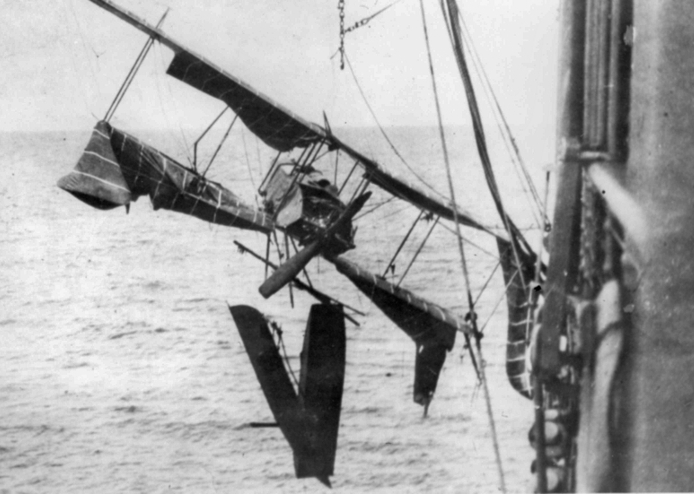
The machine is wrecked during the forced landing and makes a sorry sight as it is hauled aboard Kinfauns Castle. The damage from such an accident reveals the fragility of the lightweight structure, inevitable for such a low-powered two-seat machine to perform any practical duties and not designed for use on open seas. Equally, the clever lightweight 100hp Monosoupape Gnome engine, a winner when well maintained in temperate Europe, was not designed to operate in tropical summer heat.
The floatplanes on HMS Ark Royal in the Aegean are not fairing much better. After eight un-flyable days the Short Folder is hoisted out for reconnaissance but is found to have a cracked cylinder and the Wight finds the sea is too heavy, shipping water over the engine and shorting the distributor. Until now Ark Royal has reported that the 200hp Canton-Unné engines are giving little trouble but the 100hp Monosoupape Gnomes in the Sopwiths are difficult to coax up to the required speed to develop full power. On 26th February two Sopwith Folders No.807 and 922 do at least manage scouting flights but of just 25 and 30 minutes respectively.
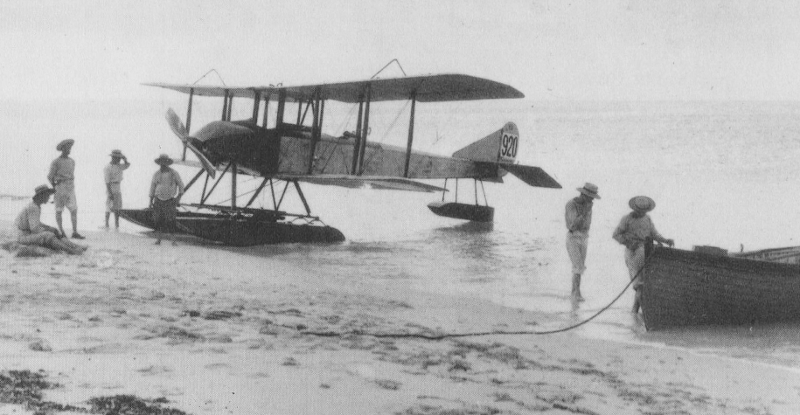
On 28th February the remaining “Type 807” folder No.920 on Niororo Island is brought to the waters edge (above). Flown by Flt Lt Cull with Ldg Mech Cornelius, it now suffers an engine failure and force lands on the sea close to AMC Kinfauns Castle which salves the machine with damage only to float struts and a lower mainplane. These Monosoupape Gnome engines have no carburettor, the volume of air in the fuel mix is non-adjustable. A pump sprays fuel into the crankcase in proportion to engine speed mixing it with air sucked in through a hole in the hollow crankshaft. This crankcase mixture is very rich. The remaining air required to create the explosive mix is sucked into the cylinder at the start of the induction stroke by leaving the exhaust valve open after the exhaust stroke, hence “monosoupape” or “one valve”. With the thin hot air in the tropics in summer they lack the oxygen needed to achieve full power and are overheating, running rough and rich. Over 6,000 miles from home with no access to advice from experts, Cull and his team set about improvising ways to increase engine power and reliability.
On 28th February 80hp Sopwith “D3 Daily Mail” landplane No.1056 ventures out from Yarmouth but in squally weather, Lt. J M R Cripps has to force-land on Caistor Marshes.
On 1st March Harry Hawker delivers the latest “D3 Daily Mail” landplane No.1061 to Hendon from Brooklands.
Sopwith are ordered to send the final three of the twelve “Type 807” folders Nos.924, 925 & 926 to Birkenhead Docks for erecting and loading onto HMS Campania. Modified with hangars, derricks and a 160 foot flying-off deck, the retired Blue Riband winning 1892 Cunard Liner is due for commissioning trials as a floatplane carrier.
An order is taken to repair and overhaul Hendon based 150hp Sunbeam “Greek” pusher No.806 in just three weeks for £50. The wheels are to be moved forward to match No.805 and it must achieve 1,000ft fully loaded.
Out in the Aegean on 1st March the bottom of a float on Sopwith folder No.922 is carried away before take-off. Repaired by the 3rd March, Fl Lt N Sholto Douglas and PO B J Brady are able to locate a minefield, guns in forts and a gun battery and on 4th March they are able to report Turkish troop movements by wireless.
That same day No.807 is the first Sopwith floatplane to come under fire, being hit eight times. Hurriedly patched up, the next flight strains the float struts and it returns lop-sided. No.808 is also out after the repairs for a broken piston valve three days ago. Covering a landing by a demolition party, they watch for the enemy but suffer fuel problems and return to Ark Royal. At a second attempt they fail to climb with ignition problems.
By 4th March Sopwith Type 807 folder No.920 is flying again from Niororo Island off German East Africa with new float struts and starboard lower mainplane after the forced landing four days ago.
Cull’s team have fitted a funnel onto the engine nose piece in an attempt at supercharging the engine by forcing more air into the crankcase via the hollow crankshaft. They have also tampered with the valve timing and retarded the ignition timing but the engine is running hotter and rougher. As a final cooling measure they remove the top front cowling to fully expose the engine.
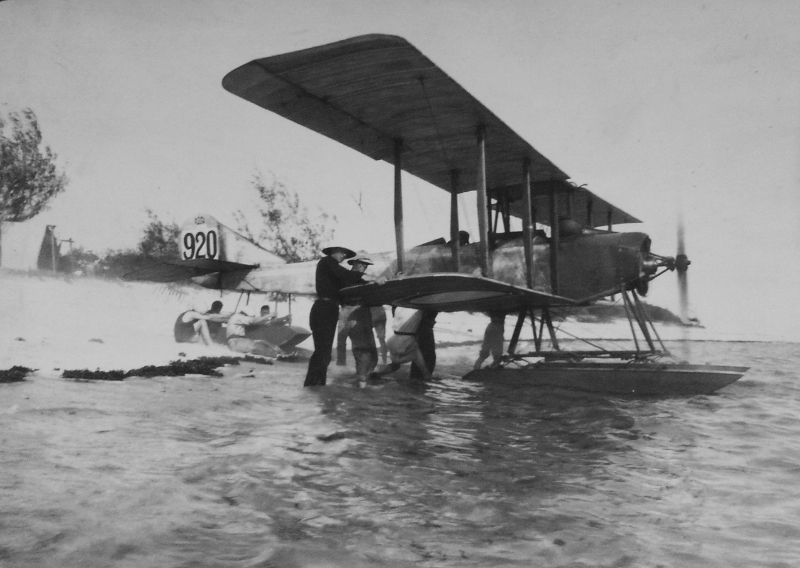
Sopwith Folder No.920 on the beach at Niororo with exposed engine running whilst tail float and wings are held back
On 5th March Yarmouth “D3 Daily Mail” No.1053 suffers engine trouble and damage on landing. On 6th March Sopwith take an order for a replacement 9 inch taller chassis to be delivered in three days for £49 1s 1d.
In the Aegean on 5th March Folder No.922 is hit six times by ground fire and Fl Lt N Sholto Douglas is wounded in the leg. No.808 is also out to spot for the guns of HMS Queen Elizabeth but at 3,000ft the propeller bursts breaking the starboard wingtip causing the machine to spiral down into the sea three miles west of the ship. Rescued by HMS Usk, Fl Cmdr H A Williamson is seriously injured and Flt Lt W H S Garnett slightly. The machine is wrecked and written-off, only the engine is saved. Meanwhile searches of Tenedos Island by air and on foot fail to find a suitable landing ground for the four crated “SS3” Scout landplanes stranded on Ark Royal.
On 7th March the second 100hp Sopwith “Schneider” single seat floatplane No.1437 is completed and ready to be packed and despatched to Devonport for the SS Moorgate to take to the Dardanelles.
On 8th March the issues with the early 225hp Sunbeam powered “Type 860” floatplanes take a positive step forward when Sopwith agree at their own cost to re-position the mainplanes on No.853 and change the chassis bracing to match the recently accepted No.856. They are also instructed to deliver the fuselage of No.927, the first of the second order for these machines, to the Sunbeam Engine Works at Wolverhampton.
Sopwith continue to react rapidly to last minute Admiralty orders. They agree to fit “special 8 inch bomb gear” to the three “Type 807” folders about to go up to HMS Campania in Cammell Laird’s shipyard at Birkenhead.
On 9th March Sopwith take a third order for 100hp “Schneider” floatplanes this time for fifty machines. With the unit price only reduced by 3.5% and extras including an “accumulator and coil ignition arrangement in lieu of magneto for the starting gear”, this order is worth £63,562 10s 0d. (Over £6m in 2015).
With eighty-six now ordered, the “Schneider” is set to be the most numerous Sopwith type to date. There are forty-six “Type 860” floatplanes on order, otherwise only the “Tabloid” family has reached thirty examples.
Off German East Africa on 9th March Flt Lt Cull no sooner lands Sopwith “Type 807” folder No.920 than the right float starts to sink. AMC Kinfauns Castle is again at hand to rescue Cull and hoist the floatplane aboard.
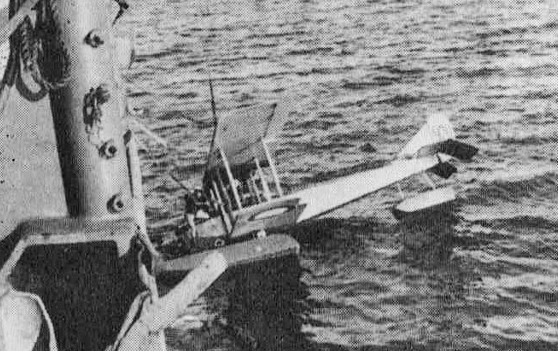
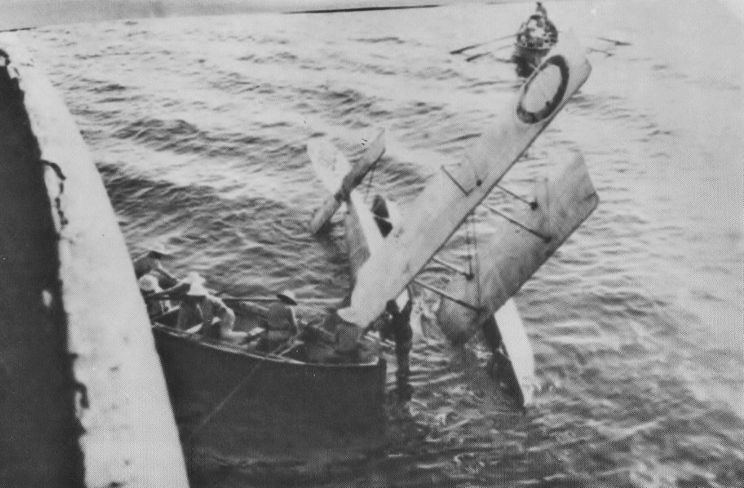
On investigation it is found that the bottom of the float has peeled off weakened by the build up of pressure whilst in the hot sun on the ship’s deck. They decide to fit the floats with air vents, reinforce the bottoms with sheet metal from empty oil cans and keep them filled with water until hoisted out for flight.
On 10th March “D3 Daily Mail” No.1056 overturns on landing at Yarmouth. Spare interplane struts, engine bearers and a wheel are immediately ordered for delivery in three days, priced at £43 1s 1d including carriage.
On 10th March Victor Mahl completes a four hour flight in 225hp “Type 860” floatplane No.857. Sopwith are immediately instructed to collect it from Calshot and crate it with sister machine No.860 which will be completed this week. A valuable £1,015 urgent spares order follows for an undercarriage and floats, a tail unit and float, a set of mainplanes and four propellers for these machines. All are to be shipped to Devonport.
On 11th March Sopwith take an order for twelve transport trolleys at £15 10s 0d each “for side movement of machines for manoeuvring onboard ship as arranged with Mr Sigrist”. One is required urgently at Devonport.
On 11th March “D3 Daily Mail” landplanes Nos.1059 and 1060 finally join the crucial Dover Defence Flight. They failed tests after delivery and erection there in early February and took until 23 rd February to be accepted into service. In that time No. 1059 suffered an engine failure and forced landing, like so many others of this design.
On 13th March Yarmouth based “D3 Daily Mail” No.1052 suffers its third engine failure and forced landing, this time on Southtown Marshes. Two days later new engine bearers are ordered from Sopwith for £27 6s 4d.
On 13th March “Type 807” folder No.809 crashes in the sea and is completely wrecked. Co-incidentally, that same day the Sopwith works complete a new folder No.924, the second of the three for HMS Campania.
In the Aegean Sopwith “Type 807” folder No. 807 is in such poor condition and the engine power so limited that on 14th March Fl Lt Dunning takes up it up to see if one person can keep control of the machine whilst working the wireless telegraphy set. The test is cut short by the engine overheating. Trying again two days later a float is torn away getting off the water and the wings are damaged during salvaging.
Off German East Africa the RNAS are giving up with their last Sopwith Folder No.920. The Commander-in-Chief Cape wires the Admiralty on 14th March to say that further aerial operations against Konigsberg are impossible until other aircraft are made available. He is immediately promised three well-used Short folders which have been rejected by home stations but do have 160hp Gnome engines, nominally sixty percent more power. The Expeditionary Force sails in Kinfauns Castle for Mombasa from Niororo Island on their way to Durban to collect these replacement floatplanes. They take No.920 with them.
On 14th March after one week in service Sopwith “D3 Daily Mail” landplane No.1061 force lands on Hackney Marshes en route from RNAS Hendon to its intended base at Chingford.
15th March the third 100hp Sopwith “Schneider” single seat floatplane No.1438 is completed and crated together with a set of major spares and No.1437 recently recovered from Calshot. They are sent to Devonport to sail to Dardanelles on SS Moorgate. Sopwith 80hp Tabloid “SS3” single-seat landplanes Nos.1205 & 1206 will be sailing with them. Delivered in December, they were recently returned to Dover Air Station from Dunkirk.
Sopwith Tabloid “SS3” landplane production has restarted at Kingston with the seventh and eighth machines Nos.1207 & 1208 going directly to Yarmouth by rail on 16th March only to be returned to have their ailerons repaired. Two more, Nos.1209 & 1210 will be ready to go to No.2 Squadron at Eastchurch in four days time.
Since 12th March Ark Royal’s floatplanes have been out daily recording Turkish gun emplacements on both sides of the Dardanelles Straits and looking for mines. On 17th they report no mines west of Kephez Bay as do that night’s minesweeping trawlers. On 18th March a flotilla of large ships goes thus far into the straits to shell the gun emplacements unaware that a new minefield had been laid in the night in Eren Keui Bay. Ark’s Wight and Sopwith floatplanes report some successful shelling but the Turk’s guns and howitzers damage most ships. The French battleship Bouvet is mined and goes down with over 600 lives. Irresistible and Ocean strike mines and are abandoned. Inflexible is mined but limps out. This naval disaster leads to an urgent call for troops to clear the enemy from the Gallipoli peninsular which forms the western shoreline of the Dardanelles straits.
On 18th March the twelfth Sopwith “D3 Daily Mail” landplane No.1062 is delivered to Hendon by air from Brooklands and reportedly with modified tail surfaces. Meanwhile an order is taken for new engine bearers for early Sopwith “Three-Seater” No.103 which must have suffered in the hands of the trainee pilots at Eastchurch.
On 22nd March Sopwith Folder No.920 just arrived in Mombasa from Niororo has the bottom ripped off the starboard float in 4ft water at the head of Kilcudini Bay. Repairs are put in hand but it is decided to leave the machine in Mombasa when the RNAS Force moves on to Durban to collect their replacement Short floatplanes.
On 22nd March Sopwith take a £23 9s 0d order for parts for No.1436 the first production “Schneider” floatplane on test at RNAS Station Isle of Grain. They include an increased buoyancy tail float, an undertray with large hole for bomb sighting and fittings for 8 inch bomb gear. The new tail floats are also ordered for Nos. 1437 & 1438. The following day there are significant spares orders worth £3,792 covering thirty-two deck flying trolleys with twelve sets of wings and undercarriages and six tail units complete with floats for “Schneider” floatplanes.
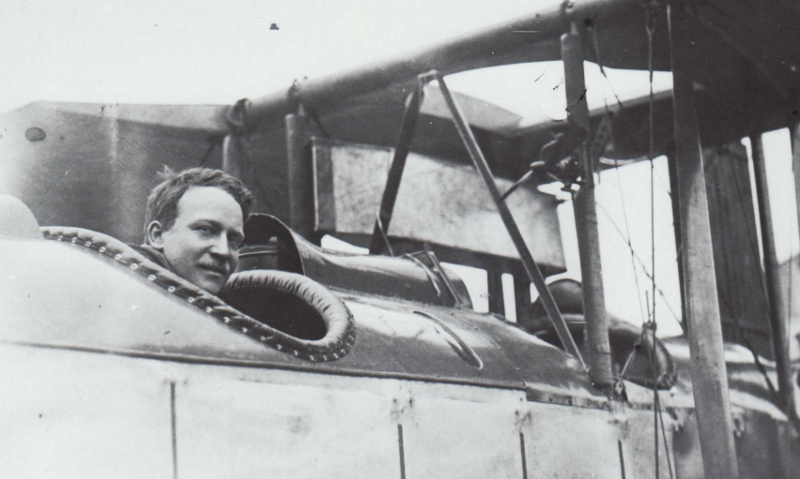
Tuesday 23rd March Victor Mahl is re-testing “Type 860” floatplane No.856 from Woolston. (above) He becomes very ill and taken to a nursing home in Southampton. Dr G H Cowen a well known local specialist recognises the symptoms of appendicitis and peritonitis and operates on him within two hours. Victor had reported feeling ill two days earlier but kept working.
On 24th March the replacement for the crashed prototype “Type 860” No. 851 is tested by Harry Hawker who has rushed down to Calshot to stand in for Victor Mahl.
On 25th March Harry is testing the fourth “Schneider” floatplane No.1439 at Calshot. It is to be packed and sent in three days time to Liverpool for HMS Engadine complete with deck-flying and side-movement trolleys. HMS Engadine is a seaplane carrier converted from a South Eastern & Chatham Railway cross-Channel packet.

By 25th March the last of the twelve Sopwith “Type 807” folders No.926 is completed by the works. They are on plan to complete thirteen new aircraft this month matching their previous best month last December.
The issues with the large “Type 860”, which have cost the life of a valued design engineer and soaked up much money and effort, are apparently resolved. Sopwith agrees to convert the experimental landplane version No.855 to a conventional floatplane and can now proceed with the twelve more of these large two-seaters.
The other aircraft on order, all for the RNAS, are the last two of twelve “SS3” single-seat scouts, the last twelve of the twenty-four “D3 Daily Mail” two-seat landplanes and eighty-two “Schneider” single-seat floatplanes.
In parallel with this seven or eight month forward aircraft order book, spares orders continue to arrive: this week for four propellers and three tall chassis for Yarmouth’s accident prone “D3 Daily Mail” landplanes.
Thomas Sopwith has fared better than most in the industry in the early days helped by his clear business vision.
In the autumn of 1913 the Sopwith Aviation Company’s smart brochure boldly stated “All work and material put into the machines will be of the highest quality only and the Company’s motto ‘Strength with Efficiency’ is to be the keynote of their construction. The Company will not adopt the policy of cutting prices which is so inimical to good work. It is absolutely impossible to maintain the highest standards of construction if the prices do not admit to the very best materials being used and the most skilled workmen being employed. The Company is prepared to undertake large orders at a moment’s notice and to complete them in stated time.”
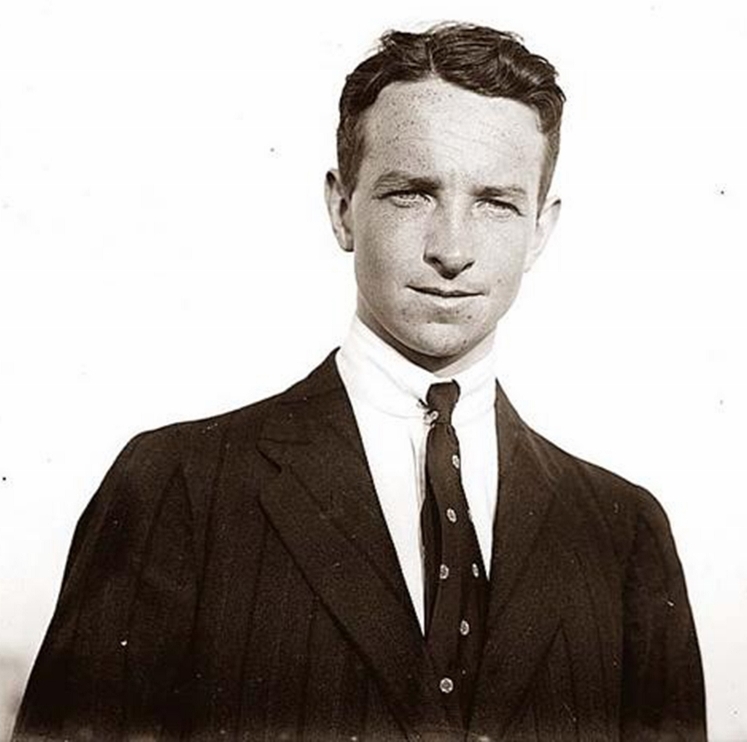
27 year old Thomas Sopwith (above) has assembled an exceptional, hard working, talented team around him who maintain these standards, especially Works Manager Fred Sigrist to whom he is still honouring a pre-war promise of up to £50 commission for every aircraft completed. As Fred exploits the efficiencies of building unexpected numbers of identical machines, he is reaping significant personal rewards and stoking the Company’s handsome profits.
Against this background and with no idea how long the war might continue, a Board Meeting is held on 25th March. De facto Chairman & Managing Director Thomas Sopwith is absent. Director & General Manager Reginald Cary chairs the meeting with the other shareholder Gertrude May Sopwith and the Company Secretary. There are some significant minutes:-
“In view of the fact that Mr Sopwith has acted in the capacity of Tests and Experimental Manager of the Company since its formation, it is resolved that he be formally appointed Tests and Experimental Manager of the Company.” “In consideration of the enormous increase in the work and responsibility in wartime”, it is resolved that Mr Sopwith’s salary from 1st October 1914 as Tests and Experimental Manager shall be much greater than his salary authorised at the December 1914 General Meeting.
“.. resolved to confirm an increases to the salary of Mr H P Musgrave Secretary of the Company from 13th March 1915, to include all overtime worked”.
“Increased risks in transport and testing. Since 30th September 1914 there have been several serious accidents to our machines not covered by insurance, the increased risks being due to 1) the urgency with which delivery is required in war necessitates machines being tested in conditions when they would normally be postponed, 2) The enforced use of heavy engines which had not previously been thoroughly tried and tested, leading to several serious accidents and pilots have had many narrow escapes owing to engine failure and explosion, 3) The lighting regulations recently enforced which have greatly increased the risk of accidents when machine have to be transported at night to testing grounds, more than one accident has been caused by failing to clear overhanging branches of trees which could not be seen in the absence of proper headlights”. “None of these risks, or the Company being liable for liquidated damages for delay in delivery, can be insured with a reputable insurance company. It is resolved that an Insurance Fund be raised transferring £100 per new machine built in the eleven months to 30 September 1914 from the General Reserve Fund to provide a nucleus and to add £1 per horsepower for each new machine leaving the works from that date”.
(Research note: National average salaries in 1915 are c.£125 per annum for craftsmen and skilled workers in engineering, c.£300 for Surgeons, Engineers and Surveyors, c.£1,350 per annum for Solicitors and Barristers)
On 26th March a “Schneider” automatic fuel tank pressure pump and its propeller are despatched for £1 5s 6d. Spares orders start to arrive for damaged ““D3 Daily Mail” landplanes Nos.1051, 57, 58 & 61 at Eastchurch, Great Yarmouth and Chingford: mostly replacement engine bearers, nose pieces and undercarriage parts.
On 27th March the thirteenth Sopwith “D3 Daily Mail” landplane No.1063 and the third this month is delivered by Harry Hawker to Hendon by air from Brooklands.
On 28th March Ark Royal’s Sopwith folder floatplane No.807 is repaired from its damage two weeks ago and Fl Lt E H Dunning is out on his own over the Dardanelles gun spotting for HMS Majestic. With ignition problems and tappets out of adjustment, the much repaired No.807 is soon to be withdrawn for a complete overhaul.
It is not just overseas that the Navy are struggling with the 100hp Monosoupape Gnome engines. On 30th March Sopwith get an urgent request for a mechanic to Birkenhead “to adjust the engine” on the recently arrived brand-new “Type 807” folder floatplane No.924.
On 31st March the fifth Sopwith “Schneider” floatplane No.1440 leaves Kingston for the Isle of Grain for testing.
On 31st March there is word of a Zeppelin attack. Two “D3 Daily Mail” landplanes Nos.1054 and 1055 go out from Killingholme on an anti-Zeppelin patrol along with “Greek” pusher No.897 but it is a false alarm.
At Cromer “D3 Daily Mail” No.1057 also sets out but suffers an engine failure during take-off and is completely wrecked in the forced landing, no one is hurt. This is particularly disappointing as the bad weather in January and February allowed very little flying from the East Coast Naval Air Stations but provided the opportunity to repair and tune the aircraft and their temperamental engines.
At Yarmouth they have also used the time to camouflage the hangars with paintings of woods and ranges of hills whilst installing an anti-aircraft Lewis gun on top of one shed and a six-pounder outside the station.
This is just one outcome of an urgent review of Britain’s defences against further Zeppelin raids after the ineffective aerial response to the first and only raid back in mid January.
Squadron Commander Spenser Grey from Calshot has been round the front line Air Stations supervising the installation of electrically triggered Holt flares under wing tips to illuminate the ground whilst landing at night.
At Kilingholme observers are now armed with German Mauser rifles with German incendiary ammunition purchased before the war, the only incendiary ammunition yet available in Britain. Observers in Yarmouth’s two-seat machines are now armed with a service rifle firing Hales grenades and a shot-gun firing chain-shot to entangle and tear fabric. They also have a Very pistol with two rounds, thought the most likely way to ignite the hydrogen in Zeppelin Airships, should they ever manage to get up to them.
On 1st April Victor Mahl’s wife visits him in the Southampton nursing home as she has done for the last eight days since his operation for appendicitis and peritonitis. She finds him “chatty and cheerful, saying he feels much better”. Probably arranged by Tommy Sopwith, a London specialist Dr Rowntree arrives to give a second opinion. He offers only dietary advice telling her that Victor is “going on nicely”.
The next morning, Good Friday, Winifred is informed that her husband died in the night. Victor was only 25. He married Winifred Day in 1912 in Wolverhampton and they have a son Eric Victor Basil Mahl less than two years old. Overwhelmed and devastated by the news Winifred demands an inquest into his sudden death.
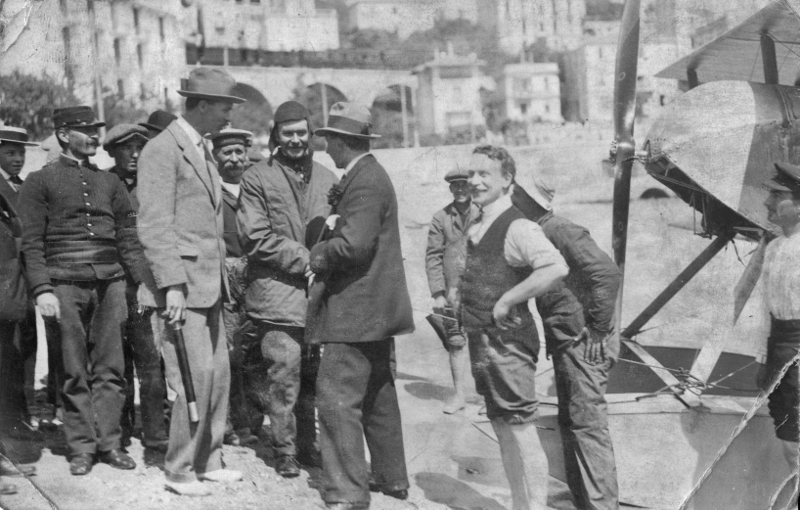
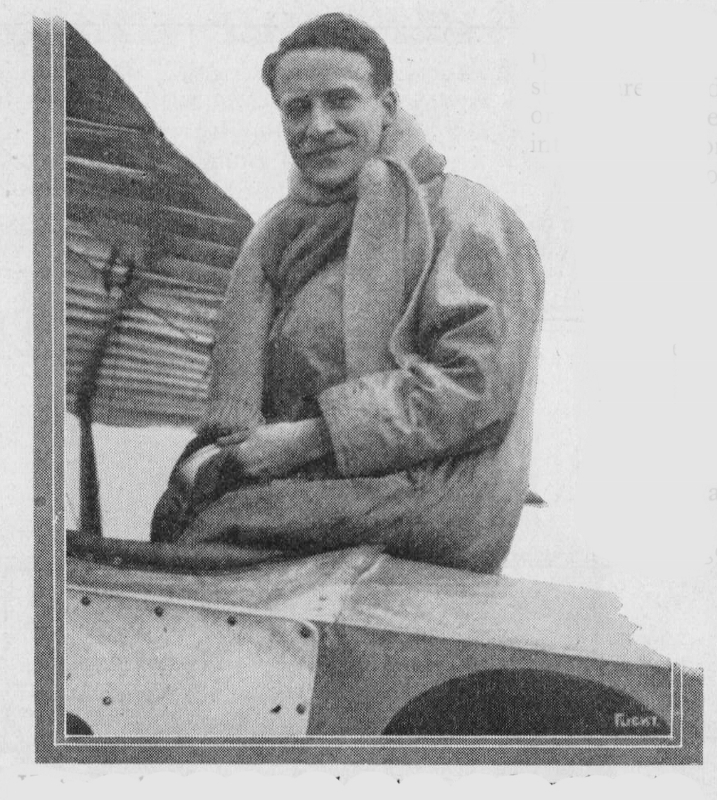
Victor Mahl 29th Oct 1889 – 2nd April 1915 Originally a motor mechanic, Victor first came to prominence in the Sopwith Company when he was mechanic for Howard Pixton and the Schneider Trophy winning floatplane in April 1914 in Monaco. (Above left as proud mechanic with sleeves rolled up) Howard Pixton gave Victor flying tuition when they returned to England and he became Sopwith’s lead test pilot on floatplanes at their Woolston Works, Southampton. (Above right as a pilot)
On 2nd April Cull’s team set up a shelter from the sun on the beach at Shimanzi in Mombasa (below with the the hospital ship Gascone behind) to repair the floats and further attempt to improve the performance of their only remaining aircraft Sopwith “Type 807” No.920. It is flown after this but the RNAS East Africa Expeditionary Force leaves it behind when they sail on to Durban to collect their more powerful Short machines.
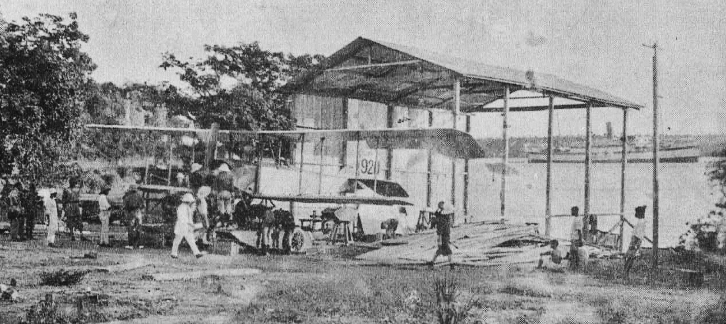
By 2nd April 1915 the Sopwith works have completed the eleventh “SS3” scout No.1211 ready to go to Eastchurch and the sixteenth “D3 Daily Mail” landplane which Harry Hawker flies to Hendon the next day.
The tests on the prototype “Schneider” floatplane No.1436 at the Royal Naval Air Station Isle of Grain lead to orders for a mechanic to fit bomb gear and for the supply of copper petrol and oil tanks.
Sopwith’s order to fit free-issue bomb dropping gear to new “D3 Daily Mail” landplanes and “Type 860” floatplanes is amended to include “windshield and sighting holes for pilot and passenger, permitting rifle fire”.
Other Admiralty orders this week include five free-of-charge replacements for “distorted engine rods”, a replacement tail float strut to HMS Campania, two induction pipes and aircraft repair work at Great Yarmouth.
RNAS spares support is increasingly pro-active. A large order arrives for floats, folding quadrants, mainplanes and a tail unit for the three new Sopwith “Type 807” floatplanes recently sent to HMS Campania at Birkenhead. This is followed by orders for 12 sets of engine spares and six propellers for “D3 Daily Mail” landplanes; major spares for “Type 860” and “Schneider” floatplanes on seaplane carrier HMS Ben-my-Chree and similar “Schneider” spares for HMS Engadine. At £3,464 10s 8d, these orders are as valuable as three new aircraft.
On 5th April “Schneider” floatplane prices are reduced by £11 4s 0d to reflect delivery of engine starter gears without magnetos whilst bomb gear, instruments and deck trolleys are added at no extra cost.
The shortage of magnetos is a big issue. With German Bosch pre-war stocks run down and the only UK maker Thompson Bennett, now owned by Lucas, slow to match demand, many have been brought in from the USA.
The three British spark-plug makers have also struggled to meet the huge increase in demand from all quarters.
On 5th April “Type 807” folder No.810 catches fire whilst taxying, only the wings are salvaged going to No.919.
On Easter Monday 5th April the inquest into Victor Mahl’s death confirms that the operation nine days before he died had been “skilfully and properly performed, the cause of death was septicaemia following appendicitis and there was also peritonitis”. The Deputy-Coroner concludes there is nothing to show that an inquest was necessary and the wife of the deceased ought to be present as he wants to know what dissatisfaction she had with the death certificate. When he is told that Mrs Mahl is “prostrated” the inquest is adjourned.
On 7th April there is a funeral for Victor Mahl in Chiswick, where his parents live. Alongside the family are Mr and Mrs Sopwith, Mr Sigrist, Squadron Commanders Travers and Briggs, Lieutenants Travers and Courtney, and Flight Sub-Lieutenants Travers, Hillard and Greer. Floral tributes include a number from the Sopwith Aviation Company and from officers and men of the Royal Flying Corps/Royal Naval Air Service.
On 7th April the factory completes “Schneider” floatplane No.1441 ready to go to Calshot and HMS Engadine. Aeroplane magazine reports that Harry Hawker is now testing Sopwith small floatplanes and has been seen “looping the loop”. “Despite the floats, the first loop and the others that succeeded it were as perfect as those which the same pilot is accustomed to do on land machines.”
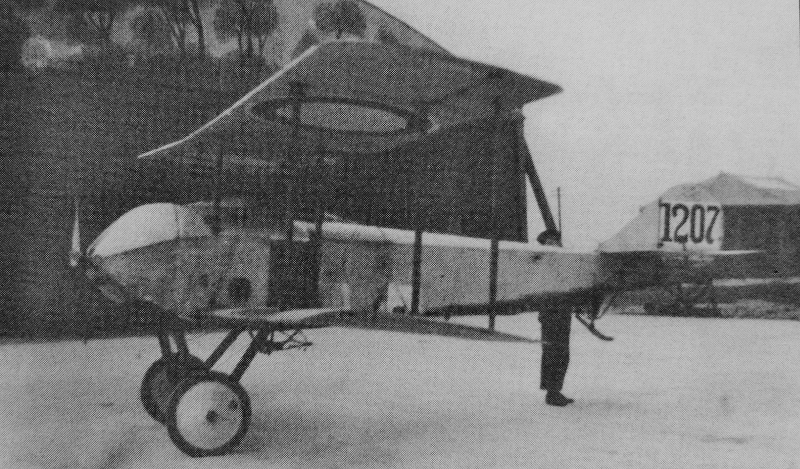
Sopwith 80hp “SS3” single-seat scout No.1207 is back at Yarmouth after repairs to the ailerons. In the portrait (above) the little machine is held up in flying position in front of one of the tree painted “camouflaged” hangars at Yarmouth sporting its large RNAS red ring on white disk under-wing roundels and a bomb carrier under the cockpit. On 8th April Harry Hawker re-tests this machine but overturns it on landing and it is again to go back to Kingston from Yarmouth for repairs.
On Saturday 9th April the inquest into Victor Mahl’s death is resumed. Mrs Mahl tells the court that she is now satisfied and has no allegation to make as to the medical or surgical treatment to her husband. Her reason for calling an inquest was the sudden termination of the illness after he was so cheerful the day before and said he felt much better. The jury returns a verdict of death from natural causes following appendicitis and lodge a complaint that they should never have been called and should be compensated for lost income.
Recognising the limitations of operating floatplanes in the Aegean from HMS Ark Royal and their unsuitability for reconnaissance over land, the RNAS have recalled Commander Samson from his daring front-line bombing and armoured car adventures in Belgium and northern France and sent him to the island of Tenedos with a hastily gathered mixed bag of RNAS landplanes. In anticipation of his arrival a vineyard has been grubbed up and turned into a fine airfield by a large gang of Greek labourers. He has a 50 strong support team, 11 pilots, and 17 aeroplanes all but five of which he considers “not very much use”, including two single-seat Sopwith “SS3” scouts Nos.1205 & 1206. They are fast and have a gun above the wing but “have a habit of shaking out their engines” and cannot carry an observer for reconnaissance or wireless equipment for ships’ gun directing.
On 9th April 1915 two Sopwith “Schneider” floatplanes arrive for Ark Royal. They are erected within two days. No.1438 is pictured (below left) being hoisted out for its first flight. Single-seaters are not very useful for Ark Royal’s current role and No.1437 (below right) is passed to cruiser HMS Doris for her buccaneering attacks from off the Syrian coast and the Bay of Smyrna on supply-lines to the Turkish army moving towards the Suez Canal. Her aircraft are used for spotting targets for the ship’s guns and for dropping small bombs, mostly on railways.
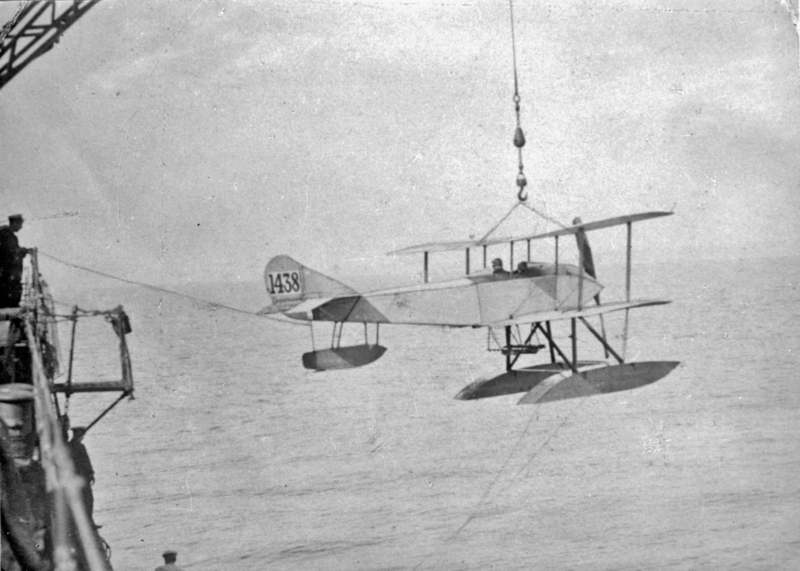
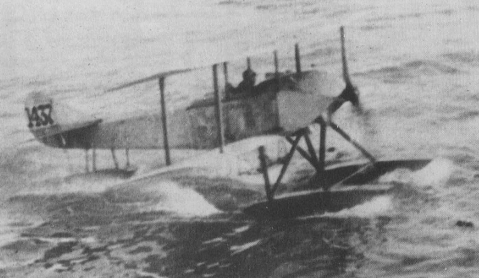
On 12th April Calshot order a new pattern tail float for their “Schneider” No.1439 and the free supply of seven gallon larger fuel tanks for all three Schneider floatplanes at Calshot. All these are despatched in two days. Urgent orders also arrive for six “Schneider” deck-flying trolleys and two deck handling trolleys for the larger “Type 860” floatplanes for HMS Ben-my-Chree at Parkstone Quay, Harwich.
On 13th April the Admiralty, obviously unaware “Type 807” folder No.921 has been left in Mombasa, order engine bearers and a magneto belt drive for No.921 “to go to Lt Cmdr Cull on AMC Kinfauns Castle”.
At 1am on 16th April a two-seat Sopwith “D3 Daily Mail” landplane is scrambled from Yarmouth but after an hour returns having seen no Zeppelins. At 4.30am another goes up but in poor visibility sees nothing and hears nothing over the noise of its engine. The impressed Sopwith “1914 Circuit of Britain” racing floatplane No.880 is also despatched. She hits a sandbank whilst taking-off and after chasing an airship is damaged on landing.
At Killigholme “D3 Daily Mail” No.1054 goes out searching and overturns on landing.
Reportedly seeking industrial Humberside, Zeppelins L5, L6 & L7 drop eighty-one bombs and incendiaries that night over Chelmsford, Lowestoft and Southwold damaging property and injuring a girl. Hit by ineffectual rifle fire they all get home.
Sopwith promptly receive telephoned orders for “a complete set of planes with struts, wires etc. and a landing chassis with wheels, tyres, tubes” for No.1054 and for “replacement main floats with all fittings” for No.880. Delivery is immediate for the first order but No.880’s special floats will be three weeks. The total value is £442.
On 16th April the factory completes the last of the twelve “SS3” scouts for the RNAS, followed the next day by the fifteenth of the twenty-four “D3 Daily Mail” landplanes and the seventh “Schneider” floatplane.
On 19th April two-seat 225hp Sopwith “Type 860” floatplanes Nos.857 & 860 arrive in the Aegean for Ark Royal but she has no space to unpack and erect them with seven machines already aboard. It could be weeks before an empty collier or steamer can be spared long enough during hostilities for the deck to be used for this work.
The RNAS are also beginning to deploy these large “Type 860” floatplanes at home after the modifications and No.851 lifting a torpedo earlier this month. Nos.852 & 856 are now on Ben-My-Chree and No.859 is at Dove r.
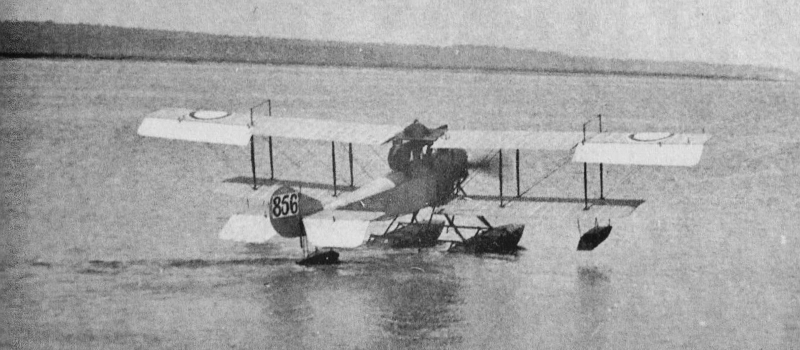
No. 856 taying away from HMS Ben-my-Chree
On 17th April Sopwith takes an order for four pairs of chassis inter-float cross struts for “Schneiders” on HMS Engadine and on 18th April another for 12 sets of wheels for “D3 Daily Mail” landplanes at Hendon at £6 16s 6d each. Other urgent orders this week are for a “new type landing gear” for a “D3 Daily Mail” at Killingholme and a replacement worm and wheel for the wing folding gear of “Type 860” No.856 on Ben-My-Chree.
On 19th April Sopwith completes the conversion of “Type 806” Pusher No.802 to 150hp. This same day there is an accident repairing sister-ship No.803 which creates more work for the busy factory.
On 21st April the Sopwith Aviation Company receives an order for another fifty 100hp “Schneider” single seat floatplanes bringing the total to one hundred and thirty-six. No other Sopwith design has exceeded twenty-four examples and the Sopwith design team are working on a more powerful version of the “Schneider” which could also be ordered in large numbers.
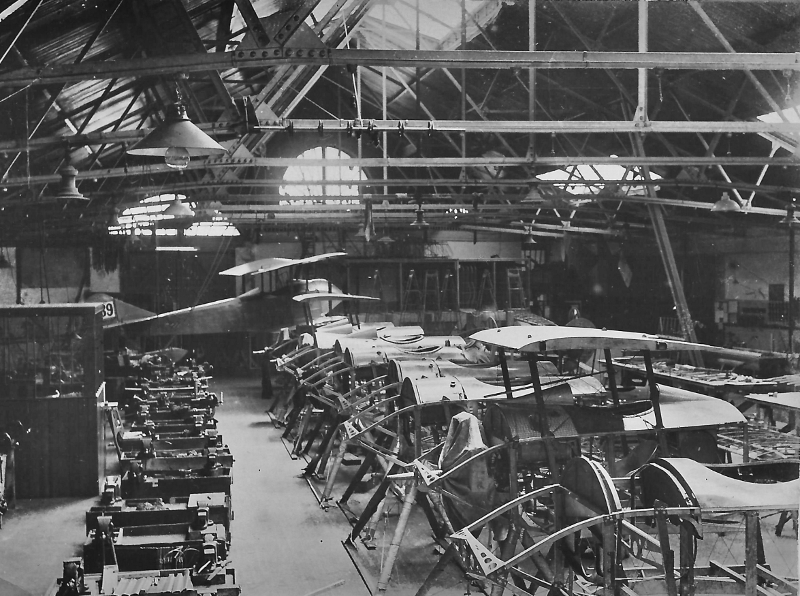
Sopwith “Schneider” final assembly is in the old Skating Rink factory with its distinctive arched front windows (photo above). Built in the new factory, the bare front fuselages are now each lined up facing a work bench. They are receiving fuel tanks, dashboards, instruments, cabane struts with top wing centre sections, and their 100hp Gnome engines with all the ancillary equipment and self-starter. The trial-rigged machine will only need the wings removed to be transported to Woolston by road.
On 22nd April the seventh “Schneider” No.1442 is another candidate for the Company’s new Insurance Fund when it crashes on company tests at Woolston and needs to be repaired before delivery to the RNAS.
Meanwhile, the first “Schneider” floatplane from the second order No.1556 is delivered to Calshot but needs a new fuel tank which is delivered free of charge in time for it to go aboard HMS Engadine on 26th April.
There have been few gains on the Western Front through the bad winter. The French have suffered 240,000 casualties but failed to make real progress in Artois or Champagne whilst British and Indian troops have taken Neuve Chapelle but with 11,200 casualties and a lack of reserves to push on to take the strategic Vimy Ridge.
On the evening of 22nd April the Germans launch an intense bombardment on the salient around Ypres and deploy a new weapon, sending troops forward behind clouds of chlorine gas. The French have no protection and retreat 5 miles but now it is the Germans who lack the reserves to sustain the push.
On 24th April impressed “Gordon Bennett Racing Tabloid” No.1214 from the Fast Flight at Hendon goes via Dover to No.1 Squadron RNAS at St. Pol. This is the first Sopwith machine in France for three months. That same day “D3 Daily Mail” landplanes Nos.1064 & 1065 transfer from Hendon to Chingford Air Station for anti-Zeppelin work and Sopwith deliver another “Type 860” floatplane No.928 to Calshot.
In the Aegean, a 75,000 strong army is now ready and waiting for good weather to land on the southern half of the Gallipoli peninsula. The single objective of all these British, French, Australian and New Zealand forces is to “reduce the forts at the narrows so that the fleet might pass through the Dardanelles straights”. In the last few days Ark Royal’s floatplanes and Cdr Samson’s landplanes have provided valuable information by surveying the Turkish positions, whilst directing heavy naval gunfire and attempting to bomb key enemy emplacements.
From first light on 25th April the British 29th Division and three battalions of the Royal Naval Division are landing on five beaches around Cape Helles on the toe of the Gallipoli peninsula with French colonial forces making a temporary landing on the opposite, Asiatic, side of the entrance to the Dardanelles straights.
The Australian and New Zealand Army Corps (ANZAC) is also landing in force but further up the west coast of the peninsula at its narrowest part in a plan to cut off the Turkish defenders tackling the British in the south. They are put ashore over a mile off-target and faced with steep cliffs.
The landings do not go at all smoothly, and there are huge numbers of casualties from artillery shells or mown down by machine gun fire. In the fine weather Samson’s RNAS landplanes are up all day over Helles and the Asiatic coast, most pilots making three long flights, their observers reporting key enemy locations. With so many obvious visible targets for the British warships’ gunners they do not initially heed the wireless messages from the air. The aircraft also bomb guns, camps and troops, take photographs and reconnoitre the whole peninsular providing up-to-date reports on the rapid movements of Turkish troops. Samson’s fast Sopwith Tabloid “SS3” scouts are readied to chase enemy aircraft but none appear. No 1205 (below) has extra cooling slots in the nose and a standard infantry Lewis machine gun on the top wing with just one 47 round magazine.
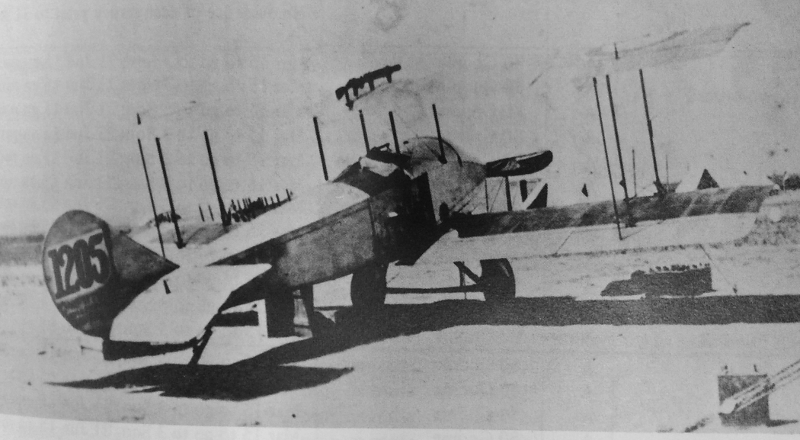
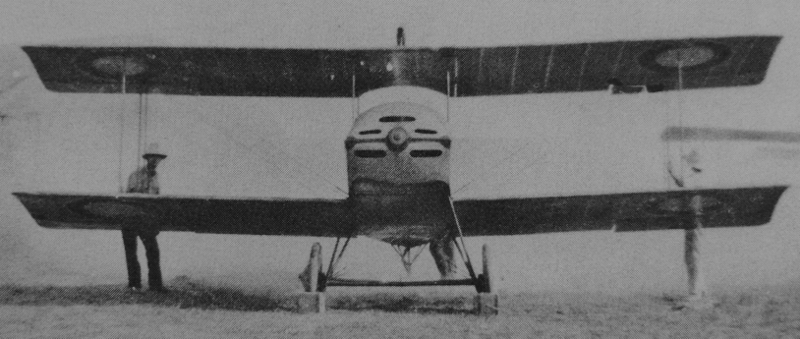
Ark Royal’s floatplanes and a kite balloon support the ANZAC forces. HMS Manica’s kite balloon proves useful. It is even able to spot a Turkish battleship firing from the narrows on the other side of the peninsula and direct long-range heavy Royal Navy gunfire to force its retreat. The floatplanes struggle to see the Turkish batteries concealed in the ravines and dense scrub but frequent patrols at least force the Turks hold back their fire for fear of being located. “Schneider” floatplane No.1438 is damaged on landing back at Ark Royal.
By dusk footholds have been established at all five beaches around Cape Helles but the allied forces are far short of their planned first day objectives. The ANZAC front line is only just over the cliff top. Most of their 20,000 men are in makeshift scrapes and burrows on the sloping cliff face with little protection from shelling.
On 26th April after just two days in service and on its first test flight from HMS Ben-my-Chree, “Type 860” floatplane No.928 crashes from 600 ft after banking slightly with the engine throttled back possibly intending to alight but side-slipping into a nose dive beside the ship. Fl Lt S. Medlicott and AMI H. G. Hughes are both killed.
On 26th April “Schneider” No.1443 is completed and goes directly to HMS Engadine for anti-Zeppelin duties.
By 28th April “D3 Daily Mail” No.1066 and “Type 860” No.929 are also completed bringing the total Sopwith new aircraft built this month to twelve and raising the average output this year to two and a half per week.
There is a change to the second “Schneider” order. Sopwith are to supply accumulators & coil ignition for the starter gear and magnetos for seven of the 24 aircraft. Spares orders this week include a pair of main floats for “Schneider” floatplanes on HMS Engadine and six propellers for those on HMS Ark Royal in the Mediterranean.
The desperate fighting continues in the Dardanelles campaign. A major offensive on 28th April fails against fresh reinforcements brought up by the Turks.
Overnight on 29th/30th April there is an unopposed first raid by a German Army Airship. L.Z.38 drops 76 bombs and incendiaries over East Anglia burning down two houses in Ipswich and four in Bury St. Edmunds. When the thick mist eventually clears after 4am Yarmouth “D3 Daily Mail” landplanes Nos.1052, 1053 & 1056 go out searching over the North Sea but in vain.
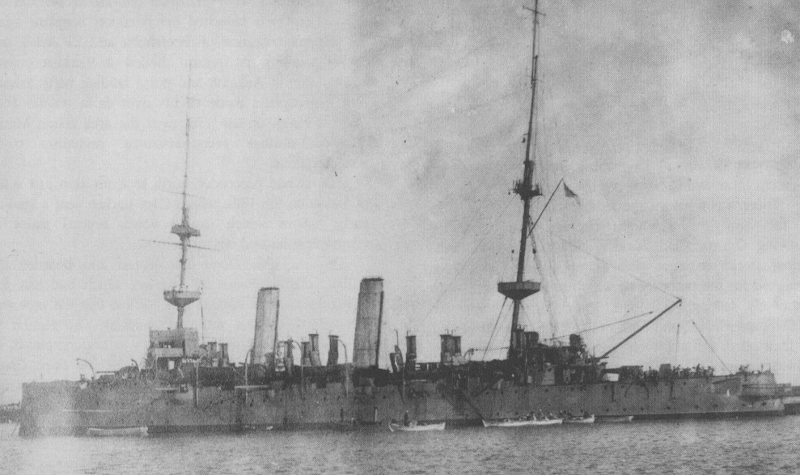
On 29th April “Type 807” two-seat floatplane No.922 is returned to Ark Royal for repairs from cruiser HMS Doris (above) in the Eastern Mediterranean after just six days aboard. Stored under the derrick on the aft quarterdeck, between anti-submarine searches, this light wooden machine has been shaken by the shock from the ship’s eleven 6-inch guns and fabric stripped from the fuselage.
At Kingston on 30th April a works order triggers the collection from Brooklands of 150hp Sopwith “Type 806” Gunbus No.803 and its delivery by passenger train to Robey and Co. in Lincoln. Discussions are underway with Robey to licence-build thirty of these large machines which Sopwith do not have the space to construct. This sample machine will allow Robey to assess the work involved whilst negotiating the contract with Sopwith.
The Sopwith 200hp “Type C” torpedo floatplane No.170 and impressed “1914 Circuit of Britain” 225hp Bat Boat II No.879 are now deleted from service by the end of April after being unserviceable for some time. Both were large and unique. On 2nd May in the Gulf of Smyrna HMS Doris salves her “Schneider” No.1437 from sinking after damaging a float on landing. It will have to follow No.922 to HMS Ark Royal to be repaired.By 2nd May three new “Schneider” floatplanes Nos.1444, 1445 & 1557 are completed and go directly to Felixstowe for an extra delivery charge of £73 5s 10d. Harry Hawker is at Great Yarmouth on 2nd May re-testing the repaired “SS3” scout No.1207 he overturned on its first test. On the 3rd May he is at Felixstowe testing these “Schneider” floatplanes which go immediately to seaplane carriers Engadine, Ben-my-Chree and Riviera.
On 3rd May a large Harwich naval force sets out with Short floatplanes to attack Zeppelin sheds and their radio station using “Schneiders” to intercept Zeppelins but choppy seas make it impossible to launch any floatplanes.
On 5th May “Greek” 100hp Gnome engined pusher No.897 is overturned & wrecked at Killingholme when its undercarriage is caught in barbed wire on take-off. This just leaves No.900 which has been at Eastchurch since late January after repair by Handley Page. The others only survived a few months: by December 1914 No.898 was wrecked at Hunstanton, No.901 had crashed at Morbecque and No.899 was wrecked at Killingholme.
By 6th May there is deadlock on the Gallipoli peninsula and a call for more troops but they are not promised until July. Ships and aircraft continue to support the land forces. A small rough vulnerable aerodrome is established on Helles beach for observers to land and report urgent information directly to corps headquarters.
On 6th May the large naval force from Harwich sets out again with floatplanes to reconnoitre new Zeppelin sheds at Hage, bomb their radio station and attack any Zeppelins but this time runs into fog and is thwarted.
By 6th May impressed Italian “Tabloid” No.1213 is at St. Pol in France with Gordon Bennett “Tabloid” No.1214 whilst “Schneider” No.1442 finally enters service at Dover after its testing mishap before delivery on 21st April.
On 7th May HMS Campania’s “Type 807” floatplane No.924 is completely wrecked. With No.926 temporarily dismantled, this only leaves No.925 on the ex-Cunard Blue-Riband Atlantic liner. (Campania below, with her as yet unused 120ft forward flying-off platform)
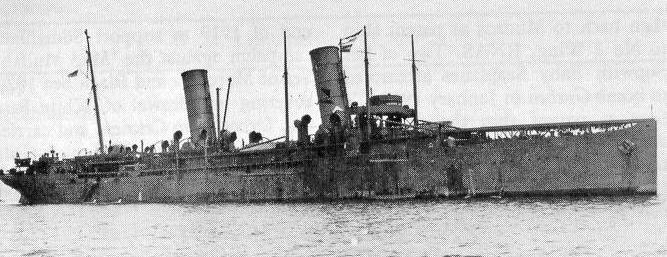
A spares order arrives this week for a chassis and floats for folder No.807 on Ark Royal. Other orders are for seven sets of chassis for the accident prone “D3 Daily Mail” landplanes: two “3ins not 7ins higher than original”, two with “springs more elastic” and three with “tyres 750×125” and for two “improved chassis” for similar machines at Dover.
On 9th May two new “Schneider” floatplanes Nos.1446 & 1558 are delivered directly to Great Yarmouth at an extra cost of £43 15s 6d whilst the two crated 225hp “Type 860” floatplanes in the Aegean are finally transferred to the store-ship HMS Penmorrah to be erected for use on HMS Ark Royal.
On 9th/10th May another attack by Zeppelin LZ38, this time on Southend, brings out eleven aircraft from five RNAS airfields including Yarmouth’s “D3 Daily Mail” landplanes Nos.1052 & 1053 without any sightings. An 18 page Southend Standard report illustrates the damage and describes the raid in detail. The mildly worded but already controversial D-Notice D206 asking editors not to publish information of use to the enemy will need stronger wording.
On 11th May 1915 at Great Yarmouth Harry Hawker tests the new “Schneider” floatplanes Nos.1446 & 1558 which have just arrived. No.1558 is fitted with “rifle and pistol packs”. Meanwhile the factory completes “Schneider” No.1559 to be tested at Woolston before despatch to HMS Campania in the Firth of Forth.
Out in the North Sea on 11th May the Harwich naval force of light cruisers and destroyers accompany seaplane carriers Engadine, Riviera and Ben-my-Chree in another attempt to attack the Zeppelin sheds and their radio station on the north German coast. Fast ex-Isle of Man packet ship HMS Ben-my-Chree (“Woman of my Heart” in Manx) has a large canvas hangar at the stern and a demountable flying-off platform over the bow. (photos below)
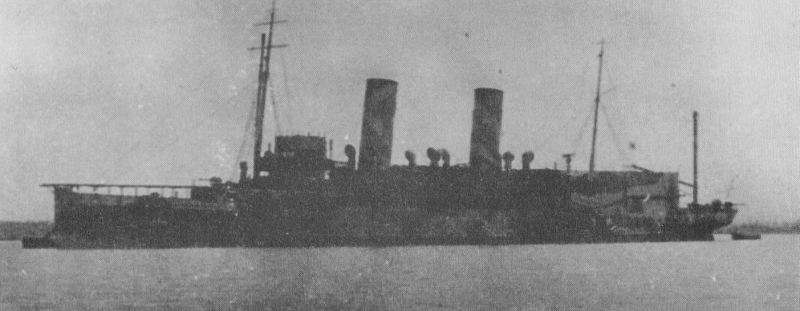
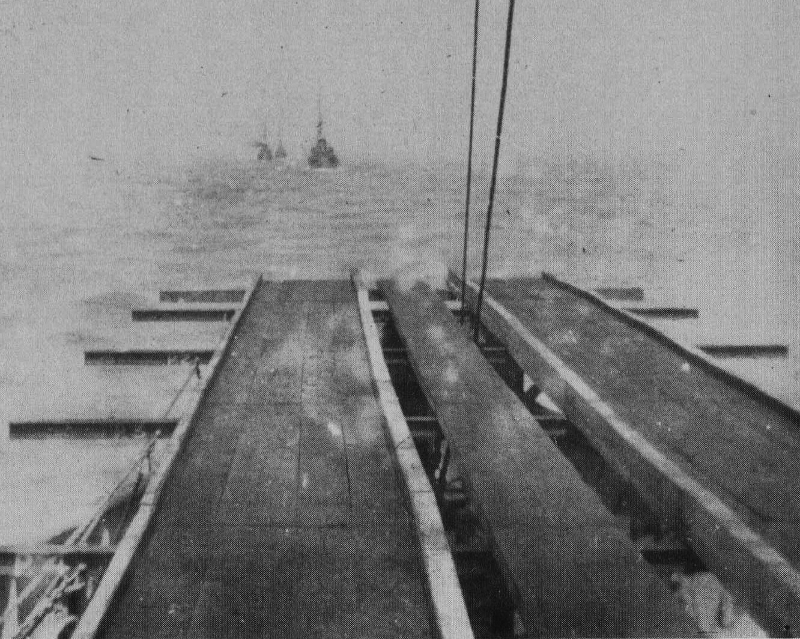
“Schneider” floatplane No.1445 is on its deck-flying trolley on that platform ready for a first-ever wheeled launch when at 4.10pm a Zeppelin is spotted. However, the 100hp Monosoupape Gnome engine backfires and wrecks its starting gear, the crank-handle breaking the pilot’s wrist and knocking instruments out of the dashboard. Meanwhile ex-Cross-Channel packet HMS Engadine is hoisting out her three “Schneider” floatplanes. They all get away but fail to find the Zeppelin. With the fog closing in, only one returns. No.1443 spins into the sea with the loss of pilot and machine. The third, No.1444, crashes alighting on the sea after engine trouble. The pilot is rescued and the machine salved but it is damaged beyond repair.
On 12th May in the Aegean Ark Royal’s just repaired “Type 807” folder No.922 is damaged yet again on landing.
On 13th May Sopwith take an Admiralty order for thirty “Type 806 Gunbus” pusher landplanes to be fitted with free-issue 150hp Sunbeam engines. The aircraft are priced at £1450 each. With 60 safety belts, 60 propellers and 30 packing cases the total order value reaches £45,589 10s 0d. Sopwith’s draughtsmen are working on a set of detailed manufacturing drawings whilst discussions continue with Robey about licence building these.
RNAS Sopwith aircraft are now widely dispersed around the coast. Calshot based “Type 807” folder No.919 is currently at Bembridge on the Isle of Wight. “Type 860” No.853 is at the Isle of Grain at the mouth of the Medway in Kent after its rebuild as is the first “Schneider” No.1436 but for repair after a spell at Felixstowe.
On 16th May newly built “D3 Daily Mail” landplanes Nos.1067 & 1068 go all the way to Fort George near Inverness for erection before deployment to Montrose.
On 16th May 225hp “Type 860” floatplane No.855 is delivered to Calshot after conversion from an experimental landplane but on 17th May piloted by Harry Hawker it fails its RNAS acceptance tests and will need more attention.
On 17th May LZ38 drops bombs on Ramsgate and Dover and “Type 860” No.859 goes out from Dover after her. LZ38 becomes the first airship to be illuminated by searchlights over Britain and the first to be spotted by a defending pilot, although he cannot catch it. Some alerted Dunkirk aircraft find a sister Zeppelin at 10,000ft and are able to attack and bomb it, the first British pilots to damage one in the air.
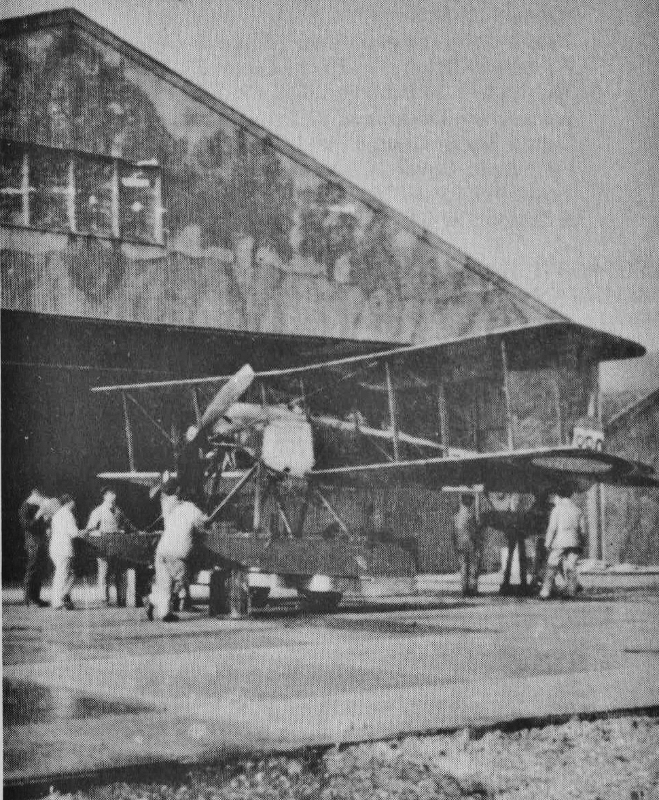
On 17th May the impressed Sopwith 100hp Gnome “1914 Circuit of Britain” floatplane No.880, with brand new floats after hitting the sandbank on 16th April, is prepared outside Yarmouth’s tree painted hangars (above). It goes out on an anti-Zeppelin patrol and is completely wrecked on landing.
With the failure of three successive attempts to attack German North Sea coast airship installations with 100hp Sopwith “Schneider” floatplanes, the ex-packet ship seaplane carriers are dispersed from Harwich. HMS Engadine goes to the Firth of Forth to work with the battle cruiser fleet, HMS Riviera to Dover and HMS Ben-my-Chree to the eastern Mediterranean. HMS Engadine is allocated “Type 860” floatplanes Nos.852 & 858. In a new approach to thwarting the Zeppelin raids four armed steam trawlers have been adapted to carry a “Schneider” floatplane. One is kept on station at all times some 50 miles out in the North Sea. Usually it is HMS Kingfisher out there for weeks on end with a Yarmouth pilot. Weather permitting; he patrols the aircraft daily for an hour before dusk in search of airships going to Britain, and again at dawn after any reported raids. By 19th May “Schneider” No.1447 has joined No.1442 at Dover and both are formally tested by Harry Hawker. Also on 19th May “Type 860” No.932 is completed but is to be retained by the Company at Woolston for further trials with this troubled type. On 20th May “D3 Daily Mail” landplane No.1069 is completed. This one goes to Barry for erecting for immediate deployment to Montrose on the east coast of Scotland. With just three more “Type 860” floatplanes in the works and the last four “D3 Daily Mail” landplanes on target for delivery in June there will soon only be “Schneider” floatplanes in production in Kingston. Some effort can now be diverted to Fred Sigrist’s innovative private-venture two-seat landplane. Nicknamed the “Sigrist Bus”, it has had to be put aside for more urgent work many times since work started last December. The works have also been tasked with fitting a Green engine to a hydroplane “as per Mr Sigrist’s instructions”. It appears that Tommy Sopwith & Fred are still indulging their passion for fast boats when they do get time off. On 20th May Sopwith despatch a “150hp Pusher” on a 26ft truck by passenger train to Pemberton-Billing’s works for repair and on 21st an urgent replacement propeller for “D3 Daily Mail” No.1065 to Chingford.On 23rd May 80hp Sopwith “SS3” Tabloid landplanes are used for the first time on home defence duties. At 9.30am a German Albatross floatplane drops several bombs by ships near the Goodwin Sands and is sighted off Westcliff-on-Sea. Nos.1209 &1211 go out from Eastchurch at 10.02 and 10.15am but fail to make any contact. No.1212 from the Defence Flight at Westgate on the north east tip of Kent makes a similar unsuccessful search.
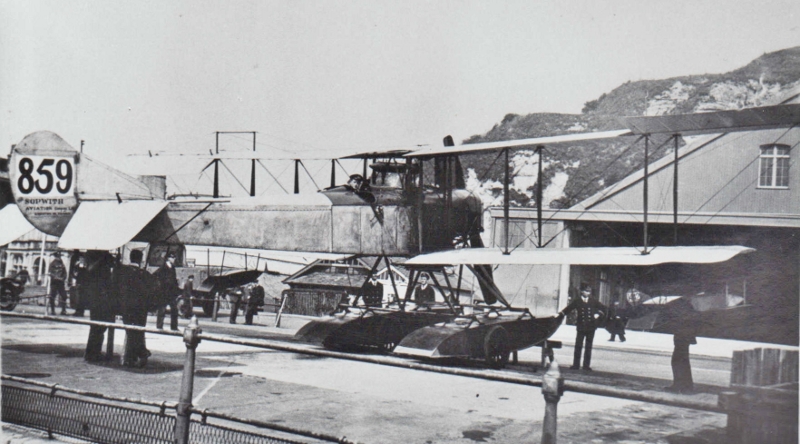
“Type 860” No.859 based at the Naval Air Station under the cliffs at Dover (photo above) has been testing an observer’s microphone and yesterday had a new set of floats delivered from Kingston. With or without the new floats, No.859 goes on a hostile aircraft patrol on 23rd May, capsizes on the water and is wrecked.
This is an eventful day at Dover. “Schneider” floatplane No.1442 after two weeks on station and one anti-Zeppelin patrol, also goes out after the enemy aircraft and also capsizes on the water. It will need to be rebuilt.
In the Aegean the two 225hp Sopwith “Type 860” floatplanes which arrived there for HMS Ark Royal on 19th April are finally erected on store ship HMS Penmorvah. No. 857 has been test flown over the last few days. On 23rd May No.860 is tested and can be pictured at last on the deck of HMS Ark Royal (photo below).
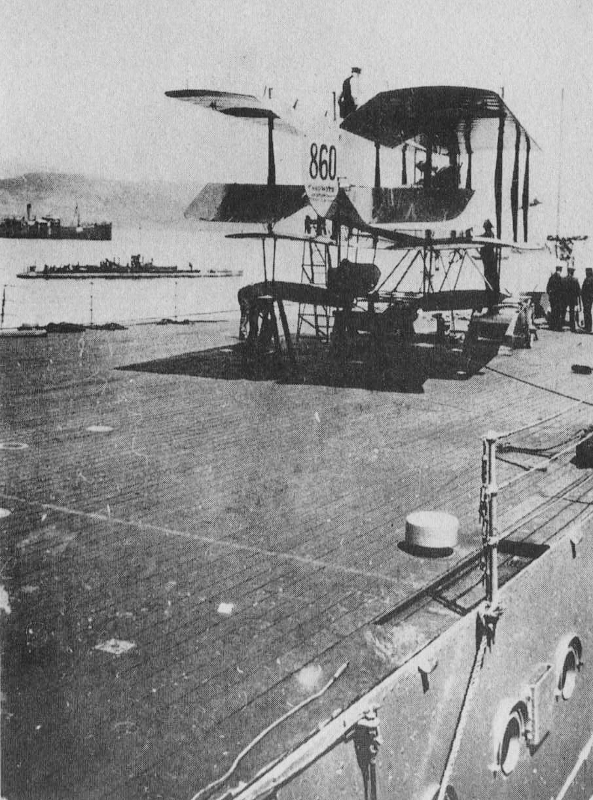
New floatplanes are sorely needed in the Aegean as Fl Lt Sholto-Douglas testing their “Type 807” folder floatplane No.922 after its latest repairs fails to coax it above 800 ft. The “carbonised” engine is changed but the performance is even worse.
Yarmouth Air Station, tasked with sending up a two-hour Zeppelin “scaring-off” patrol each night before dusk, report that half of their machines are out-of-service. There are particular problems with 80hp Gnome engines overheating and three of their Sopwith aircraft have engine problems: a failed obturator ring and a faulty oil system on“D3 Daily Mail” landplanes Nos.1052 & 1056 and bad vibration on “SS3” scout No.1208 .
Felixstowe based “Schneider” floatplanes Nos. 1440, 1441, 1556 & 1557 are being used to familiarise crews of operational RN ships with handling and stowing these small machines. Seaplane-carriers HMS Engadine and HMS Riviera have already been involved this month plus HMS Penelope, a 3,500 ton Arethusa Class light cruiser. (below left)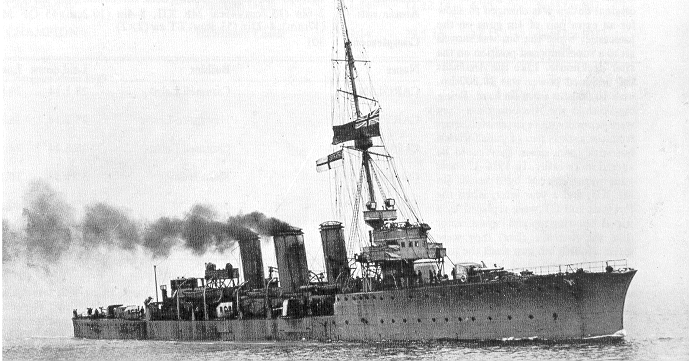
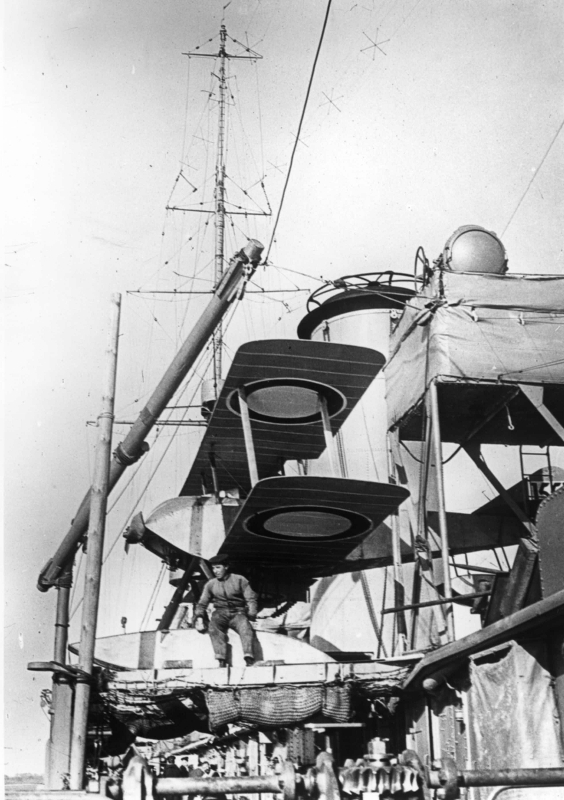
On 24th May No.1557 is pictured (above right) stowed on sister-ship HMS Aurora on the port side abaft the third funnel. In the next few days HMS Undaunted and HMS Arethusa will be visited.
Sopwith remain a willing and rapid source of supply for the Admiralty. It is not unusual to despatch items the same day, however, on 25th May they receive an order for “82¾lbs of 0.06 bullet proof steel plate” delivered four days ago to the Aircraft Stores at Wormwood Scrubs Central Supply Depot. It is invoiced at £5 15s 9d.
On 25th May “D3 Daily Mail” No.1064, at Chingford for under a month, is crashed and wrecked by Fl Lt Pulford.
On 25th May Liberal Prime Minister Asquith forms a Coalition Government with the Conservatives. One of their conditions is the dismissal of the First Lord of the Admiralty Winston Churchill. On 26th May he resigns eleven days after his First Sea Lord, Lord Fisher, resigned horrified by the failures and loss of life in the Dardanelles. Churchill is a sad loss to the RNAS in particular. He started and powerfully backed the Admiralty Air Department under Murray Sueter and has taken a keen interest in the rapid development of naval aviation.
On 26th May “Type 860” floatplane No.933 is completed by the works. That same day Nos.929 & 930 are being tested by Harry Hawker at Dundee after delivery there on 17th and 21 st May. Harry is doing a lot of travelling.
At 11.15pm on 26th May Zeppelin LZ38 bombs Southend killing three people. At 11.20pm “SS3” scout No.1210 is one of five aircraft sent out from Eastchurch and Grain but LZ38 is away before they can clim b to her altitude.
On 29th May Sopwith despatch new “Schneider” floatplanes Nos.1560 & 61 and spares directly to Harwich just four days after new instructions from the Admiralty. They are to go with HMS Ben-my-Chree to the Aegean.
On 30th May “Schneider” No.3707 is completed to be tested at Woolston with No.1559 and sent to Campania. The next day “D3 Daily Mail” landplane No.1070 is also completed making May a record month for the Sopwith works. Eighteen new machines bring the year-to-date total to sixty and the average rate to three per week.
A German U-boat is the new threat in the Aegean having just sunk HMS Triumph and HMS Majestic. On 30th May Fl Lt Bromet and CPO Finbow are on anti-submarine patrol in a new “Type 860” floatplane for just an hour when the engine cuts. They make a forced landing and are towed back by motor torpedo boat to Aliki Bay on Imbros. On 31st May Fl Lt Kershaw and CPO Finbow only achieve a 45 minute flight in the other new “Type 860” when that engine cuts out. Thus far, the 225hp Sunbeam engines are not living up to their promise.
On 31st May the Sopwith “Type D” No.103 arrives at the Repair Depot at Grain from training duties at Eastchurch, the end of the twenty-one month active career of the oldest Sopwith machine still in naval sevice.Also on 31st May Sopwith take an order for another 100 “Schneider” type floatplanes. The Admiralty team in Paris have negotiated the supply of 110hp nine-cylinder Clerget 9Z rotary engines. With 10% more power than the Gnome Monosoupape, these have more conventional inlet and exhaust valves operated by separate push rods. Mounted in the aircraft only by the two back plates on the stationary crankshaft they will not have the forward bearing on the propeller shaft giving the machine a distinctive short blunt nose. To be known as Sopwith “Baby” floatplanes they will also have a larger vertical fin.
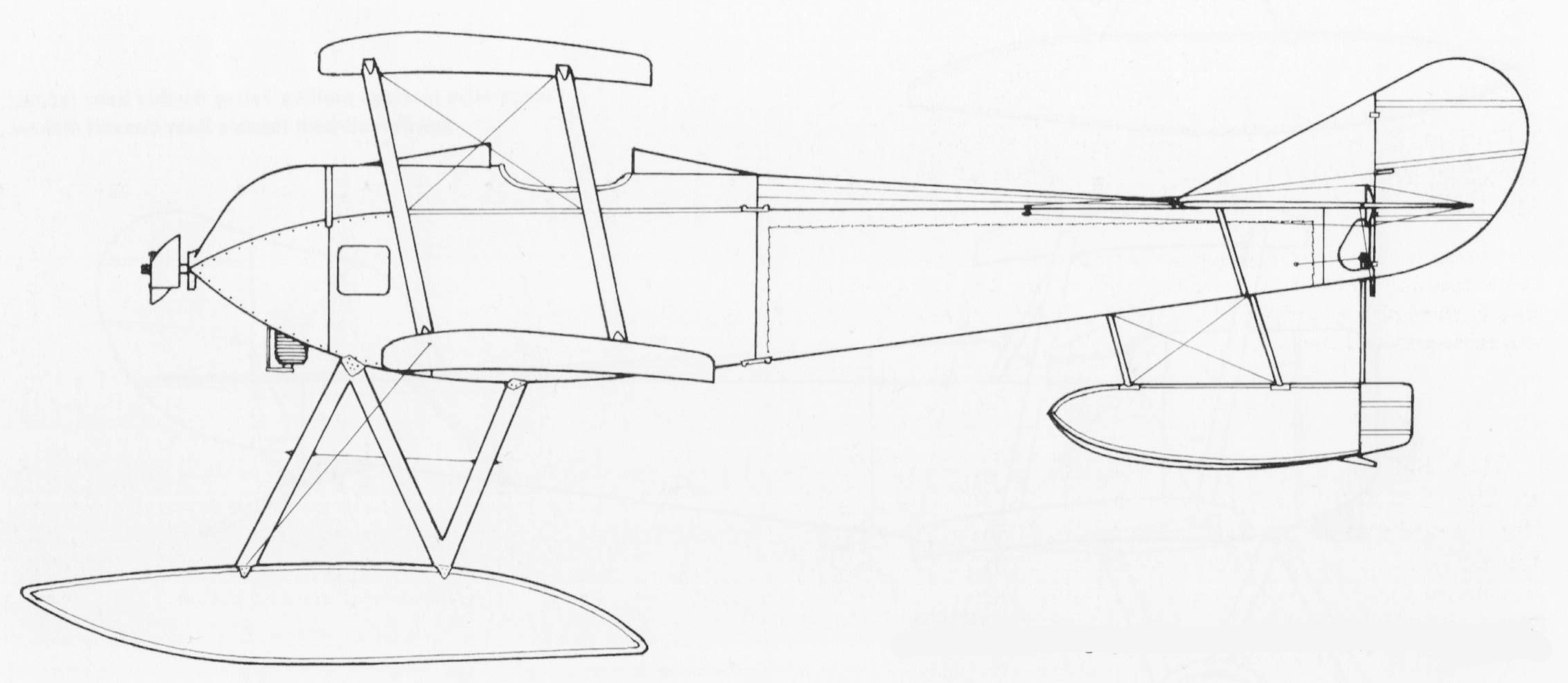
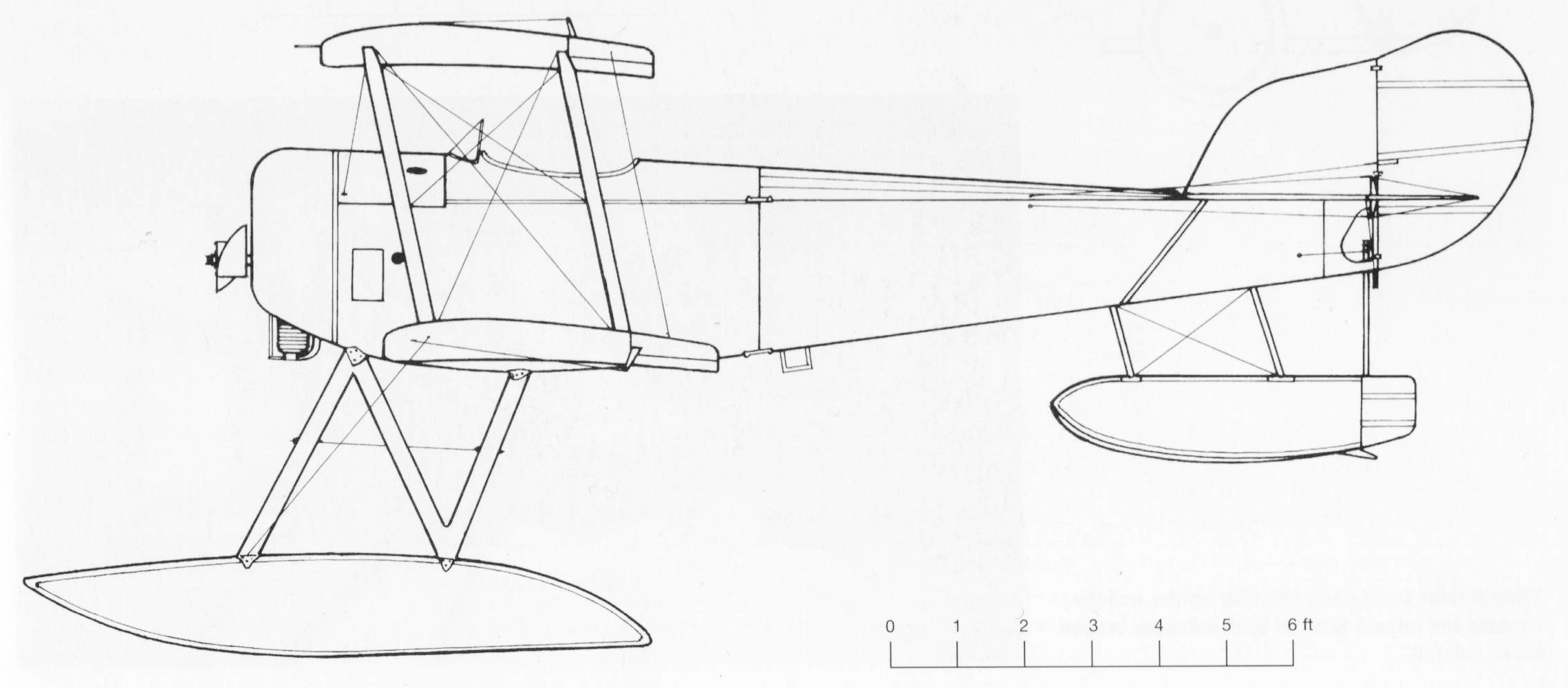
Sopwith ” Schneider” and “Baby” floatplanes (Drawings copyright Mick Davis)
Depending on the supply of engines production could start in 3 or 4 months in parallel with the remaining “Schneider” orders. Airframes without engines are £1,040 each. With 100 safety belts, 100 deck-flying trolleys, 100 spare sets of floats and 200 crated spare propellers the total order is valued at £120,725, a major boost to the company’s forward order book. (Over £10m in 2015)
Overnight 31st May/1st June there is another raid by Army Zeppelin LZ38 now with the Kaiser’s authority to attack London “east of the Tower”. Flying high and not picked up by searchlights it drops 30 small bombs and 90 incendiaries over Stoke Newington, Stepney and Leytonstone killing seven people and injuring thirty-five. Fifteen aircraft go after it from six airfields including Sopwith “SS3” scouts Nos.1210 & 1212 from Eastchurch and Westgate and pusher “Gunbus” No.802 from Hendon. No.802 crashes trying to land in the dark at Theobalds Park in Hertfordshire killing the pilot Fl Lt D M Barnes. His gunner Fl Sub-Lt Ben Travers is thrown out and survives to do much more flying and delight future theatregoers. FL Sub-Lt Mulock reaches 10,000ft in Westgate’s “hot-ship” No.1212 but patrolling for two hours between the Essex coast and Dover sees nothing.
“Schneider” floatplanes are also busy with the Zeppelin menace. Like those from Yarmouth, Dover’s No.1447 is now operating from a converted steam trawler, HMT St. Germain, whilst the four Harwich Force light cruisers are out in the North Sea with one “Schneider” each. HMS Undaunted’s No.1557 now sports a unique camouflage paint scheme. (below)
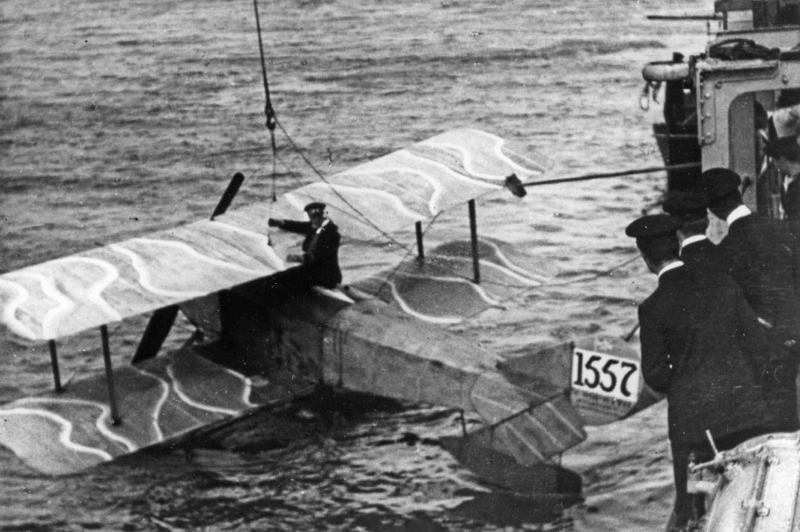
On 2nd June HMS Arethusa launches her machine on sighting a Zeppelin but the pilot turns back mistaking smoke from accompanying destroyers for the pre-arranged smoke-screen signal to return. The first opportunity for a “Schneider” to intercept an airship is lost.
Also on 2nd June “D3 Daily Mail” landplane No.1067 is out on a patrol from Montrose seeking a reported enemy aircraft whilst spares orders arrive at the Sopwith works for thirty ribs and a control column connecting rod for Dover’s crashed “Schneider” No. 1442 and one for a cross strut for old torpedo machine No.138 at Calshot.
On 3rd June “Schneider” No. 1558 is wrecked on take-off from Yarmouth and will be deleted from service.
On 4th June two new “Type 860” tail floats are sent to Dundee in advance of a working party to carry out “all necessary repairs” to recently accepted Nos.929 & 930. The total extra cost to the Admiralty will be £91.1s.2d.
On 5th June three days after No.1070 went through the same process, new “D3 Daily Mail” No.1071 is taken to Brooklands for testing before being crated and sent to Killingholme for erection and its acceptance test flight.
The same day “Type 860” floatplane No.931 is taxied back to Woolston from Calshot to be despatched by road to Grain whilst sister “Type 860” No.933 leaves on Sopwith’s own lorry for the 235 mile journey to Killingholme.
On 6th June HMS Undaunted’s “Schneider” floatplane No.1557 is badly damaged on landing back at Felixstowe and is to be deleted from service.
On 6th June Royal Aero Club officials are ready at Hendon with their sealed calibrated barograph when Tommy Sopwith turns up to witness a rare wartime attempt at a British aviation record. Brooklands is not open to the public but Hendon is and still has private flying schools, albeit training pilots for the RFC. The surprise for all but the Sopwith team is that the aircraft Harry Hawker flies up from Brooklands is a new type, the machine known in the Sopwith factory as the “Sigrist Bus”. The fuselage and 80hp Gnome engine installation are similar to, if not identical to, the two-seat “Type 807” floatplanes. The innovation is in the wing design.
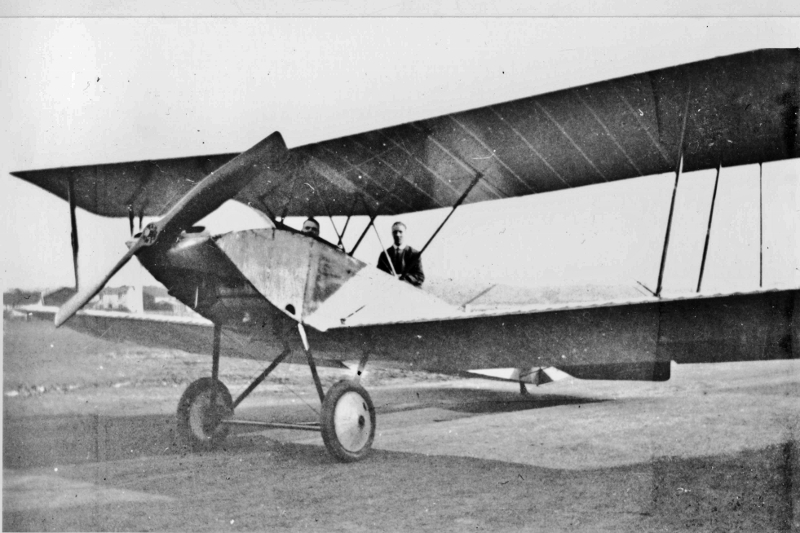
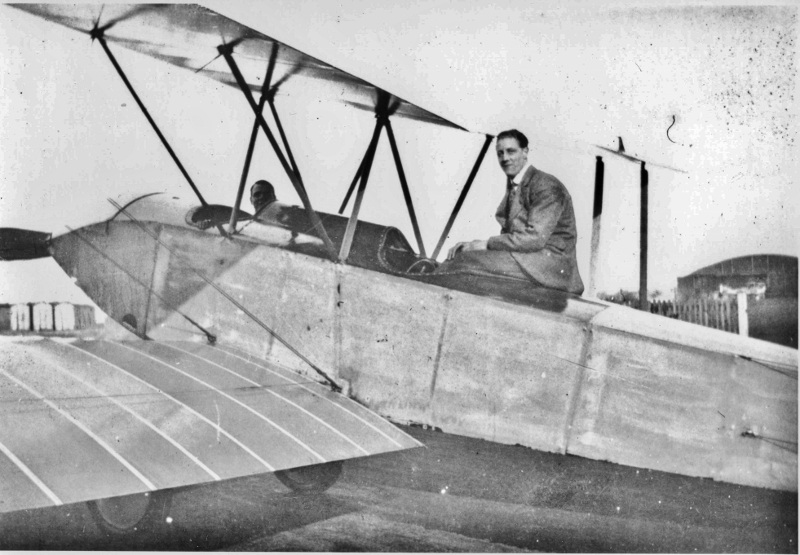
Fred Sigrist has devised lightweight stiff wings strong enough to only need supporting by a few slender metal struts: a single pair of interplane struts towards each wingtip and a pair of ”W” struts widely angled out under the top wing from the top fuselage longerons. A single-bay wing was successfully achieved with the little “Tabloid” and is a big step forward for these larger two-seaters, reducing the weight and drag compared with the two and even three-bay wooden strutted wings which have come before.
No-one discloses how long the “bus” has been on test at Brooklands, possibly only a few days but the team are impressed by its performance and have decided to publicise their achievement in the pre-war Sopwith tradition by letting Harry Hawker attempt to break a record, the British altitude record currently standing at 14,920 ft.
“The first 10,000 ft are climbed in twenty minutes and everyone on the ground has a stiff neck from watching. Harry presses on in the clear air and intense cold until the tiny gnat dodging around the light fleecy clouds disappears completely”. Harry only gives up when he realises that his last 100ft rise has taken eight minutes. Switching the engine off and on, he takes seventeen minutes to descend in a long spiral, before doing two splendid circuits at full speed. He lands, feeling extremely cold and with slight bleeding to his gums, believing he has reached 20,000 ft. The corrected barograph reading sets his new British Height Record at 18,393 ft.
Significantly this is achieved not with a special record breaking machine like the Germans used for the world record but in a workhorse two-seater albeit with exceptionally smooth wings with a very shiny clear dope finish and with a non-standard Lang propeller which is efficient at 1,100 rpm, 200 rpm slower than usual “in view of the long running involved”.
At 8pm on 6th June Naval Zeppelin L9 finds Cromer and sets off towards Hull. A BE2c up from Yarmouth for two hours from 8.20pm sees nothing, nor does “D3 Daily Mail” No.1053 between 2.30 and 4.30am. The raid causes twenty-four deaths and forty injuries, the heaviest casualties to date. Nearby Killingholme Air Station is blanketed by fog until 5am when No.1055 gets away on a precautionary patrol far too late to intercept. No.1 (RNAS) Wing in France gets some revenge. Of the three Army Zeppelins that turned back, LZ38 is bombed and destroyed in her hanger in Belgium after returning with engine trouble and LZ37 is destroyed over Ghent by Ft Sub-Lt Reginald Warneford dropping 20lb bombs on her after coaxing his Morane Parasol up to 11,000ft.
“Schneider” floatplanes are flowing out of Kingston in numbers and are photographed lined up for testing on the slipway outside Sopwith’s Woolston sheds with one of the large “Type 860” folder floatplanes. (below)
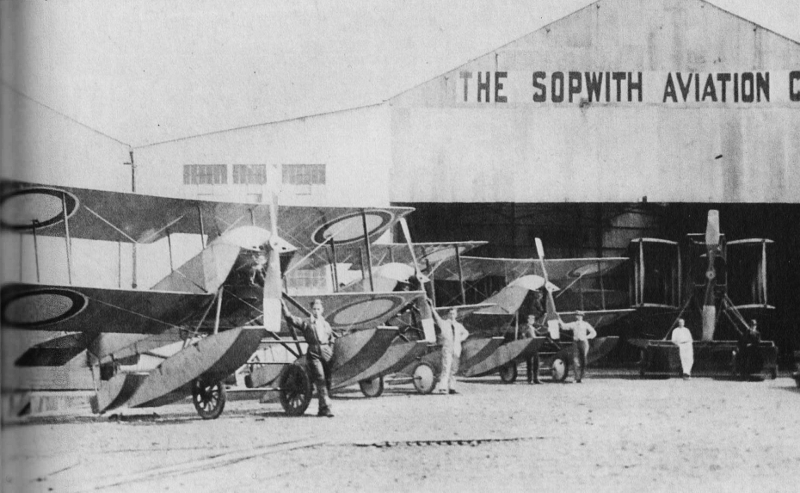
By 8th June “Schneider” floatplanes Nos.1559 & 3707 have been packed and despatched by rail to Aberdeen for HMS Campania.
On 8th June two new “Schneider” floatplanes Nos.1562 & 3708 are delivered to Dover along with a replacement tail float and rudder for No.1442 which was recently capsized.
On 9th June Eastchurch “SS3” scout No.1209, now at Rochford, is sent out to find a reported enemy aircraft but suffers an engine failure and forced landing.
Also on 9th June new “D3 Daily Mail” landplane No.1070 is being tested at Killingholme when No.1071 arrives whilst Dundee’s “Type 860” floatplane No.929 goes out for the first time searching for an enemy submarine reported to be threatening the British Fleet. The following day it suffers an engine failure whilst taxying out.
On 9th June Felixstowe based “Schneider” No.1441 floatplane “nose-dives in” after landing. Three days later No.1440 suffers a broken float on take-off. Both are badly damaged and immediately deleted from service.
Tommy Sopwith has been seeking permission to visit the British Expeditionary Force in France and on 10th June he crosses to Boulogne and motors to the Royal Flying Corps Headquarters at St Omer for discussions before visiting a series of aerodromes to see for himself their BE2c, Morane and Vickers Gunbus squadrons backed up by an assortment of Farmans, Avro 504As, Bristol Scouts and Caudrons. There is not one Sopwith machine with the RFC on the Western Front but Tommy now has first-hand knowledge of the conditions and challenges faced by the pilots out there which might be invaluable in assessing the military potential of the two-seat Sigrist Bus and the equally innovative new single-seat machine that Harry Hawker has in mind.
On 14th June Sopwith despatch by train a French 2.5 diameter 2.5 pitch Chauvière propeller for experiments on a “Schneider” floatplane by the RNAS Isle of Grain seaplane test section. It costs £20 4s 6d with its case.
That same day after just two days at Brooklands “D3 Daily Mail” No.1072 is flown to RNAS Eastchurch.
Meanwhile on 14th June “Type 807” folder No.926 flying from HMS Campania is damaged alighting in a swell breaking off both floats. It is sent to the repair depot at Grain but condemned as damaged beyond repair.
At 8.45pm on 15th June Zeppelin L10 reaches the English coast in daylight and cruises offshore for three hours. Sopwith landplanes Nos. 1055, 1070 & 1071 are out searching from Yarmouth and Killingholme until dark and BE2c landplanes from Whitley Bay until 11.30 but none sight the airship. It comes inland at Blyth at 11.45pm and turns south to rain 3,500lbs of bombs on Wallsend, Jarrow and South Shields. There are no warnings, no searchlights in action and factories are brightly lit. Eighteen people are killed and seventy-two injured.
On 16th June “Type 860” floatplane Nos.933 fails its acceptance tests at Killingholme due to engine trouble.
Meanwhile both of Dundee’s “Type 860” floatplanes Nos.929 & 930 with their new tail floats are on patrol searching for a reported enemy submarine and “D3 Daily Mail” landplane No.1067 is out on a patrol from Montrose seeking a reported enemy seaplane. There are no sightings.
On 17th June Sopwith make a same day delivery of a “Schneider” floatplane propeller to Chingford. They also take an order for six such propellers and six “Type 860” propellers to go to West India Docks in the next two days and then via Malta to HMS Ark Royal in Kephalo Bay, Imbros. Another order is for two “screens” to be fitted by naval mechanics to “D3 Daily Mail” landplanes Nos.1062 & 1063 at Hendon. Intriguingly, on 18th June there is an export order via Brown Brothers for six 2.5 metre diameter propellers for 50hp Bleriot machines.
Too valuable and too slow to be risked against enemy submarines, HMS Ark Royal is now permanently moored in Kephalo Bay on the island of Imbros in the Aegean Sea 15 miles west of the Gallipoli peninsula. On 18th June Fl Lt Sholto Douglas and CPO Brady suffer an engine failure and a forced landing in “Type 807” folder No.922. Taken in tow by trawler HMT Yarmouth the undercarriage collapses. With wings folded it is dangled from a derrick over her stern and taken back to HMS Ark Royal to be repaired. (below)
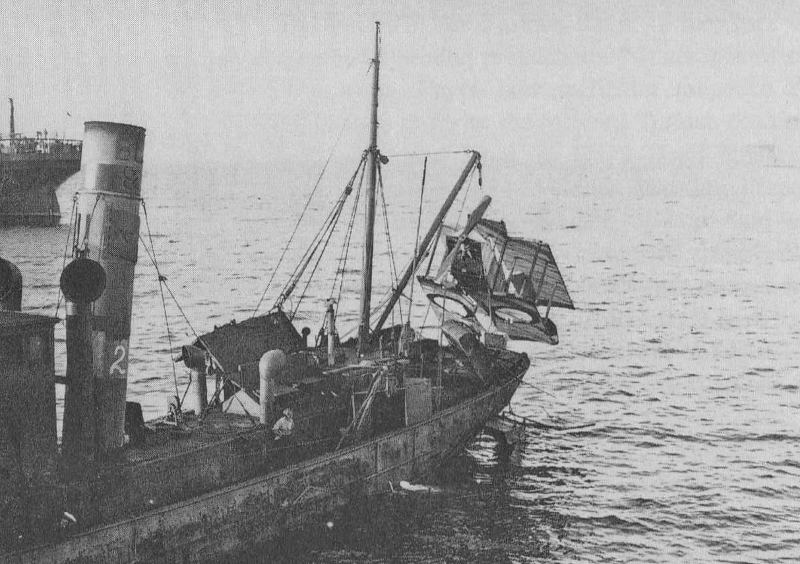
On 19th June “D3 Daily Mail” No.1073 is sent from the Kingston works to Brooklands for testing before going on to Eastchurch Naval Flying School. That day “Schneider” floatplane No.3710 is sent on its way to Yarmouth whilst Nos.1563 & 3709 are despatched from Woolston to HMS Campania via Aberdeen and the SS Vocturnus.
On 20th June “Type 860” No.931 having been to Calshot, taxied back to Woolston and delivered by road to Isle of Grain, is erected for testing. (below)
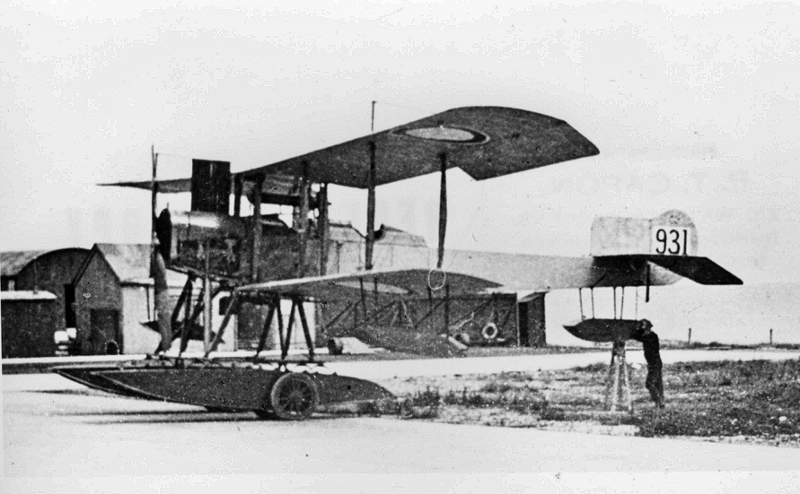
That same day No.931 is flown by Sqn Cdr de Courcy W P Ireland to Yarmouth where the “landing chassis is broken on landing”.
On 21st June the same pilot is unhurt when he buckles a wheel landing “SS3” scout No.1208 at Yarmouth and it overturns. Sopwith take an urgent order for new front engine bearers. They are to be despatched in five days despite “SS3” scouts being out of production.
On 21st June Sopwith take a £1,055 5s 0d addition to the order for thirty “Type 806” gunbus pusher landplanes to be built by Robey & Co for the Admiralty. It is for 30 armour plate seats, 15 armour plate petrol tanks and 5 oil tanks all of “bullet proof non-mag. steel” plus “outside detachable armour” for five aircraft.
In the Aegean on 22nd June “Schneider” floatplane No.1437 which has been completely re-covered and fitted with new floats on SS Penmorvah since its adventures with HMS Doris in May, suffers an engine failure on its two-mile journey to the seaplane base now established on the sheltered shores of Aliki Bay on Imbros.
On 22nd June “Schneider” floatplanes No.1563 & 3709 arrive at HMS Campania with the British Fleet in the Firth of Forth. They join No.3707 which is being erected.
On 23rd June Dundee’s “Type 860” floatplane Nos.929 is out for the third time this week searching for an enemy submarine reported to be threatening that British Fleet.
On 23rd June Sopwith despatch to the Isle of Grain “the latest type” of main floats for a “Type 860” machine which were ordered 10 days ago and to Sheerness 652 yards of “aeroplane fabric” only ordered that morning.
On 23rd June new “Schneider” floatplane No.1564 is delivered to Yarmouth by road and on 24th June three more Nos.1565, 3711 & 3712 are sent off by passenger train to Felixstowe for erection and testing.
By 23rd June “Type 807” folder No.807 has been rebuilt after cannibalisation for No.922 and is at the new seaplane base on the shores of Aliki Bay, Imbros (below) along with a wingless “Schneider” and 200hp Wight pusher floatplane No.176. (Commander Samson’s RNAS No.3 Wing landplane airfield is situated on the headland at the back of the right hand photo below. Kephalo Harbour is in behind the floatplanes)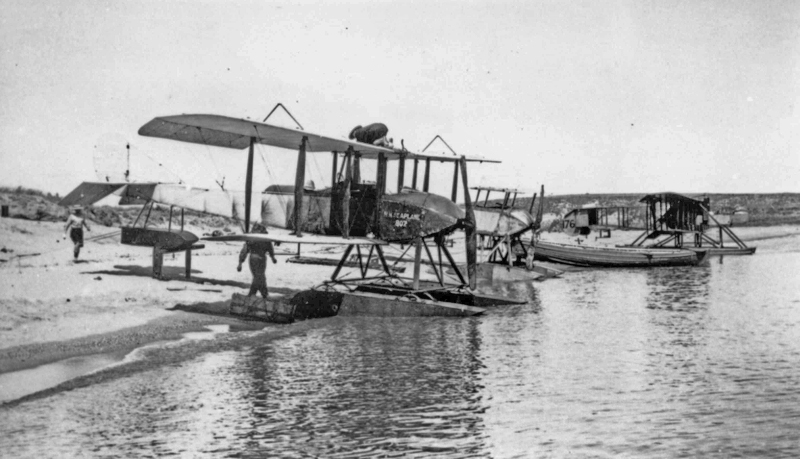
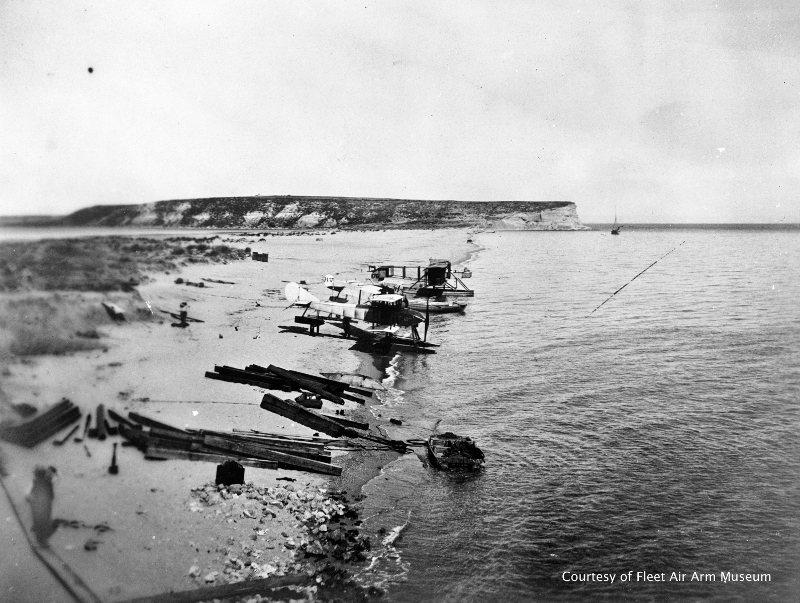
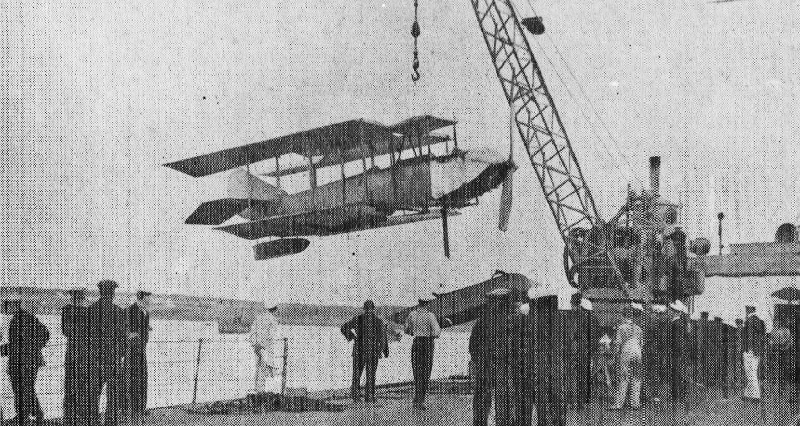
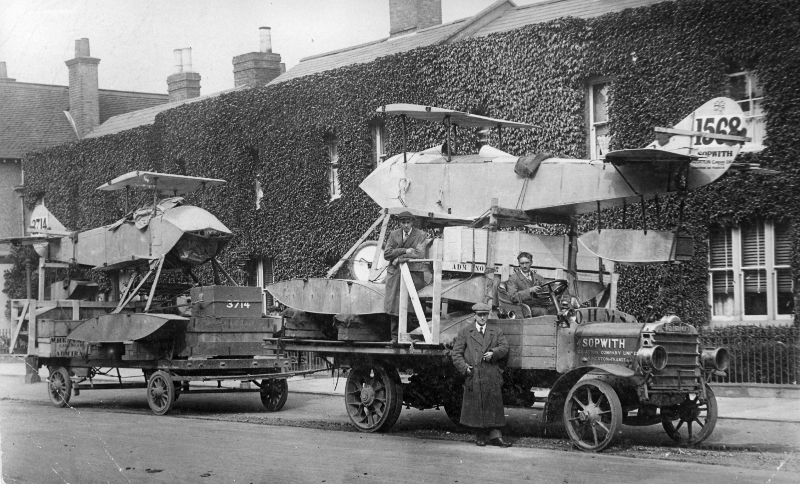
On 4th July No.3714 is already amongst other brand new “Schneider” floatplanes on HMS Engadine and HMS Riviera accompanying the Harwich Cruiser Force to tempt out some Zeppelins and reconnoitre the River Ems where transport ships have been reported. Approaching the island of Ameland five Short floatplanes are hoisted out. One splits its propeller crossing the wake of a circling destroyer, two soon return with engines not performing, one runs out of fuel and is deliberately run down by a Dutch trawler after they rescue the pilot and one returns chased by a German floatplane to report that there are no transport ships on the Ems. During that time, when Zeppelins are sighted, three “Schneider” floatplanes No.3711, 3712 & 3714 are hoisted out to engage them. One by one as their Gnome engines strain to get them off the choppy sea their floats break off. The pilots are rescued but all three aircraft are “lost at sea”. The Zeppelin airships float around high above the fleet for some time unmolested. These repeated failures create a distrust of the Naval Air Service among many Naval Commanders but those who can see the huge potential value of operating aircraft from ships at sea are more than ever resolved to experiment with launching them directly from the ships’ decks.
On 4th July new “Schneider” floatplane No.1569 is delivered to Dover Naval Air Station.
On 6th July Ft Lt G W Price crashes Chingford based “D3 Daily Mail” landplane No.1061 “near a reservoir” whilst “Schneider” floatplane No.1567 breaks a float on take-off at Yarmouth after just one week in service.
Also on 6th July Sopwith despatch another “Schneider” No.3715 by passenger train. It arrives at Yarmouth the very next day as sister machine No.1570 is readied for her first flight there.
In the last week the Admiralty Air Department has reported that tests of the Sopwith 225hp Sunbeam powered “Type 860” torpedo floatplane find “nothing good about this type”. It was a high risk, potentially high reward, strategy for the Admiralty to go straight into volume production of a torpedo carrying aircraft larger than anything that Sopwith had successfully built and with the untried big Sunbeam engine. Sadly it has also cost the life of a promising young Sopwith design engineer. On 10th July “Type 860” No.935 may be the last to go to the RNAS when it joins Nos.853, 858 & 852 at the Isle of Grain Naval seaplane testing section for experimental development work.
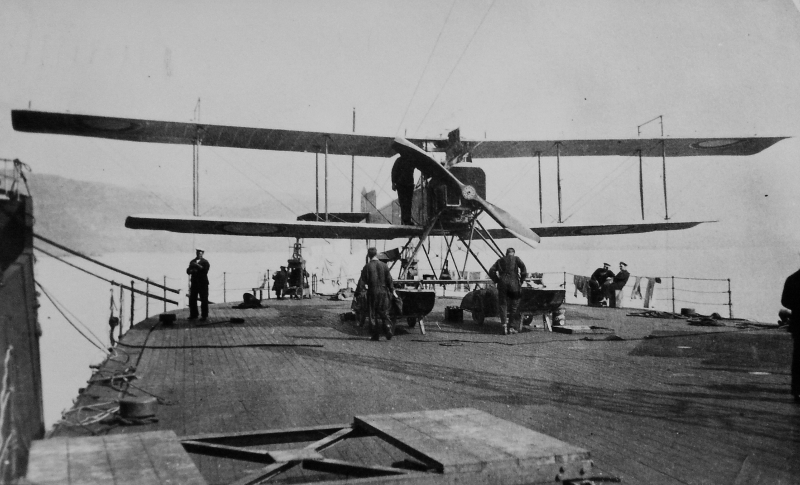
Of the twenty-two ordered, only seven are in active service: one each at Eastbourne, Calshot and Yarmouth, two at Dundee, two with Ark Royal in the Aegean. (above No.857 on Ark Royal’s deck.) Of the rest, two are stored at Calshot, one engineless, two have been wrecked in service and another one is at the works of the Sunbeam Engine Company. The four expensive machines which have so far failed Admiralty acceptance tests are at the Sopwith Aviation Works at Woolston. Sopwith also find themselves well advanced with building another possibly unwanted new machine. The last two on order are not started and may never be built. First-hand reports from a pilot freshly arrived at Dundee from basic flying instruction at Eastchurch describe Sopwith’s “Type 860” as “unpleasant and tricky to fly with a large wing loading and the gliding angle of a brick while their engines are notoriously unreliable”.
On 13th July three German seaplanes attack the RNAS aerodrome at Dunkirk. Two bombs hit a hangar and damage three Henri Farman aircraft. This brings out three RNAS Nieuport 10s and Squadron Commander Spencer Grey in Sopwith “Gordon Bennett racing Tabloid” No.1214 but in bad visibility there is no contact with the enemy aircraft.
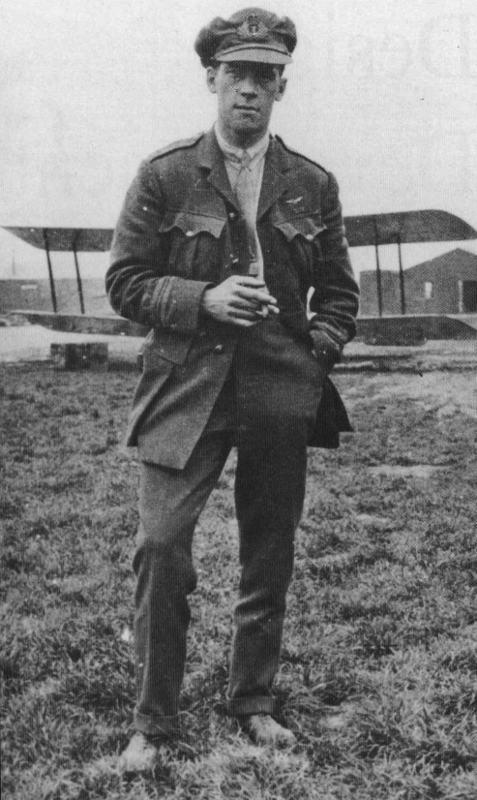
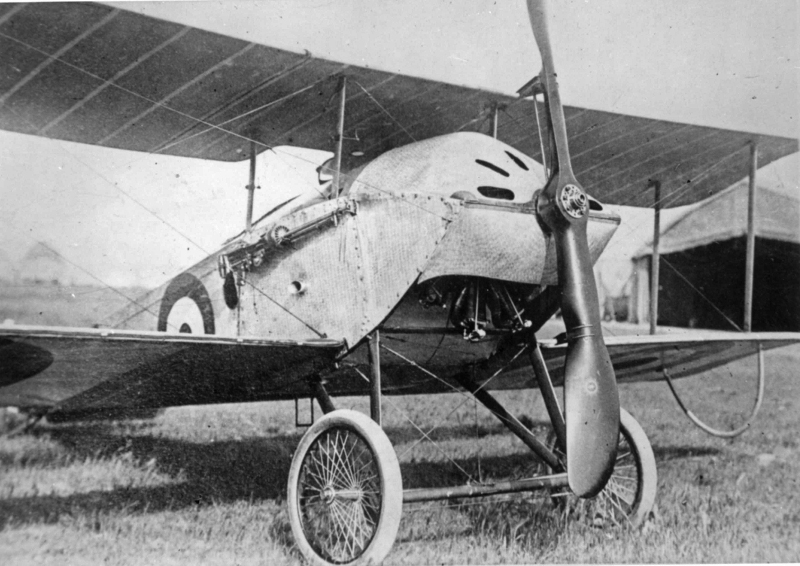
Experienced RNAS pilot Spencer Grey (above left) of RNAS No.1 Wing at Dunkirk has recently been flying No.1214 on hostile aircraft patrols. That he is using this machine may owe something to his achievements with similar Sopwith “SS” Tabloid scouts in Belgium last Autumn. More significantly this machine is probably by now uniquely equipped with a Lewis machine gun outside the cockpit clearly shown in the photograph (above right) with Morane-Saulnier type steel wedges strapped onto the back of the propeller to deflect bullets which would otherwise hit the propeller. This makes it one of the very few aircraft in service with a fixed forward firing gun.
New “Schneider” floatplanes deliveries continue to coastal RNAS Air Stations. On 8th July No.1571 is ready to go to Felixstowe and No.3716 by rail to Yarmouth. On 10th July Nos.1572 and 1573 leave by rail for Dover.
On 15th July a float gives way on take-off on “Schneider” No.1567 which overturns and sinks after just three weeks in service. It is salved and beached near Yarmouth’s scenic railway but only the engine will be reusable. On 17th July practice at hoisting floatplanes in and out of HMS Ben-My-Chree in the Aegean is suspended after floats are damaged on “Schneider” floatplanes Nos.1445 & 1560, which is only seven days back from repair. On 19th July new “Schneider” No.3716 is delivered to Yarmouth. On 20th July “Schneider” floatplanes Nos.1438, 3715 & 1564 are tested by Harry Hawker at Yarmouth. The first two arrived there on 3rd and 7th July whilst No.1564 has been repaired after the engine trouble on its first test by Harry on 29th June. On 21st July the Sopwith Aviation Board Meeting approves a maximum £5,000 (£½m in 2015) loan to key local supplier Lang Propellers of Hersham. “The loan is to be secured by the issue of debentures to this company”. On 21st July “Type 806” pusher gunbus No.801 goes to Chingford joining Nos.805 & 806 which have arrived there over the last eight days from Hendon. The last three operational examples of this 150hp Sunbeam powered Sopwith type are all now stationed at Chingford. After its fatal collision 6 weeks ago, “Type 806” pusher gunbus No.802 joins No.804 at the Pemberton-Billing factory in Southampton for reconstruction. This is useful business for Pemberton-Billing who are working on a smaller pusher biplane of their own design.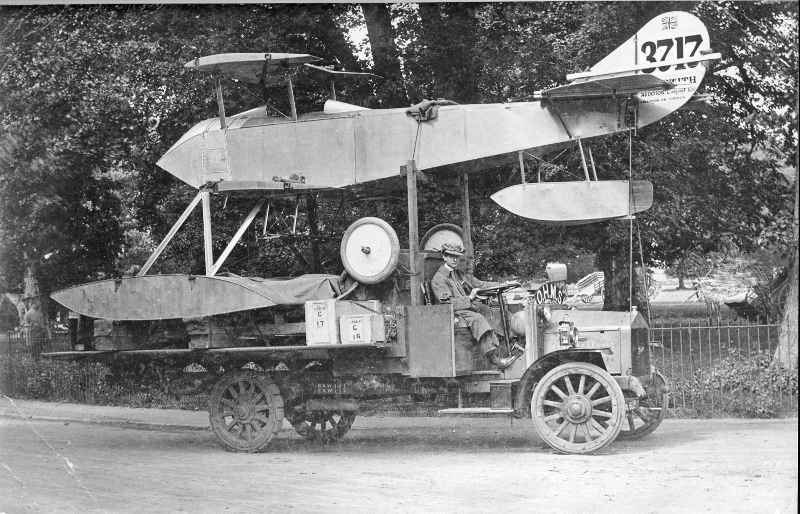
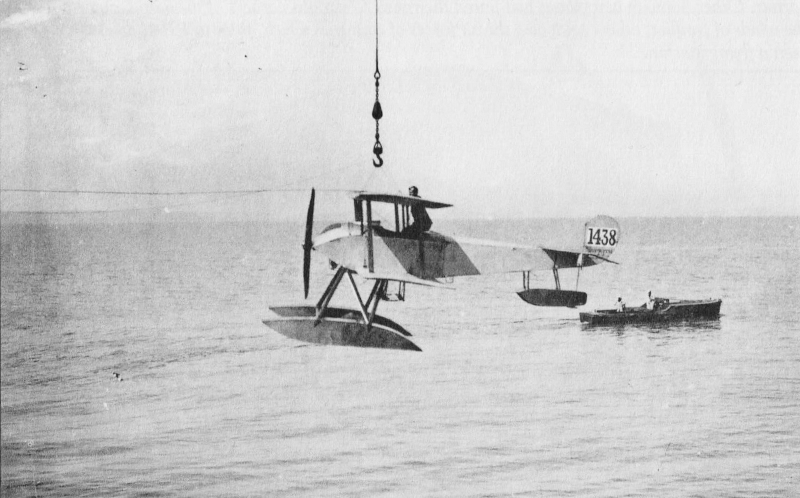
On 28th July “Schneider” floatplane No.3720 arrives at Yarmouth. This is the seventeenth new “Schneider” this month which with one “Type 860” matches the last two months’ record eighteen machine outputs from the Sopwith Works. These bring the year-to-date Sopwith production total to ninety-six new aircraft.
On 30th July “D3 Daily Mail” landplane No.1056 goes on its nose taxying after landing at Yarmouth and sustains slight damage. Out in the North Sea another Yarmouth “Schneider” No.1446 suffers damage to a float, wingtip, tailplane and elevator when being lowered for an anti-Zeppelin patrol from the trawler HMT Sir John French.
31st July “Schneider” floatplane No.1459 is strangely recorded as “taxied to Scapa on wheels”. Delivered to HMS Campania on 11th June, she was found to have “wings out of true” when tested on 5th July and was re-tested on 16th July. Tomorrow she will be rejoining HMS Campania ready for the first deck flying-off trials.
On 31st July Chingford based 80hp “D3 Daily Mail” two-seat landplane No.1061 has its third and final crash.
On 1st August Fl Sub Lt L H Hardstaff flying “Schneider” floatplane No.1574 from Felixstowe is unhurt when he loses control and it dives into the water. The machine is completely wrecked and will be deleted from service.
During July, in readiness for the imminent new Gallipoli offensive, the control of all naval air units in the Aegean has been centralised at Kephalo on the island of Imbros 10 miles off the coast of the peninsula. An airfield has been established on Kephalo Point on the east side of the Harbour and Cmdr Samson’s mixed bag of landplanes, including his two little-used “SS” Tabloid scouts Nos.1205 & 1206, have moved up there from Tenedos. Samson’s long established Tenedos airfield 20 miles further south is now handed over to the French.
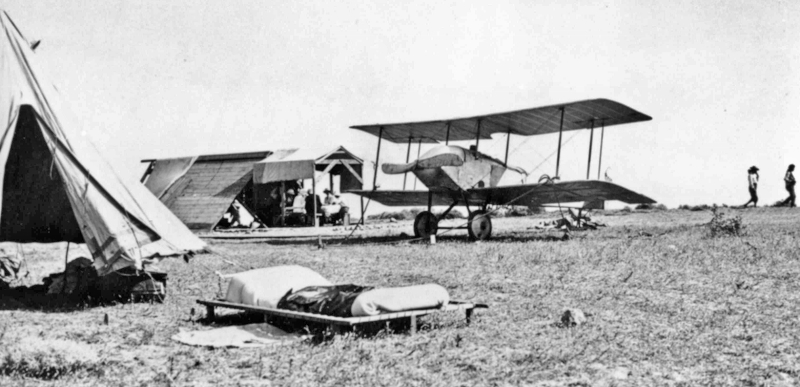
HMS Ark Royal’s seaplane shore base at Aliki Bay must also have an airfield as Sopwith “SS3” Tabloid scout No.1202 which went out crated on that ship back in January finally sees the light of day. It is photographed (above) in front of the Officers’ Mess tent and (below) surrounded by pack animals and fuel cans. None of the four “SS3” scouts have been flown from Ark Royal’s deck as originally envisaged. The other three Nos.1201, 1203 & 1204 are still officially with her but it is reported that they were long-ago sent back to Malta to release space for more floatplanes.
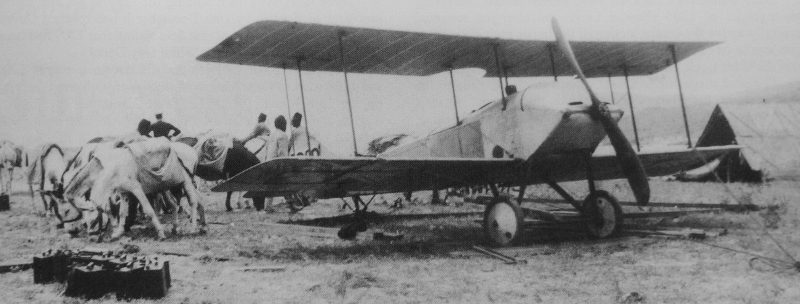
On 3rd August self-contained air-unit HMS Ben-my-Chree joins a French naval force bombarding Port Sighajik near Smirna some 150 miles south of the Dardanelles hoping to convince the Turks that this is the location of a new allied landing. As the French ships are not yet versed in gunnery direction from the air, Ben-my-Chree’s “Schneider” floatplanes are sent out to bomb key targets. No.1560 returns safely but No.1445 is overturned by the wind after landing. Completely wrecked it is salved to recover the engine and instruments for spares.
On 4th, 5th and 6th August RNAS floatplanes and landplanes continue to attack diversionary targets whilst reconnoitring the Turkish defences on the key Suvla and ANZAC areas of the Gallipol peninsula. Flying high and not staying long they do not arouse Turkish suspicions and report that many Turkish positions are unoccupied.
This week’s Surrey Comet newspaper includes amongst the advertisements for clothes, reports of council meetings, obituaries for lost local soldiers, results of sporting events and complaints about overcrowded electric trains, a report on an enquiry into the death on 29th July of 29 year old Sopwith Aviation Co. employee George Edward Burne of 39, Richmond Park Road, Kingston. A motor mechanic for the company for the last 14 months he had recently been working on a Green engine for a hydroplane and went to Chiswick that day to superintend the installation and test the boat. Witness Mr Thomas O M Sopwith said “the boat had been up and down the river three times driven by me, Mr Hawker and Mr May when it developed a slight fore and aft movement. Mr May and boat designer Mr Halliday altered the position of the passengers to correct this. With me steering we were doing about 30 knots and starting a long easy turn to the left when the rudder took charge and the steering wheel was thrown out of my hand. The hydroplane capsized and we were jerked out into the middle of the stream”. After a call to strong swimmer Mr Burne confirming that he was all right, Mr Halliday was assisting Mr Sopwith rescue his 11 year old stepson, when they saw Mr Burne weakening and he sank as Mr Halliday reached him. The Jury’s verdict was accidental death with no blame attached to anyone.
On 6th August 1915 Fl Lt W L Welsh climbs into the cockpit of Sopwith “Schneider” floatplane No.1559 poised on its jettisonable wheeled take-off trolley at the top of the 120 feet long, gentle downward sloping, ramp over the foredeck of HMS Campania at Scapa Flow. The deck has been chalked to reveal the end of the wheel marks. With the engine warmed up and the ship steaming at 17/18 knots into a 13 knot wind the “Schneider” is released and takes to the air with just seven feet to spare. This is the first time in the world that a standard service aircraft has been launched from the deck of a ship. As a result of this successful experiment it is decided that Campania’s deck needs to be extended by 90 feet to operate the heavier two-seat floatplanes.
In the last week, on nights with little or no moon, 20,000 fresh troops have been secretly landed in ANZAC cove on the Gallipoli peninsular to reinforce the Australian and New Zealand forces, including Harry Hawker’s brother Bert (below), who have been trapped there since 25th April. At 9.30pm on 6th August this enlarged force pushes forward to try to capture the Sari Bair heights commanding the Dardanelles narrows above Chanak. One column gets hopelessly lost in the dark. With daring determination some small units reach the crest of the ridge but Turkish reserves will regain control and the opportunity is lost.
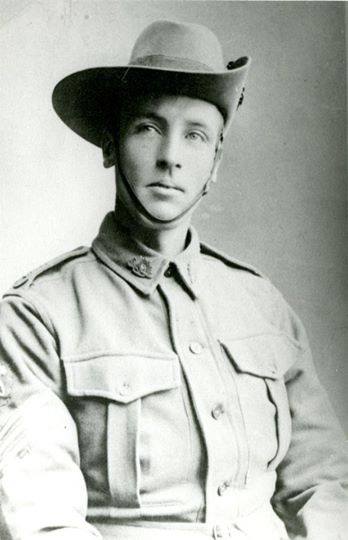
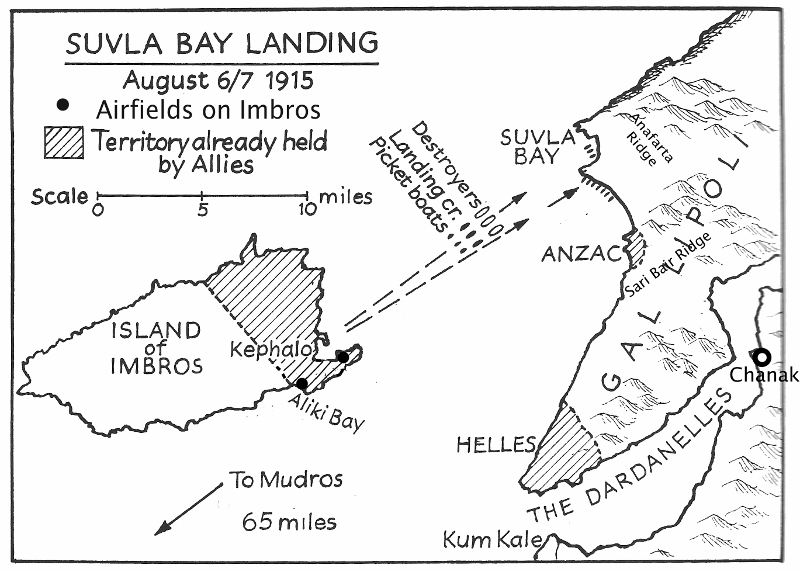
On that same dark night another 20,000 British and French troops are landing around Suvla Bay to the north taking the Turks by surprise and are barely opposed. On 7th August they move across the Sulva plain behind the beaches. Lacking maps or clear orders they fail to take key objectives or secure sources of vital fresh water. Many return to their landing places. Their commanders wait for more artillery to arrive and miss the chance to sieze the commanding Anafarta Ridge before Turkish reinforcements start pouring into the area on the 8th. RNAS aerial support is non-stop on these days; directing naval guns, bombing and reconnoitring the battlefields plus anti-submarine patrols and enemy aircraft patrols – none of which appeared. On 7 th August amongst all this action Sopwith “Type 807” No.922 is towed to Ark Royal in Kephalo Bay with an engine failure.
Meanwhile in home waters on 7th August Fl Lt P E H Wakely capsizes and wrecks “Schneider” No.1575 off Orfordness. He is unhurt but it is the second Felixstowe based “Schneider” lost in seven days.
Fl Sub Lt A H Sandwell, a 23 year old Canadian straight from basic landplane flying training at Eastchurch Naval Flying School, writes that he is given no formal floatplane training at the RNAS Air Station at Dundee. After a single demonstration flight in an Avro floatplane which will hardly leave the water with two aboard, he is expected to fly any machine that is available including their two unpopular Sopwith Type “860” floatplanes.
He adds that “the seaplane pilot’s greatest fear is a forced landing far out at sea. They might send someone looking for you if it is not dark when you become overdue or if you have an observer and he manages to send out the emergency call whilst still airborne – the wireless does not function from the surface. If you have managed a dead stick landing on a corrugated sea without too much damage your first aim is to find what is wrong with the engine. If it can be remedied you may try to taxi slowly home, if you get airborne again you are very lucky indeed. If not, put out your cigarettes and drain the fuel tanks to reduce weight and add some buoyancy. Put the safety pins back in the bombs and drop them. If the machine still shows signs of breaking up, the machine-gun, ammunition and wireless follow. The tail float usually goes first, the machine sinks by the stern and has a habit of remaining with the nose vertically upward for some minutes before completing the somersault with the crew crawling round until they are sitting on the bottoms of the floats taking care to keep the Very Light Pistol, all available rockets, emergency rations, cigarettes and matches as dry as possible”.
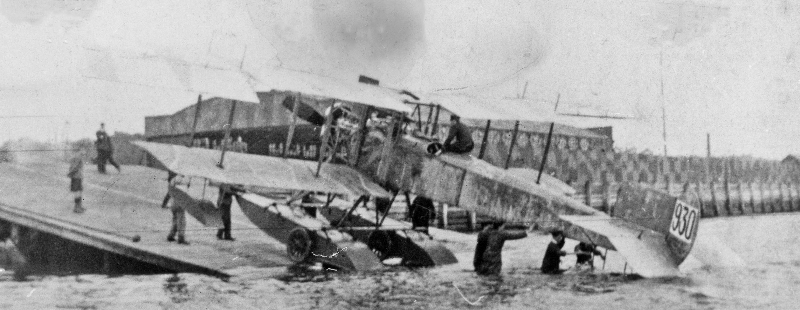
On 7th August when Sandwell is flying “Type 860” No.930 (above) it suffers another failure of the 225hp Sunbeam engine. He makes a forced landing at sea near the mouth of the Tay and the machine “turns turtle” making it into an excellent sea anchor. A fishing smack can hardly move it at all and it takes a destroyer two hours to turn it 180ᴼ and tow it back to Dundee. It is now almost totally submerged and a complete wreck. Sandwell confides that “the machine was regarded as a death trap and the boys staged a celebration over its destruction which ran well into the night”.
On 8th August “SS3” Tabloid scout No.1210 is wrecked at Westgate.
On the evening of 9th August Zeppelin attacks on Britain resume with four of the latest four-engined airships setting out to bomb Hull and London. L9 drops its bombs over Goole thinking it to be Hull killing sixteen people and damaging property. The four aiming to bombard London meet thunder squalls making them so heavy they drop much of their ballast and even their code books, lead weighted, into the sea. Five Sopwith machines are amongst the twenty-eight aircraft from ten different RNAS Stations sent up after the airships that night or at dawn after the coastal fog begins to clear. Fl Sub Lt R Lord in Sopwith “SS3” scout No.1212 goes up from Westgate at 22.51 but landing in the dark in deteriorating weather dips suddenly into the ground short of the night landing flares, overturns twice and is fatally injured. One airship turns back with engine trouble, one drops bombs on Eastchurch airfield and most other bombs go into the sea. L12, bombing Dover thinking it to be Harwich, is hit by ground fire from a 3 inch gun bursting two gas cells. Bolting for home she sinks onto the sea and is towed to Ostend by a German torpedo boat. Eight RNAS pilots from Dunkirk attack the crippled airship meeting heavy fire, a Farman pilot is shot down and killed.
On 9th August new “Schneider” No.3728 is delivered to Killingholme. On 10th August “Schneider” floatplanes Nos.1573 & 1569 are tested by Harry Hawker at Dover, four and five weeks after they arrived there.
On 12th August a Short floatplane from Ben-my-Chree crosses the Gallipoli peninsular from the Gulf of Xeros to make the first ever successful torpedo attack on an enemy ship from the air.
Also on 12th August Sopwith “Schneider” No.3717 from Felixstowe is used for an attack on the Zeebrugge Mole but is hit by anti-aircraft fire. Fl Sub Lt J M d’Arcy Levy makes a forced landing, is captured and becomes a prisoner of war. The aircraft sinks but is salved by the Germans (below) who plan to rebuild and fly it.
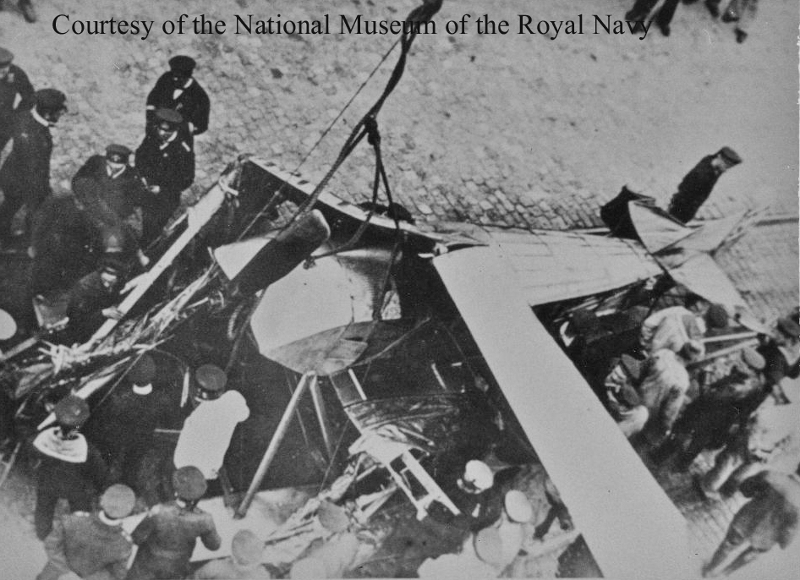
At dusk on the evening of 12th August whilst Sopwith “D3 Daily Mail” No.1056 is returning early to Yarmouth from a routine anti-Zeppelin patrol due to heavy rain and mist, four Zeppelin airships are on their way to bomb London. Three Yarmouth BE2cs go out in succession once the first Zeppelins are reported but all three suffer engine trouble and damage on landing. Three of the Zeppelins are also frustrated by mechanical troubles and turn back. Meeting headwinds, L10 bombs Harwich not London killing seven people and injuring twenty-three.
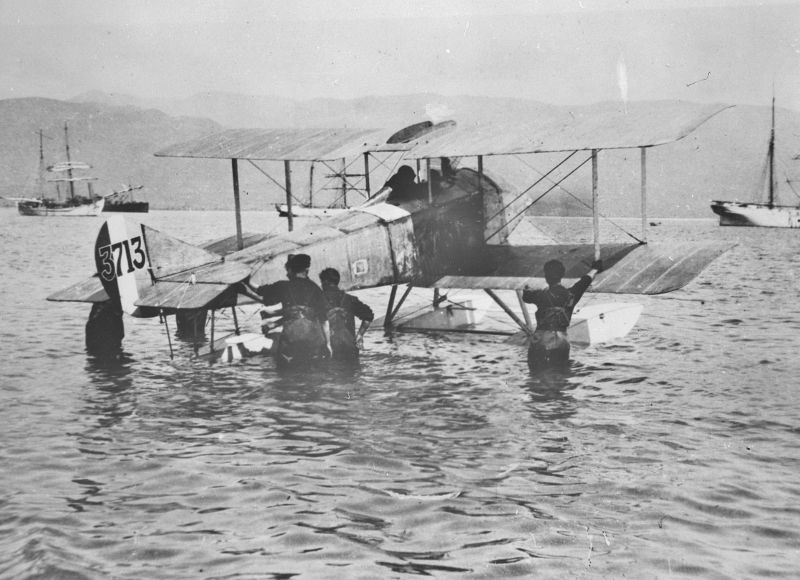
On 13th August just four days after its first test flights at Kephalo in the Aegean (above), “Schneider” No.3713 is capsized but salved. It will have to go back to Ark Royal for repair. Also at Kephalo, “Schneider” No.1437 has recently been fitted with a wireless set
On 14th August Sopwith 150hp “Type 806” No.804 pusher landplane is back at Hendon after a two month rebuild by Pemberton-Billing the same day that sister-ship No.805 is “dismantled for stowing” at Chingford.
On 16th & 17th August Felixstowe Air Station gets a major boost to its fleet with the arrival of no less than four new “Schneider” floatplanes Nos.3724, 3725, 3729 and 3730. This same week No.3731 arrives at Killingholme and No.3739 at Dover.
On 16th August Yarmouth “D3 Daily Mail” No.1053, out on the evening anti-Zeppelin patrol, suffers an engine failure and forced landing at Kesssingland flown by Fl Sub Lt E Cadbury and A M Hazell.
The next evening 17th August Cadbury is out again this time in “D3 Daily Mail” No.1056 as four Zeppelin airships are on their way to bomb London. Since 13 th August Yarmouth “Schneider” floatplanes Nos.3710 & 3715 have started taking alternate spells of morning and evening anti-Zeppelin patrols from trawlers HMT Kingfisher, Jerico or Sir John French 50 miles out in the North Sea. This evening HMT Kingfisher actually receives advanced warning of the raid and for the first time this new form of defence against the Zeppelin menace is tested when Fl Lt Chichester-Smith goes out in No.3710. He makes no sightings. Two Yarmouth BE2cs go out after dark but are unsuccessful, as are two Caudrons from Chelmsford which both crash-land badly injuring their pilots. Even if you are in the right area at the right time it is extremely difficult to spot an airship in cloud and mist especially in poor light or moonlight. People on the ground do not realise that the pilots cannot hear the airships’ engines over their own. Two airships turn back with engine troubles. One bombs Ashford. One reaches London’s outskirts bombing Walthamstow, Leyton and Wanstead causing 10 deaths, 48 injuries and heavy damage.
On 17th August two Short floatplanes from Ben-my-Chree torpedo two Turkish ships, one whilst taxying after engine problems. These successes (with those of the submarines) seriously affect the morale of Turkish sailors unaware that with just 45 minutes fuel they can only lift torpedoes on days with calm seas and a slight breeze.
On 18th August “D3 Daily Mail” No.1069 flying from Montrose overshoots on landing at Barry going into a ditch. Undercarriage and propeller are damaged. Lt G Donald and CPO Harris are unhurt.
On 19th August one of the Royal Naval Air Service’s most experienced and daring pilots Fl Cdr Charles H Collet is tragically killed not by enemy action but in a fire after crashing. His machine suffers engine failure soon after taking-off from Kephalo and he crashes attempting to turn back to the airfield. CPO Mechanic Lacey jumps out and is injured. CPO M Keogh drags the dying Collet from the burning machine, gets burnt himself and is awarded the Albert Medal. Collet is a great loss especially to Cdr Samson whom he has served continuously since the earliest days of the war in Belgium when he often and famously flew Sopwith “SS” Tabloid scouts. (Some modern listings have Collet crashing in Sopwith “Type 807” folder floatplane No.922. This seems unlikely as it is not attached to Samson’s No.3 Wing and Samson’s autobiography has a photograph captioned “wreck of Collet’s machine” showingthe tangled burnt remains of a landplane with an in-line V8 engine.)
On 19th August Major-General Sir David Henderson returns from France to the War Office “to deal with the multitudinous problems of the supply of men and material for the rapidly expanding air service”. Colonel, now Brigadier-General, Trenchard takes full command of the Royal Flying Corps in France. It is just three years since 38-year-old Major Hugh Trenchard managed to get a transfer to the Royal Flying Corps by obtaining Royal Aero Club Certificate No.270 after two weeks intensive instruction at the Sopwith School of Flying at Brooklands.
On 24th August Calshot based Fl Sub Lt J MacLarty is killed when “Schneider” floatplane No.3726 dives from 2,000ft into Southampton Water. That same day “Schneider” No.1560 is wrecked flying from Ben-my-Chree in the Aegean whilst Schneider” No.1442, repaired after capsizing on 24th May, is back on hostile aircraft contact patrols from Dover but has a tail float smashed by wreckage in the harbour, yet another hazard for floatplanes.
Two days ago “D3 Daily Mail” No.1066 was recorded as “wrecked” at Eastchurch but may be repairable. On 24th August “D3 Daily Mail” No.1064 suffers an engine failure at Hendon. It has only been back at Chingford four days after repair at the Navy’s Isle of Grain Repair Depot following its crash 25th May. On 25th August “D3 Daily Mail” No.1055 is “smashed” at Killingholme to become the fourth of these machines to be deleted from service.
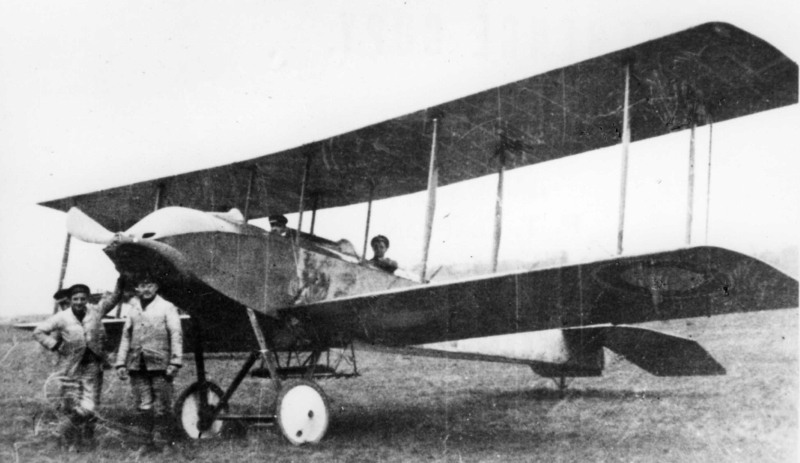
Of the remaining twenty “D3 Daily Mail” landplanes, five are currently based at Chingford Naval Air station, four each at Eastchurch and Yarmouth, three at Killingholme and two each at Montrose and Dundee. These low-powered Sopwith two-seat landplanes gained a poor reputation in early service and attracted the defamatory but very English nickname “Spinning Jenny” from pilots who believed that they were prone to entering a dreaded spin particularly when engines fail on take-off. Indeed, there were 8 recorded engine failures in the first three months service but there has only been one more in the subsequent five months as mechanics and pilots become familiar with the 80hp Gnome radial engines. There have been 19 crashes for all sorts of other reasons: mostly weather and pilot misjudgements, however nobody has been killed in one and most are flying again.
R R Soar writes that they spin fairly fast but actually come out of a spin very easily “on pushing the joystick onto the dashboard” (which assumes enough height). He adds that they “sometimes spin after landing, turning 180o and setting off like hell down-wind”. That most have survived is surprising considering the perfunctory training that new pilots are apparently getting at Eastchurch Naval Flying School. One recent trainee writes that “with one exception the instructors learned to fly no more than six weeks ago. After 68 minutes dual instruction on ancient Short pusher No.28 and a 43 minute flip in an Avro, I was sent off solo on the pusher. I had just 10 hours 47 minutes flying experience when posted to Dundee”.
Co-incidence or not, the Sopwith “D3 Daily Mail” two-seater’s “Spinning Jenny” nickname distinguishes it from the similar sized Curtiss JN3 two-seat training biplanes (below) just coming into RNAS service and universally nicknamed “Jenny” from the JN designation. These have Curtiss’ own 90hp OX-2 eight-cylinder V engines.
Sopwith special torpedo floatplane No.137 is flying again from Calshot alongside sister machine No.138 and now has the same 200hp Canton-Unné water-cooled radial engine in place of its 120hp Austro-Daimler.
On 25th August “Schneider” floatplane No.1562 suffers an engine failure and forced landing outside Dover harbour where it and No.1576 have been active on anti-Zeppelin patrols.
By 30th August two new Schneider floatplanes Nos. 3721 & 3722 have arrived aboard HMS Ben-my-Chree in the Aegean and four more are on their way. The remains of Ben-my-Chree’s three damaged “Schneider” floatplanes Nos.1445, 1560 &1561 are on collier SS Tringa on their way back from the Aegean to Wormwood Scrubs RNAS Central Supply Depot to be rebuilt. At home, new Schneider floatplanes Nos.3732 & 3733 have been delivered to Killingholme, No.3723 to Yarmouth and No.3739 (below) to Dover.
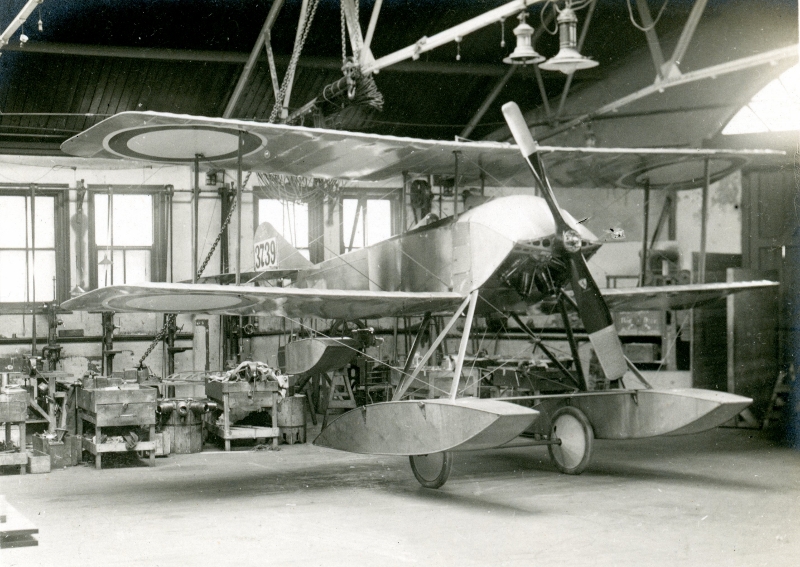
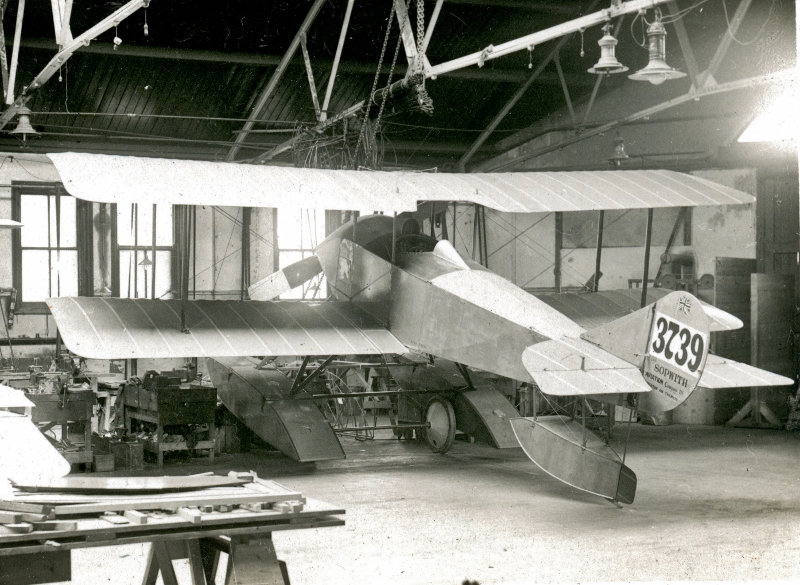
With the four previously delivered to Felixstowe, two to Killingholme and one to Calshot this brings the Sopwith factory output for August to seventeen “Schneider” floatplanes and the total new aircraft built so far in 1915 to one hundred and twelve.
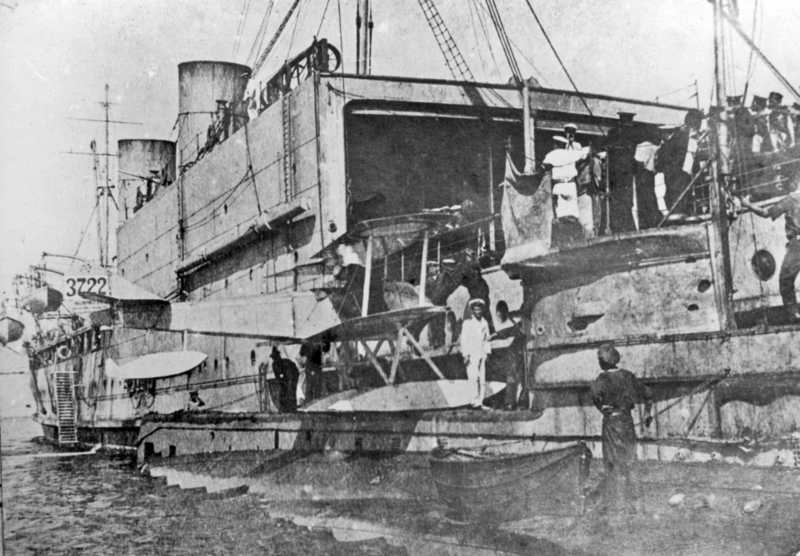
On 3rd September newly arrived “Schneider” No.3722 is photographed (above) resting on the hull in front of the conning tower of HM Submarine E7 alongside HMS Ben-my-Chree with her large deck hangar. E7 has recently sunk 13 ships in the Aegean but the day after this gets its propeller tangled trying to dive under the Turkish anti-submarine nets off Nagara point. After a 12 hour struggle and surviving mines dropped from above, the 30 crew set charges to scuttle the boat, surrender and are taken prisoner.
Since the sinking of the Lusitania in May with the loss of 1,198 men, women and children, diplomatic pressures and better countermeasures have led the Germans to withdraw submarines from the Atlantic and the Channel but Flanders based submarines are still a major threat to ships in the North Sea. Floatplanes and Dunkirk based landplanes are supporting the so far largely unsuccessful heavy naval bombardments of the ports of Zeebrugge and Ostend, and the canals from Bruges where it is believed the enemy submarines are being assembled.
Just before 11pm on 7th September three German Army airships arrive to attack London. One of three aircraft sent out is Fl Lt E J Cooper in “D3 Daily Mail Spinning Jenny” No.1052 flying from Yarmouth from 4.45 to 6 am. No interceptions are made and bombs are dropped between Southwark and Woolwich, on Fenchurch Street, Cheshunt and near Saxmundham. 18 people are killed and 28 injured.
On 8th September three German Navy Zeppelins arrive. Fl Lt V Nicholl in “Schneider” No 3723 sees nothing searching from HMT Kingfisher 40 miles off Yarmouth. Fellow Yarmouth pilot Ft Sub Lt G W Hilliard is killed in a BE2c after a misjudged night landing when his undercarriage collapses and his bombs explode. They should not be live until armed by a free fall of at least 200 feet. Bomb carrying at night is suspended during an enquiry. Zeppelin L13 kills 26, injures 94 and does much damage at Golders Green and from Euston to Liverpool Street.
In the first 10 days of September Calshot has received four new “Schneider” floatplanes from Sopwith: Nos.3734, 3735, 3740 & 3741.Dover’s Schneider floatplane No.1447 has now been fitted with “grenade and bomb gear”. There is a constant interchange of aircraft between Dover and Dunkirk RNAS Air Stations, “Schneider” No.3718 is temporarily at Dunkirk whilst “Gordon Bennett racing Tabloid” No.1214 is back at Dover after nearly five months in France.
On 13th September “D3 Daily Mail Spinning Jenny” No.1069 now flying from East Fortune suffers an engine failure and forced landing damaging its undercarriage for the second time in a month.On 14th September “D3 Daily Mail Spinning Jenny” No.1067, which only arrived at Dundee yesterday from Fort George, Montrose, collides with a tree and is completely wrecked. Fl Sub Lt A H Sandwell is slightly injured, his observer escapes unhurt. That same day Calshot based “Type 807” floatplane No.925 flown by Fl Sub Lt Murray is also wrecked. Both will be deleted from service.
On 15th September “SS3” Tabloid scout No.1207 (below complete with bomb racks) suffers an engine failure and forced landing on its way from Yarmouth to Bacton.
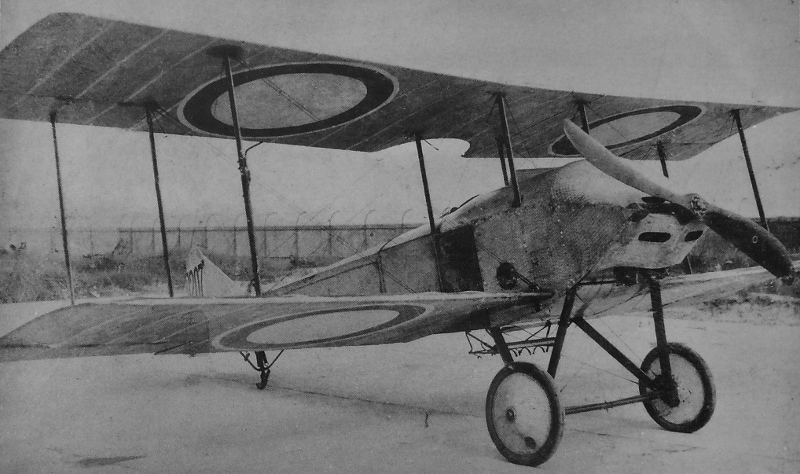
Only one of the thirteen remaining RNAS “Type 860” floatplanes is currently in active use. No.852 is being used to test an extraordinary “aileron propeller” at Isle of Grain for the equally extraordinary three-engined twin-fuselage 115ft wingspan Admiralty designed “Type 1000” torpedo floatplane, on order from J Samuel White and Co Ltd of East Cowes since 24th February 1915. The “aileron propeller” on No.852 (below) has a flap hinged along the trailing edge of each blade which can be adjusted from the cockpit. Small negative angles of flap are intended to allow higher engine speed and thrust during take-off and positive angles of flap allow lower engine speeds when flying. The National Physical Laboratory has tested sixth-scale models at -1 degree and + 3 degree angles.
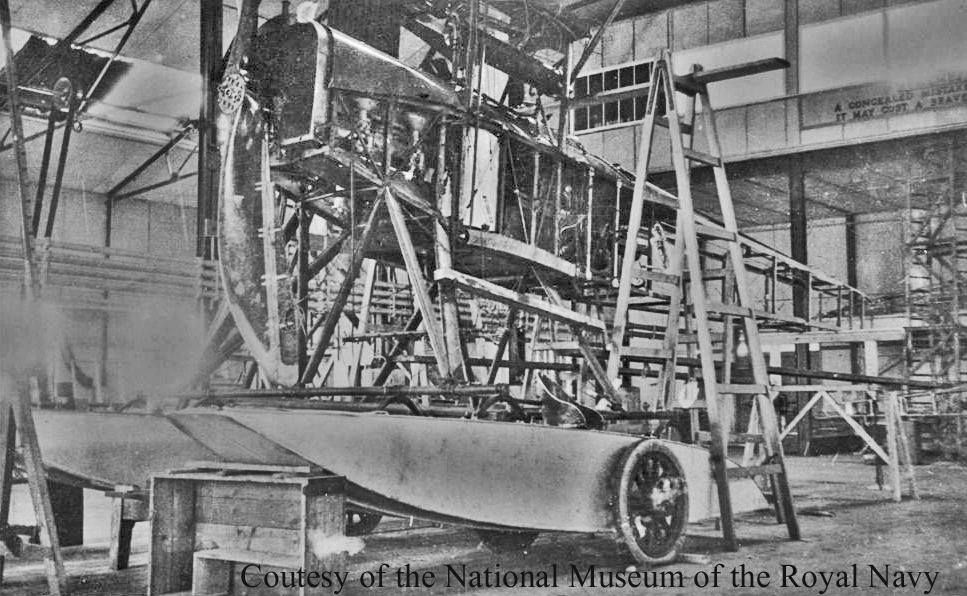

This drawing of the experimental “Sigrist Bus” with a forward skid/pole is signed by Herbert Smith who is establishing himself as the Company’s Chief Designer and looking to design a new Sopwith two-seater. Harry Hawker is reported to be flying this machine “with a pole in front to which various weights are being attached” presumably to establish the full range of centre of gravity variations that are possible. They may well be exploring the practicality of a two-seater with the pilot in front and the observer/photographer/gunner behind him which would have great advantages in military use. Meanwhile Herbert Smith’s ex-boss Reg Ashfield in his skating rink drawing office is helping Harry Hawker develop his latest ideas for a lightweight agile single-seater.
Mr Arthur Balfour, Winston Churchill’s successor as First Lord of the Admiralty has made significant changes not least to bring the Royal Naval Air Service into the “regular routine of day-to-day naval work as if they were destroyers or submarines”. RNAS air stations are now grouped under the senior naval officers in each area “to make the liaison between air and surface craft much closer”. They each have an RNAS officer as an air technical advisor and the functions of the RNAS are now: a) Observation duties from the coast b) Attack of enemy aircraft wherever met c) Aerial defence of all naval centres and d) Reconnaissance work scouting for enemy submarines and minelayers. There is no mention of ship-borne operation, torpedo dropping, bombing of enemy installations or support for naval bombardments. Balfour is also now remodelling and enlarging the Admiralty Air Department. It is put under a non-technical flag officer, Rear-Admiral C L Vaughan-Lee, “to release Commander Murray Sueter “to give his undivided time to the development and supply of aircraft as Superintendant of Aircraft Construction”. There is also to be “a design section with skilled technical experts concerning themselves with the development of aircraft in connexion with the development of sea-craft”.
On 17th September ”D3 Daily Mail Spinning Jenny” No.1053 flown by Fl Lt E J Cooper suffers an engine failure and forced landing at Gorleston a month after a similar incident at Kessingland.
The Surrey Comet reports on “an interesting cricket match played on the Fairfield on Saturday afternoon 18th September between a team representing Mr T O M Sopwith’s household staff at Hordsel, Cobham and an eleven from the ‘old works’ of the Sopwith Aviation Company in Kingston. Excellent weather and the pitch being in good condition, the match proves a very enjoyable one, with a fairly large gathering of spectators including several ladies. Mr Sopwith captained his own team whilst the works eleven was under the direction of Mr Baigent, works foreman. After a well contested game the works team proved victorious by 16 runs. For the winners Mr H G Hawker, the well known aviator, scored a useful fifteen while Mr R O Cary, general manager was responsible for 10 of the total. Mr Sopwith carried his bat through for a fine total of 54. Mr Kauper, the works manager, did the scoring. Mr Sedgley, foreman in the fitters’ shop, acted as umpire. Old Works XI – Newman 11, Buckley 36, Wilson 0, Hawker 15, Cary 10, Smith 1, Baigent 0, Taylor 14, Killick 27 not out, Ham 8, Sez 1, Extras 13. Total 136 all out.Mr Sopwith’s XI – Simmonds 3, Foster 22, Lucas 10, Coombe 0, Sopwith 54 not out, Cleaver 4, Johnson 0, Batterham 16, Malcolm 3, Moore 1, Wallace 0, Extras 7. Total 120 all out.
That same day Fred Sigrist presides over a meeting to found the Sopwith Athletic Club. It is agreed that all classes of sport will be included in the club’s programme. Mr Sopwith will be President, Mr Sigrist Chairman, F Sedgley and A Mills Joint Honorary Secretaries and J Buckley Honorary Treasurer with a committee of E Newman, J Pollard, E Baigent, Paterson, J Roberts, Maile, H Kauper, W Dudman, H Cobb and two others. It is announced that the club expects to secure the use of the Thorpe Road football ground for next season.
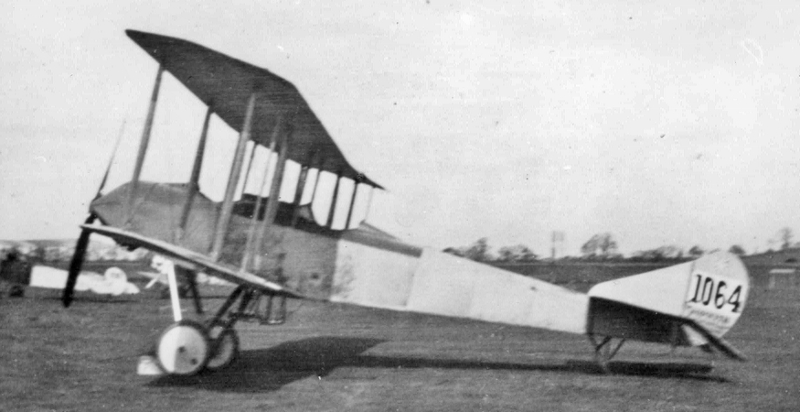
Back In May Fl Lt Pulford crashed “D3 Daily Mail Spinning Jenny” No.1064 (aove). Repaired at the RNAS Grain depot it has been back at Chingford just under a month before it is crashed on 19th September by Fl Lt D Arnold. “The undercarriage is wrecked and the fuselage and wings strained”. It is unlikely to be repaired yet again as on 20th September sister machine No.1054 is being dismantled at Killingholme “to make way for newer machines”. This “old machine” with its lightweight wooden structure and doped linen covering has lasted for nine months in the harsh environment on Humberside. Alongside the 24 Sopwith “Spinning Jennys”, the RNAS have ordered some 550 two-seat landplanes of 12 other designs since the war started. Around 150 are still to be delivered: a few new Henry Farman pushers but mostly Avro 504s, Royal Aircraft Factory BE2Cs and Curtiss Jennys. More orders are in the pipeline.
On 21st September Harry Hawker tests two more new Sopwith “Schneider” floatplanes Nos.3747 & 3748 at Felixstowe RNAS Air Station. They have been assembled rapidly after arriving by road just two days ago.
On 23rd September new “Schneider” floatplane No.3749 is delivered by road to Grain whilst on 25th September No.3724, at Felixstowe for just a month, is badly damaged by Fl Sub Lt G A Magor and will be deleted.
On Saturday evening 25th September the inaugural meeting of the Aquaero Club is held at the Railway Hotel Norbiton. The Aquaero Club is the boat building and (wood)mill employees section of the Sopwith Athletic Club. The Surrey Comet reports that “Chairman Mr J Sherratt expressed his pleasure to see so many employees present and explained that healthy recreation and facilities for social intercourse, when relaxation from their strenuous duties permitted, were the tenets upon which the club is based; also to meet in friendly rivalry in various sports their fellow workmen in other parts of the firm. Mr R O Cary, general manger, will be President, Mr J Sherratt Chairman, Mr C E Kill Secretary, Mr Lloyd Treasurer with committee members J Cooper, S Johnson, D Radcliffe, A Bush, H Cobb, W Chandler and W Brocklesby. Captain and vice captain of the football team will be elected after the trial match. The club will have its own playing ground and all members are affiliated to the Sopwith Athletic Club. The Secretary will be pleased to receive communications from Club secretaries (particularly munitions workers) of any vacant dates”.
The (wood)mill is the beating heart of the company where the expensive straight-grained knot-free aircraft quality timber is selected, cut, planed and grooved to precise dimensions to go on to the fuselage assembly areas, the wing shop and to the boatbuilders who make the three floats for each floatplane.
On 25th September “Schneider” floatplane Nos.3750 is delivered by road to Grain together with No.8118 the first of the latest order for 100 improved “Schneider” floatplanes which still has the sloping-cowled 100hp Gnome Monosoupape rotary engine making it almost in distinguishable from earlier “Schneider” floatplanes.
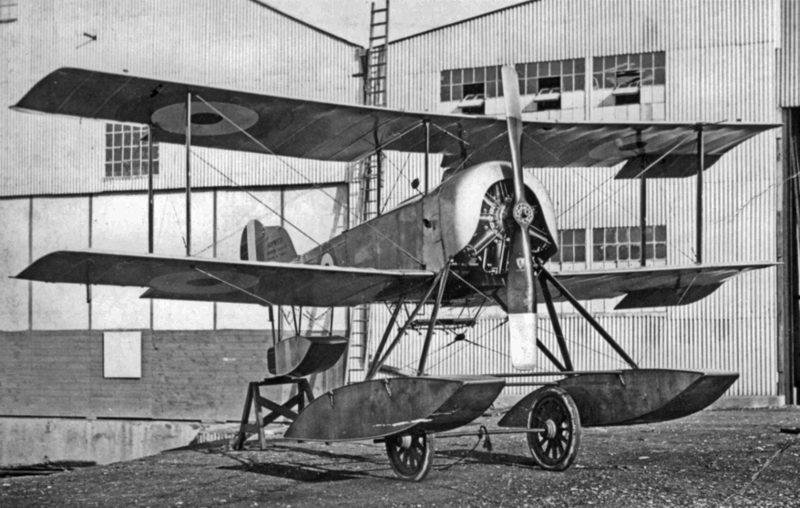
On 26th Sep tembe r sister floatplane No.8123 arrives at Grain from Woolston (right) looking very different to all previous small Sopwith floatplanes with a distinctive blunt nose and “horseshoe” cowl around the new 110hp Clerget 9Z rotary engine and a humped tail fin in place of the triangular one. This type is soon nicknamed the Sopwith “Baby”.
With more power, a detachable rear fuselage, internal flotation bag and provision for mounting a machine gun on the top wing it is significant advance on the “Schneider”.
Both the familiar straddle-mounted Gnome (left below with its propeller-shaft forward support bearing) and the new cantilever mounted Clerget (right below) take fuel into the revolving crankcase through the stationary crankshaft. However the Gnome has a ground-set fuel-air mixture whilst the Clerget allows some in-flight control over the mixture. It also has efficient conventional inlet valves rather than the Gnome’s inlet ports in the cylinder walls.
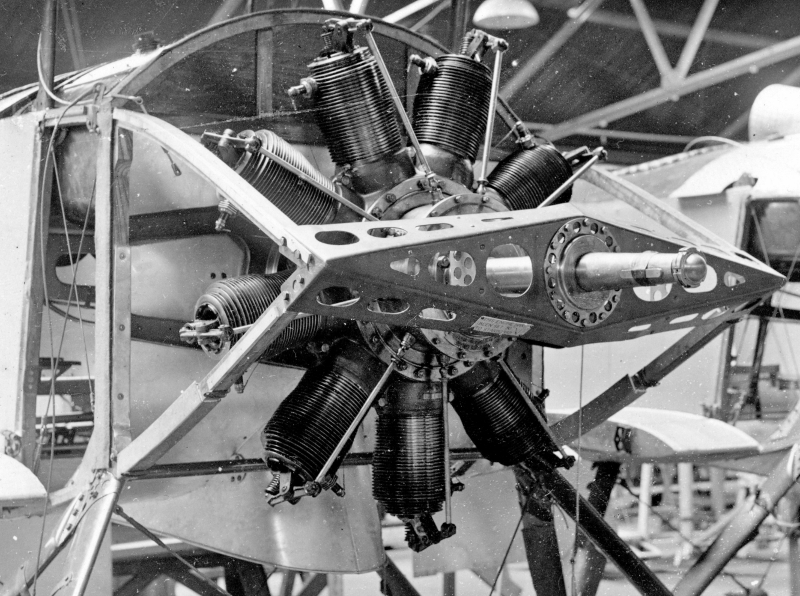
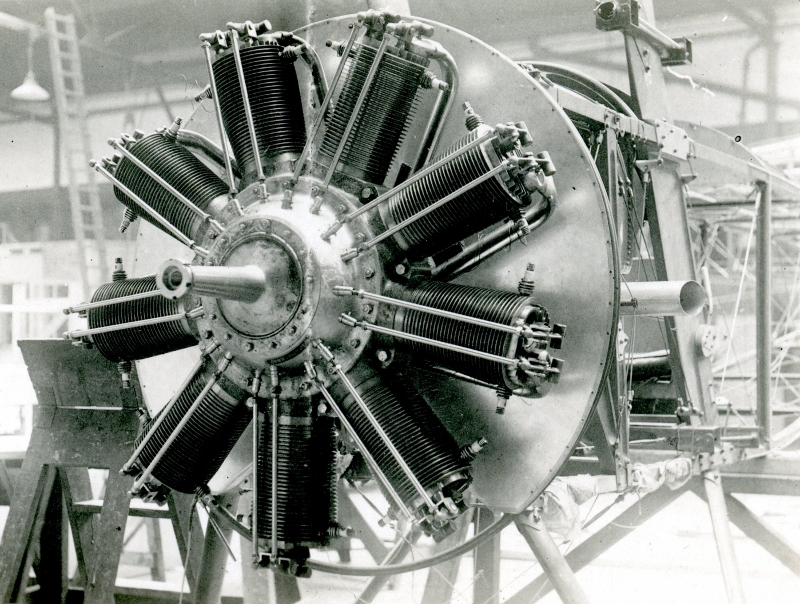
On 28th September “Schneider” Floatplanes Nos.3749, 3750 and the Gnome “Baby” No.8118 are tested and cleared by Harry Hawker at Grain. No.8118 is to remain at Grain for “special type trials”. Interestingly “Schneider” floatplane No.3742 delivered to White City Central Store Depot unassembled earlier in the month is on its way to the Port Victoria Aeroplane Repair Depot at Grain “for experimental development work”.
On 29th September Grain gets two more “Baby” floatplanes Nos.8119 & 8120 but both still have the 100hp Gnome engines as do the next two on the production line. The new Clerget engines are in short supply.
On 29th September “Schneider” floatplane No.1437 out in the Aegean suffers an engine failure whilst turning after take-off and Fl Lt C W Pulford makes a forced landing downwind. The aircraft overturns to be salved by the HMTrawler No.362. Pulford is unhurt but the aircraft will be deleted from service.
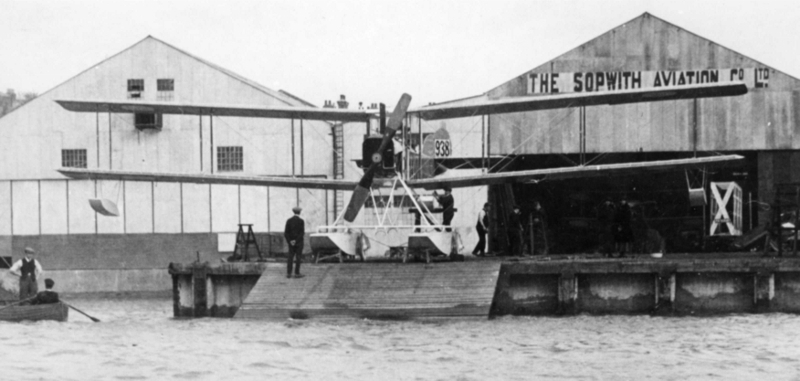
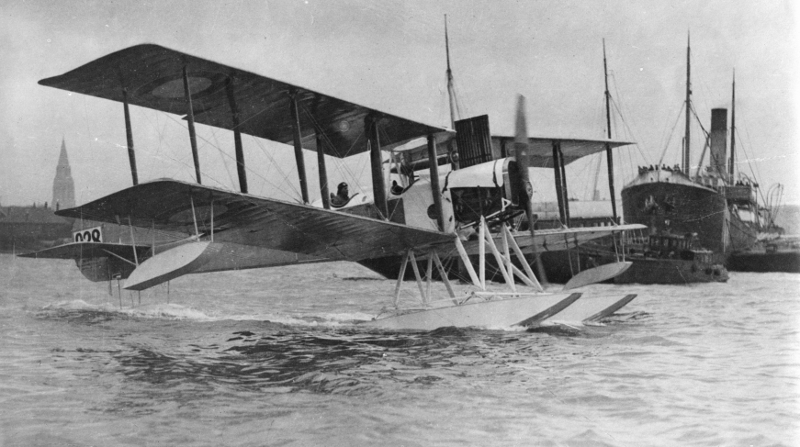
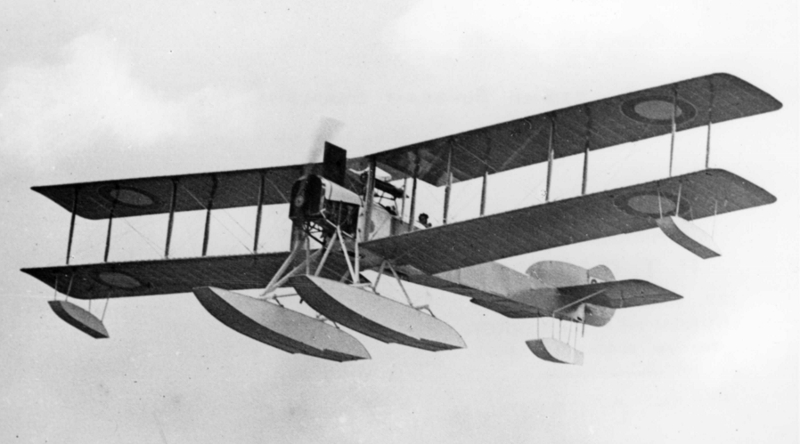
Around this time Sopwith start flying their newest “Type 860” large floatplane No.938 from Woolston (above) with full-span lower wings. They must be hoping that these latest improvements, and Sunbeam’s latest version of their V12 225hp engine, will at last make this design fully acceptable to the RNAS. There are three of these large floatplanes waiting at Woolston which have never passed their initial acceptance tests: Nos.932, 934 & 933 and these have recently been joined by four machines dismantled and returned to Sopwith via the White City Central Store Depot from Yarmouth, Felixstowe, and Grain Naval Air Stations.
Meanwhile No.855 still at the White City Depot awaits the outcome of all this, as do the two which are on their way back from Ark Royal, No.929 at Dundee, Nos.853 & 935 at Grain plus at Calshot, Nos.856 & 851 the latter of which has been without an engine since May. Of the twenty built (twenty-one with the replacement of the crashed prototype) the only “Type 860” in use by the RNAS is No.852 on experimental work at Grain.
With this one new “Type 860” large floatplane and as many as sixteen “Schneider” and four “Baby” small floatplanes, it appears that the Sopwith factory has completed 21 aircraft in September which brings the calendar year-to-date total to 133 machines.
The end of September completes the first full 12 month financial year of the Sopwith Aviation Co Ltd during which some 164 aircraft have been built. With the addition of the wartime demand for spare parts total sales income looks to have reached over twice the average sales rate in the previous 11 month financial year. This growth has been achieved with efficient manufacturing and operating expenditure and there should be significant profits enabling Sopwith to continue to self-finance the factory expansion and set aside substantial reserve funds for experimental work and emergencies.
Aeroplane magazine’s C G Grey reports that Lang Propellers Ltd have “in fourteen weeks converted a cornfield just outside Weybridge to a brand new factory, one of the finest pieces of factory work I have seen”. “Numerous modern and novel machines have been set to work in airy, well lighted, well heated and attractive premises which replace their three previous works in Weybridge: ‘Riverside’ liable to flooding, ‘Townside’ and ‘Hillside’. The old factories closed down on a Thursday evening and when the 200 men arrived at 6.30 on Monday morning each had his place and his tools ready to start work.” The Sopwith Aviation board have supported Lang in this project with a £5,000 loan (c£½m in 2015) secured by debenture stock in the company.
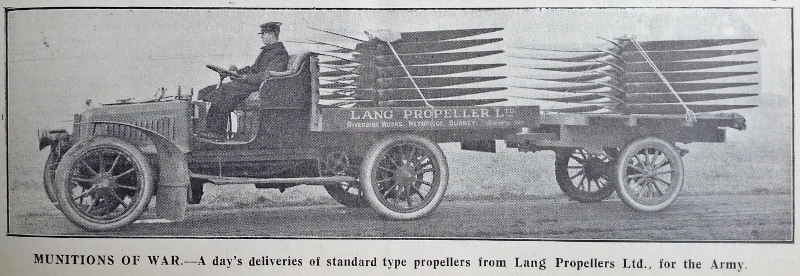
On 1st October Sopwith “SS3” Tabloid Scout landplanes Nos.1205 & 1206 arrive back in Britain from the Aegean on the SS Liverpool but are to be deleted. Only eight months since the first “SS3” Scout was delivered, just three of the twelve are still in service, two at Yarmouth and one at Eastchurch.
In contrast, the basically similar “Schneider” floatplanes are in demand. On 2nd October Nos.1577 is test flown from Ark Royal’s Imbros Depot in the Aegean as is No.3713 after repairs from being capsized back in August. Two more, Nos.1578 & 1579, are at the Imbros Depot awaiting erection.
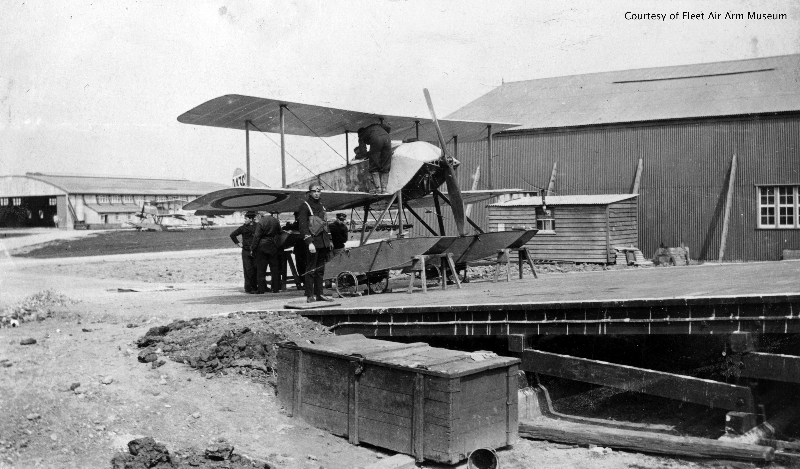
By 4th October “Schneider” No.3739 is fitted with an over-wing Lewis gun at Dover whilst the first “Schneider” No.1436 which has been at Grain since February (above), is in the Repair Depot acquiring some features of the new Sopwith “Baby” floatplanes. It will be ready to make a first test flight with ailerons in place of wing warping and a modified tail on 7 th October.
On 6th October “D3 Daily Mail Spinning Jenny” No.1069 flown by Sub-Lt A R Cox suffers more damage to wings, propeller and nose at East Fortune and is to be deleted whilst No.1058 has its engine removed at Yarmouth and is also unlikely to fly again.
Also on 6th October new “Schneider” No.3753 and Gnome engined “Baby” No.8121 are delivered to Dover followed on the 8Th October by “Schneider” No.3754.
On 9th October Grain based “Schneider” No.3750 operating from seaplane carrier HMS Vindex and flown by Fl Sub Lt J F Hay enters a sideslip and nosedives into the harbour. It is completely wrecked and will be deleted.
On 10th October Gnome engined “Baby” No.8122 reaches Felixstowe.
On 11th October “Schneider” No.3719 is wrecked at Bembridge whilst No.3726, reported “completely wrecked” in a fatal accident in August, arrives at Supermarine’s works next to Sopwith’s sheds at Woolston to be rebuilt.
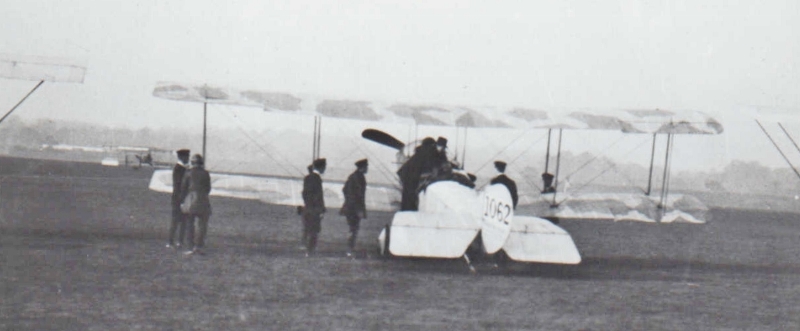
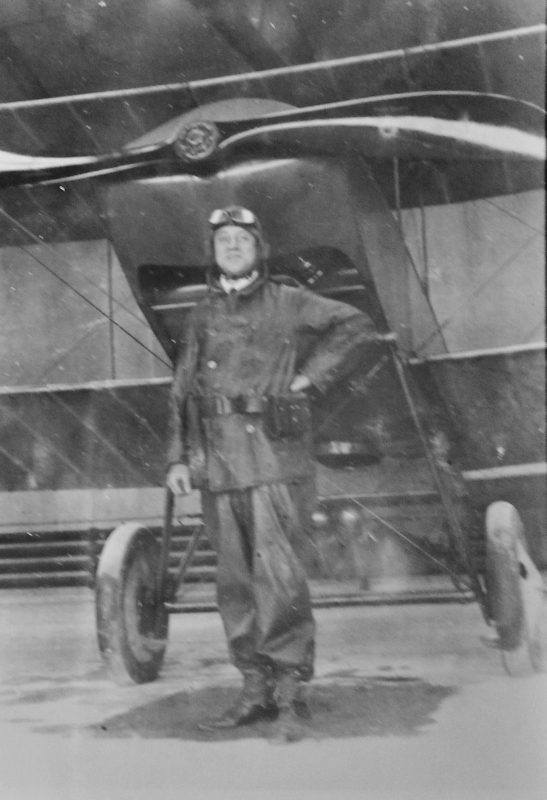
Despite No.1062 appearing at Chingford with experimental blotchy camouflage on its wings (above left) and another having been fitted with Rankin dart dropping drum (above right) the RNAS “D3 Daily Mail Spinning Jenny” landplanes are being withdrawn from front-line Air Stations and are no longer being used against Zeppelins.
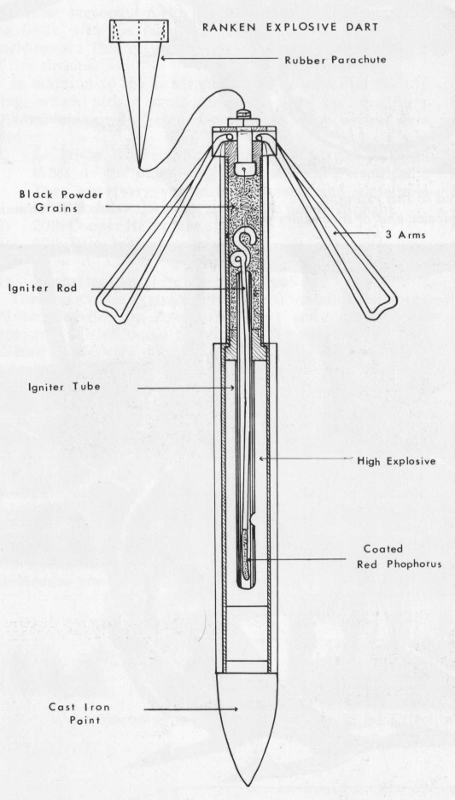
The 9inch long tin tube explosive darts (above) designed by Lt Cdr Francis Ranken RN have a cast iron point and at the other end an aluminium cap retaining three spring arms and a rubber over-cap which acts as a parachute when dropped. The sprung arms act as a grapnel on the skin of the airship whilst the body continues falling drawing the phosphorus igniter up the igniter tube to cause a flame which explodes the charge and causes a shower of sparks from the coarse black powder in the top designed to help ignite the hydrogen blowing through the burst fabric as it mixes with the air. 24 x 13 ounce darts in each container can be dropped in a sequence or together.
The RNAS has decided that it is useless to intercept Zeppelins from shore bases unless they are actually seen. They are however continuing with their routine deployment of “Schneider” floatplanes on dawn and dusk patrols, weather permitting, from a trawler far out in the North Sea. This is more in the hope of spotting and reporting Zeppelin movements than getting high or close enough to attack. (below: No.3715 being hoisted aboard HMT Jerico, Kingfisher or Sir John French at Yarmouth)
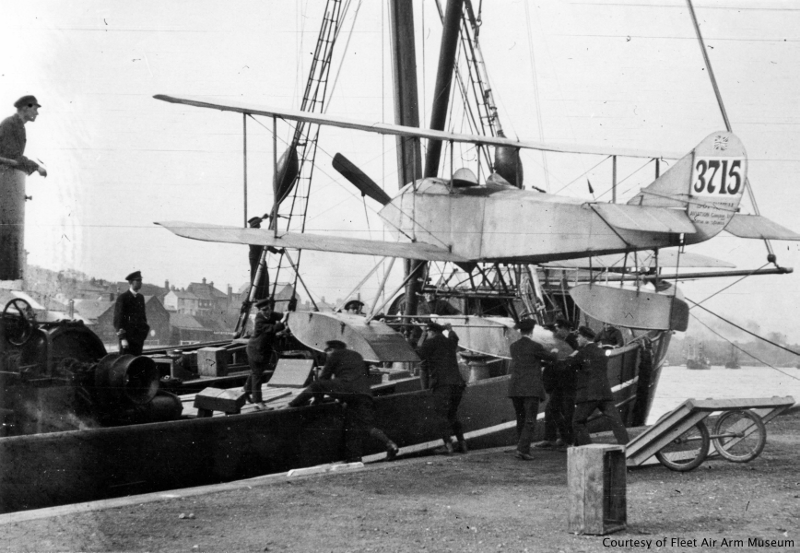
Lord Horatio Kitchener, Secretary of State for War, has insisted that the RFC join in the air defence of London despite Sir David Henderson’s protests that it is the Navy’s job to defend our shores. RFC airfields at Northolt, Joyce Green, Hainault Farm and Sutton’s Farm are now established along with coastal observers, communication links and more searchlights. The RFC have modified single-seat night-attack BE2c biplanes with extra fuel and under-wing bomb racks for eight 20 pounders. However, no machine guns are fitted, they take about 30 minutes to reach a typical Zeppelin raid height of 8,000 feet and only have a maximum speed advantage of 23 mph. The first test of the new defences is on 13th October when five German Navy Zeppelins raid London. Around 8pm the RFC stations are each ordered to send up a BE2c. L13 searching for Hampton Water Works and the Thames into London follows the River Wey and bombs Shalford near Guildford and then Woolwich, others bomb Tunbridge Wells, Croydon, Hertford and places in Kent and East Anglia. Only L15 finds Central London dropping 30 bombs between the Strand and Limehouse hitting the Lyceum Theatre, exploding a gas main in Wellington Street killing 17, hitting the Waldorf Hotel, Kingsway and the Inns of Court. It is illuminated by searchlight but there is no aircraft within 10 miles. Only two RFC pilots even see an airship and three of the six BE2c sorties that night end in aircraft being damaged landing in the dark in the poor visibility. With 71 dead, 128 injured and £80,000 damage this is the costliest airship raid so far.
On 14th October “Schneider” No.3751, delivered to Calshot two days ago, is tested by Harry Hawker with No.3752. That same day Nos.3755, 3756 & 3757 are delivered to Grain and No.3725 is damaged on take-off at Felixstowe. Fl Lt A W Clemson is unhurt but that aircraft will have to be deleted.
On 17th October new “Schneider” floatplanes Nos. 3758 & 3759 are delivered to Grain whilst No.3718 which only arrived there two days ago from Dover is wrecked and “landed from a lighter”. It will be deleted.
On 19th October Harry Hawker is at RNAS Isle of Grain Air Station testing new Sopwith “Schneider” floatplanes Nos.3755, 3756 & 3757. On 20th October it is the turn of Nos.3758 & 3959 at Grain before he travels down to Dover to test new Gnome engined “Baby” No.8121 and the next day at Dover tests new “Schneider” floatplanes Nos.3753 & 3754. On 24th October “Schneider” No.3760 is tested at Grain.
It is easy to understand how Harry Hawker could make use of an aerial runabout again with all this travelling around the country. It is said that Harry drew the outline of his latest machine in chalk in full size on the wooden floor of the Skating Rink, the military priority for all more powerful engines forcing him to use a 50hp Gnome engine reported as salvaged from one of Tommy Sopwith’s early flying school machines. From that layout Harry and the Skating Rink team have built a new very lightweight design, the Sopwith SLTBP (also recorded as SL.T.BP and SL.T.B.P, possibly standing for Sopwith Light Tractor Biplane & soon dubbed the “Sparrow”). The rumour is that Harry Hawker has recently flown this machine from the Kingston Football Ground off Thorpe Road just north of Sopwith’s factory. There is certainly enough space to do that. One way or another, the SLTBP has reached the south-west corner of the Brooklands airfield and is photographed (below) between the Sopwith sheds and the farmhouse with some of the “Old Factory” workshop team.
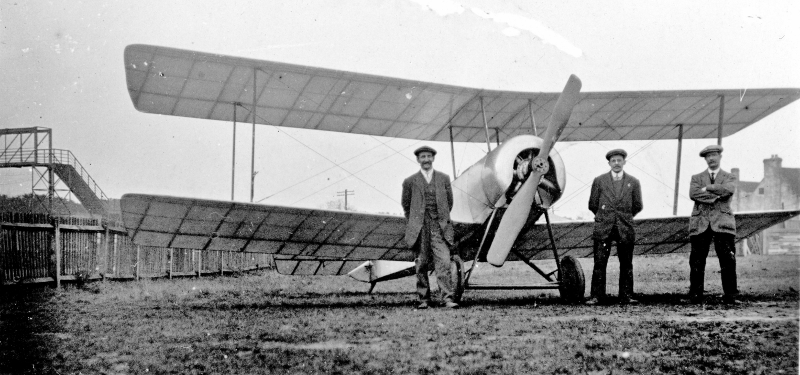
The 50hp Gnome engine is rear (cantilever) mounted and enclosed in a horseshoe cowl like the latest Sopwith “Baby” floatplanes. Its low power has led them to explore even lighter simpler construction than Harry’s earlier “St B” Tabloid. The thin interplane, cabane and undercarriage struts can be clearly seen as can the widely spaced delicate wing ribs beneath the clear doped linen. They have stayed with wing warping for simplicity, not ailerons and there is significant forward stagger to the top wing under which the pilot sits. Wings and tailplane have unusual shaped tips with a distinctive slightly curving reverse rake.
On 23rd October Calshot based Sopwith “Schneider” No.3741 is wrecked at Bembridge and “SS3” Tabloid Scout No.1210 is damaged at Eastchurch.
On 23rd October the Surrey Comet reports on a hearing in front of Kingston Mayor Alderman C H Burge at the Borough Bench where Harold Morse of 112 Richmond Road is summoned for wearing a badge authorised by the Admiralty for the use of the employees of the Sopwith Aviation Company. Special Constable and bootmaker William Southam saw Mr Morse wearing the Sopwith badge outside the Queen’s Head on 5th September after another witness saw him wearing it on 29th August. Sidney Goodenough Sopwith’s Chief Clerk states that Mr Morse worked there for 14 weeks to 21st December 1914 at which time the badge should have been given up or a two shilling fine paid and there was no record of either. The defendant said he had paid the fine but then took the badge back and got a refund. He went to work for a firm in Twickenham and claimed he was wearing their badge but the Magistrate was able to easily distinguish the two from 10 yards. Mr Morse is now working for the Posner Aviation Company. The case was adjourned due to the unexpected new evidence.
These badges were a result of pressure in the press and parliament for munitions workers to be recognised for their contribution to the war effort and not be accused by the public of shirking from joining the Armed Forces.
Sopwith Aviation Company has not taken any new aircraft orders since 31st May and has at most six months work on its books. However they have now acquired all 18 cottages on the south side of Elm Grove backing onto their works in Canbury Park Road and on 26th October they submit a further Sopwith factory expansion plan to Kingston Council on the site of the eight most easterly cottages, Nos.33 to 47. As before, the “Building Notice” is submitted by Architect & Surveyor A J Windybank of Clarence Chambers, 20 London Road, Kingston.
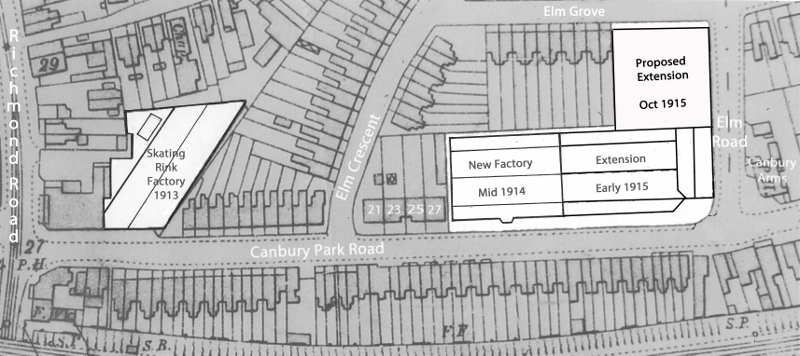
This is to be a two-storey steel framed workshop with brick outer walls heavily fenestrated to match the two-storey workshop already alongside Elm Road. This extension will add 20,000sq.ft of workshop space to Sopwith’s Kingston factories. The main 70ft by 114ft workshop area on the first floor has a large “open well” in the centre to let light into the 16ft 5in high large ground floor workshop from the roof light above. Along the north side there is a 24ft deep x 70ft wide garage with an open forecourt and a 24 x 44ft Tinsmith’s shop with a forecourt surrounded by a tall brick wall inside which is a “stoke hole” and stairs down to a basement coal store. Above the garage and Tinsmith’s shop is to be a 114ft long “Doping Shop” with roof ventilators and a “wing slipway”: a 30ft long 4ft wide “three section, hinged floor” ramp to ground level.
On 28th October Sopwith “Type 806” gunbus pusher No.802 rebuilt by Pemberton-Billing at Woolston since its fatal crash in June, arrives back at Hendon for erection. The next day sister machine No.805, dismantled in mid August, is sent by road from Hendon to the White City Central Storage Depot and is to be deleted.
On 31st October “SS3” Tabloid scout No.1211 (below) is deleted having been at Eastchurch since March 1915. Initially with RNAS No.2 Squadron, which became RNAS No.2 Wing in June when the RNAS changed its nomenclature, it has been with RNAS No.4 Wing since August. Confusingly, a “Wing” in the Royal Flying Corps is not a single squadron but several under one command.
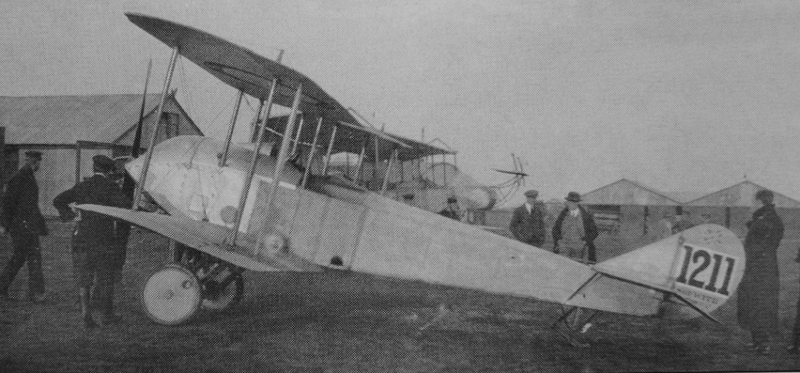
Also on 31st October 1915 “SS3” Tabloid scout No.1209 is recorded with RNAS No.3 Wing at Kephalo on Imbros. This machine was at Eastchurch and then St. Pol in France for a time before being shipped to the Dardanelles. It left Dover on 5th August on the SS Nankin and partially replaces Nos.1205 & 1206 recently returned home.
Only nine “Schneider” floatplanes and two Gnome engined “Baby” floatplanes have been recorded as delivered from the Sopwith factory during October 1915 compared with an average eighteen new machines in recent months. There are almost certainly a number of otherwise complete “Baby” floatplanes awaiting the arrival of their precious Admiralty free-issue 110hp Clerget engines.
On 3rd November 1915 I sabel Constance Webb records in her diary “Irene told me there was lots of excitement at the riverside today; a water-plane arrived from Sopwith’s. It was necessary to test it prior to setting it out to sea. There were several Royal Naval Flying Corps (sic) officers t o witness it, also Jack Hyland from Sopwith’s. Irene said the officers were very nice and looked at her a bit specially. The water-plane made several flights and poor baby was frightened when the machine came down. Hawker was the pilot.”
20 year old Isabel, known as Connie, is the eldest daughter of Edmund Webb an accountant with the Prudential Assurance Company. Irene and “baby” are her two younger sisters. The family home is Albany Park Lodge with a large garden (green on the map below) overlooking the River Thames next to Turks Albany Boathouse (yellow) where Sopwith are using the slipway. It is about half a mile from the factories in Canbury Park Road. (red). Nearby (marked in brown) is the Thorpe Road football ground from which uncorroborated reports say Harry Hawker has flown his new 50hp Sopwith “SLTBP” runabout.
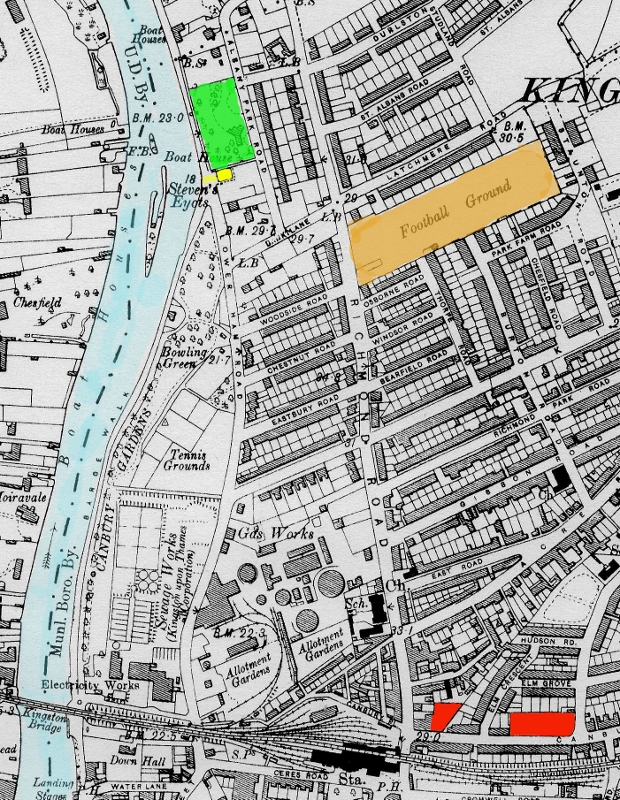
1911 Ordnance Survey map via Kingston History Centre
On 3rd November “Schneider” floatplanes Nos.1563 & 3707 on launching trollies are flown by Fl Lt W L Welsh and Fl Lt R E Penny from the foredeck platform on HMS Campania (below) with the ship steaming at around 20 knots. The next day the experiments continue. Welsh flies off No 3709 with 2¼ hours fuel and Penny flies off No.3707 with 2¼ hours fuel and 2x16lb bombs and later 4x16lb bombs. These are some of the last flights from Campania before she goes to Birkenhead for modifications which include the forefunnel divided into two to straddle a sloping, 45ft longer, foredeck ramp for launching heavier floatplanes.

On 6th November “Schneider” No.3754 transiting from Westgate to Grain Naval Air Stations suffers an engine failure. Fl Sub Lt O N Walmesley makes a forced landing near East Swale and the next day the machine is towed by motor boat from Leysdown to Grain.
In late September there were major French and British offensives in Champagne and around Loos in Artois. Little progress has been made despite 144,000 allied casualties. The Royal Flying Corps is in constant demand for vital reconnaissance and photography whilst directing the British heavy guns to save precious ammunition but is short of aircraft; a situation worsened by the innovative predatory Fokker Eindecker fighters with a synchronized forward-firing gun which are increasingly reaping havoc amongst the RFC’s vulnerable BE2Cs. Until he has something similar, Trenchard is forced to surround the BE2Cs with four or more single-seat scouts.
Following their centre of gravity experiments with the “Sigrist Bus”, a Sopwith team led by Herbert Smith are pressing ahead with a highly innovative machine with the pilot at the front and the observer behind the wing. This could carry an attacking forward-firing synchronised gun and a swivel mounted gun to protect the rear.
On 10th November Lord Kitchener, Secretary of State for War, visits Gallipoli to check the stalemate for himself after Sir Ian Hamilton has failed to sieze key Turkish held positions and has been replaced by Sir Charles Munro.
HMS Ark Royal has finally left the Aegean and is now deploying her floatplanes in the eastern Mediterranean.
On 11th November Sopwith “Schneider” No.3740 piloted by Fl Sub Lt L E R Murray is wrecked off Hamble buoy and will be going back to Sopwith at Woolston for repair, that same day No.3719 recently wrecked at Bembridge arrives next door at Pemberton Billing’s Supermarine Works for repair.
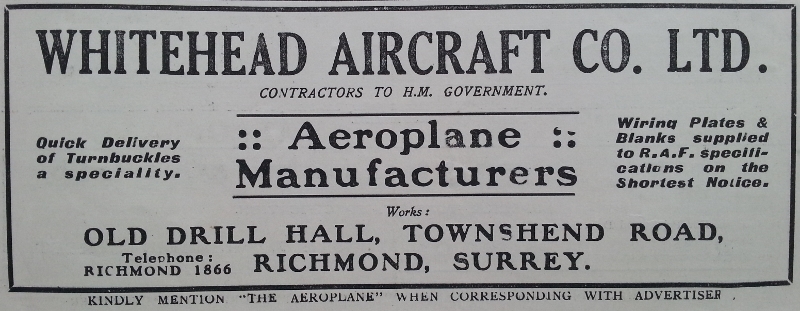
On 12th November the staff of the Whitehead Aircraft Co. entertain their Managing Director John A Whitehead to a dinner at the Castle Hotel in Richmond upon Thames to celebrate the completion of the first of a trial order for six BE2Bs for the RFC just four months after he took over the empty Drill Hall in Townshend Road. Like Sopwith in December 1912, Whitehead has found a ready-made factory in a town with skilled woodworkers. “Jack” Whitehead originally emigrated to the USA making and losing a fortune as a timber merchant. He came back to the UK working for AIRCO building Farman biplanes before “aspiring to build aircraft in a factory of his own”. Considering that Sopwith are just 3 miles away, it is worth noting that a regulation came into force in May 1915 banning employers “from taking any steps, directly or indirectly, by canvassing, advertisement or otherwise, to induce munitions workers to leave their present employment”.
On 14th November Harry Hawker is at Hendon demonstrating his new SLTBP runabout (below) with its distinctive rudder and fin shape with a vertical leading edge. Aeroplane magazine reports tersely but revealingly: “Mr H Hawker on 50hp Gnome Sopwith, speed 22mph to 84.6mph, 6 loops, tea, 6 more with tail slides, nose dives etc. and home”. If true, 84.6mph is a remarkable speed from 50 horse-power.
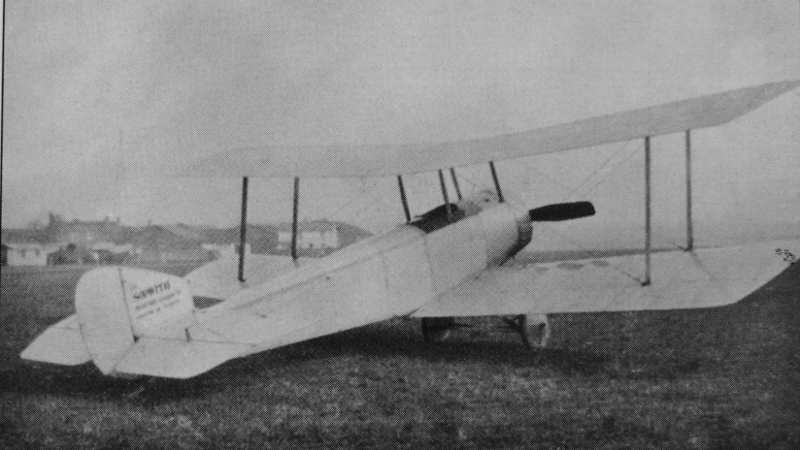
Harry is obviously happy with his new mount and keen to demonstrate it to the public and to Sopwith colleagues, Messrs Watson and Ridley. 18-year-old Basil George Watson was so impressed with Harry Hawker’s “Tabloid” demonstrations in Australia in early 1914 that he accompanied Harry back to England. He got a job with Sopwith Aviation which has involved some flying but he was hurt in a crash on 22nd June 1915. Just three weeks ago Basil obtained his own aviator’s certificate No.1910 at the Hall School of Flying at Hendon and has now been appointed by Sopwith Aviation “to put new machines through their tests” to relieve Harry Hawker of some of that workload.
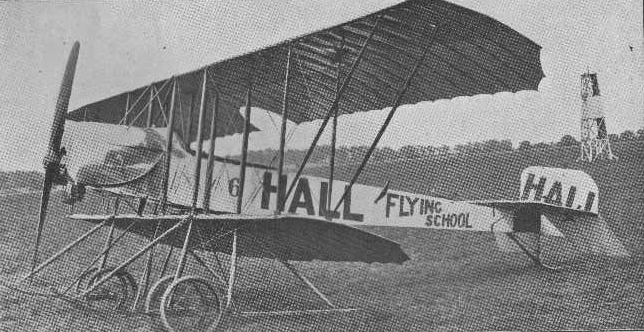
The Hall Flying School established at the end of 1913 is one of several civilian schools allowed to continue to operate at Hendon in wartime to supplement the supply of pilots from RFC and RNAS training schools. During 1915 Hall have been building their own training aircraft (above) with Caudron-type sesquiplane wings. Also using a 50hp Gnome engine these appear crude and outdated in comparison with Hawker’s aerodynamically clean and sleek SLTBP runabout.

